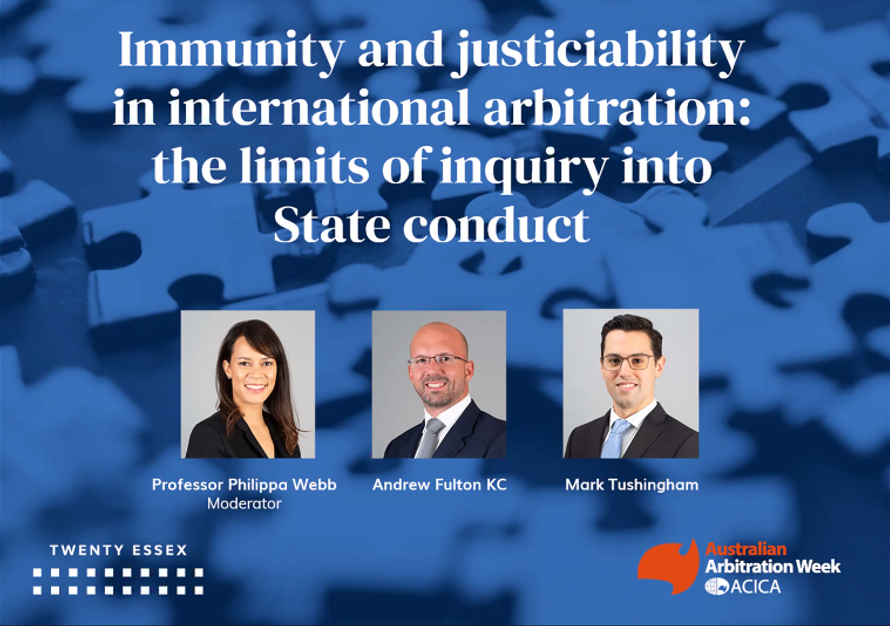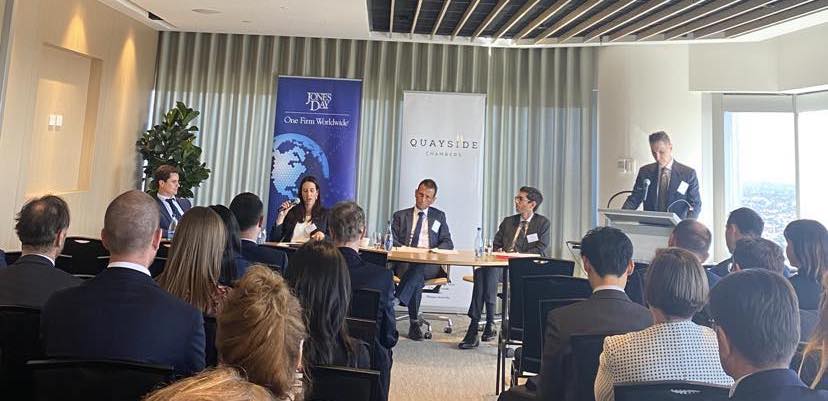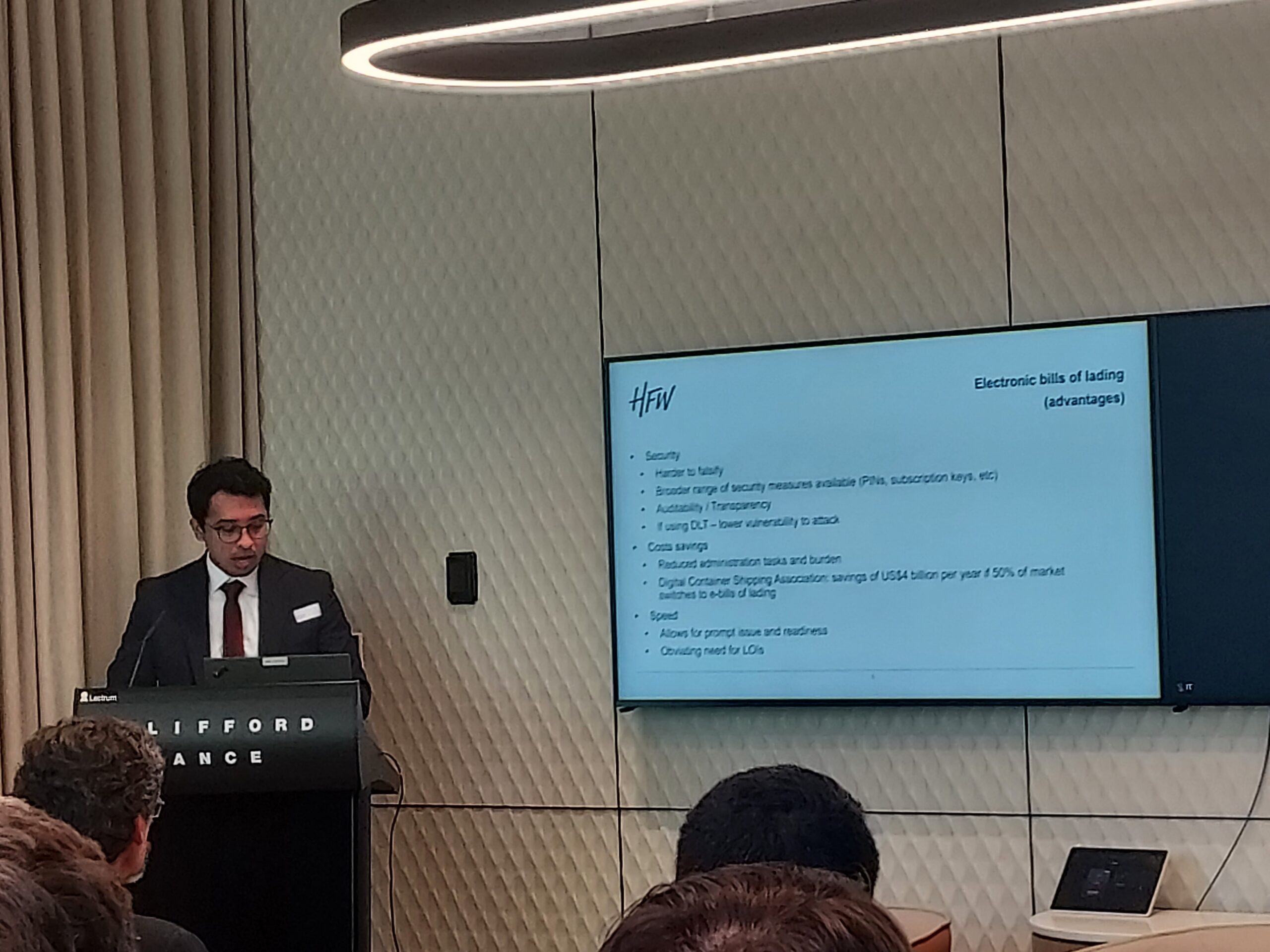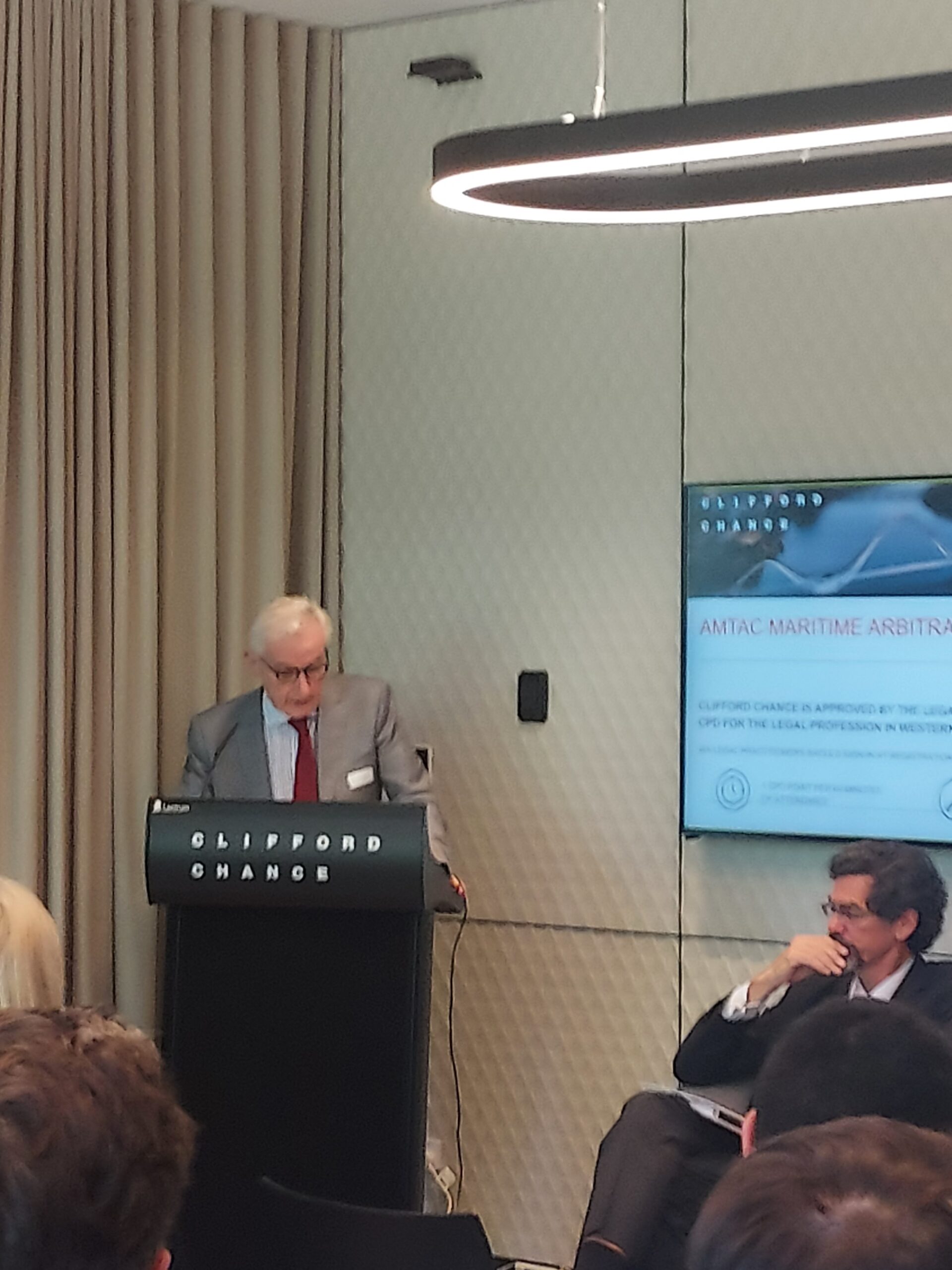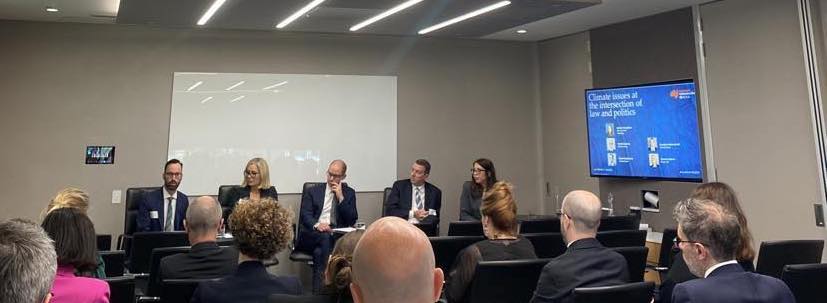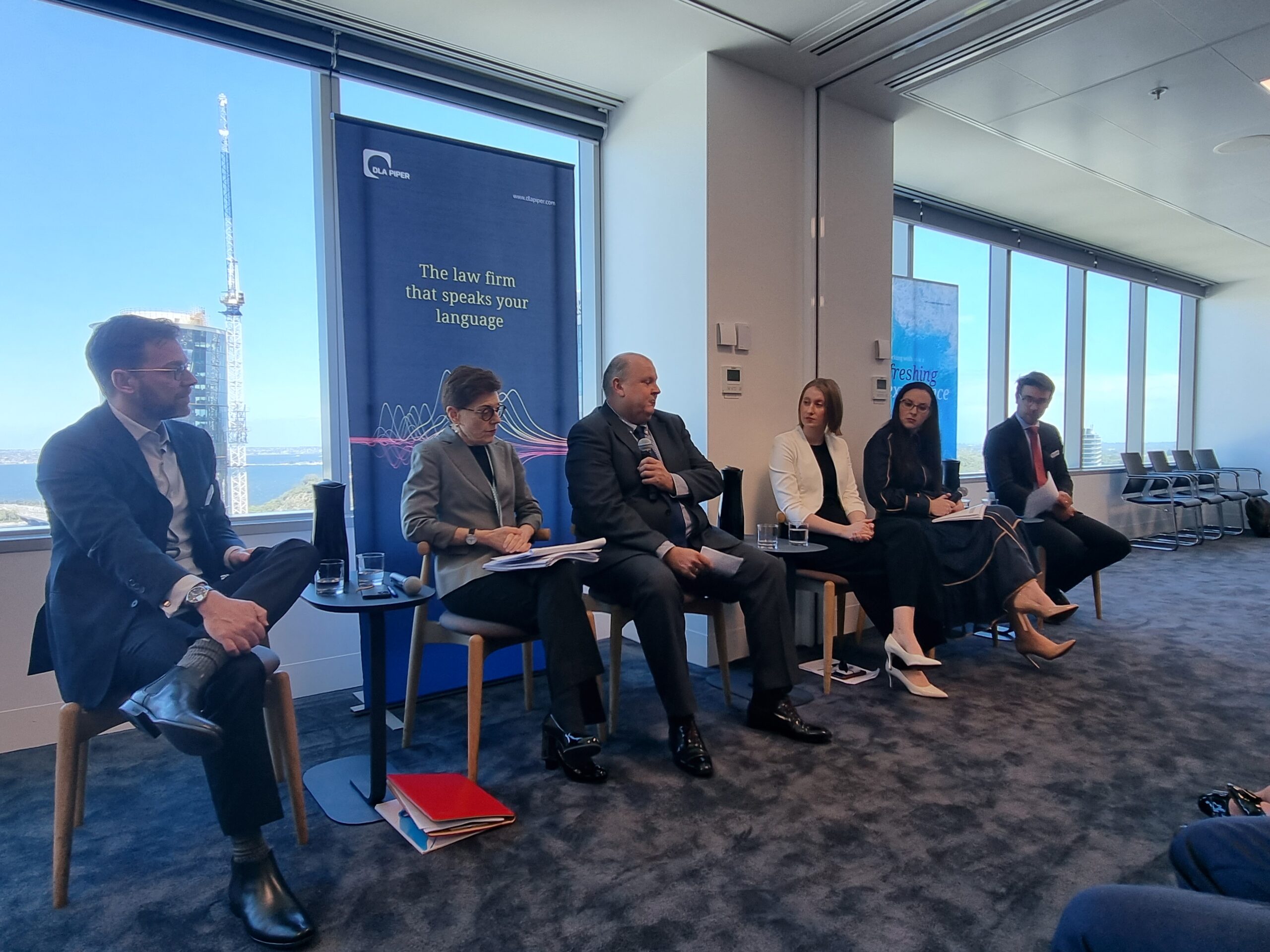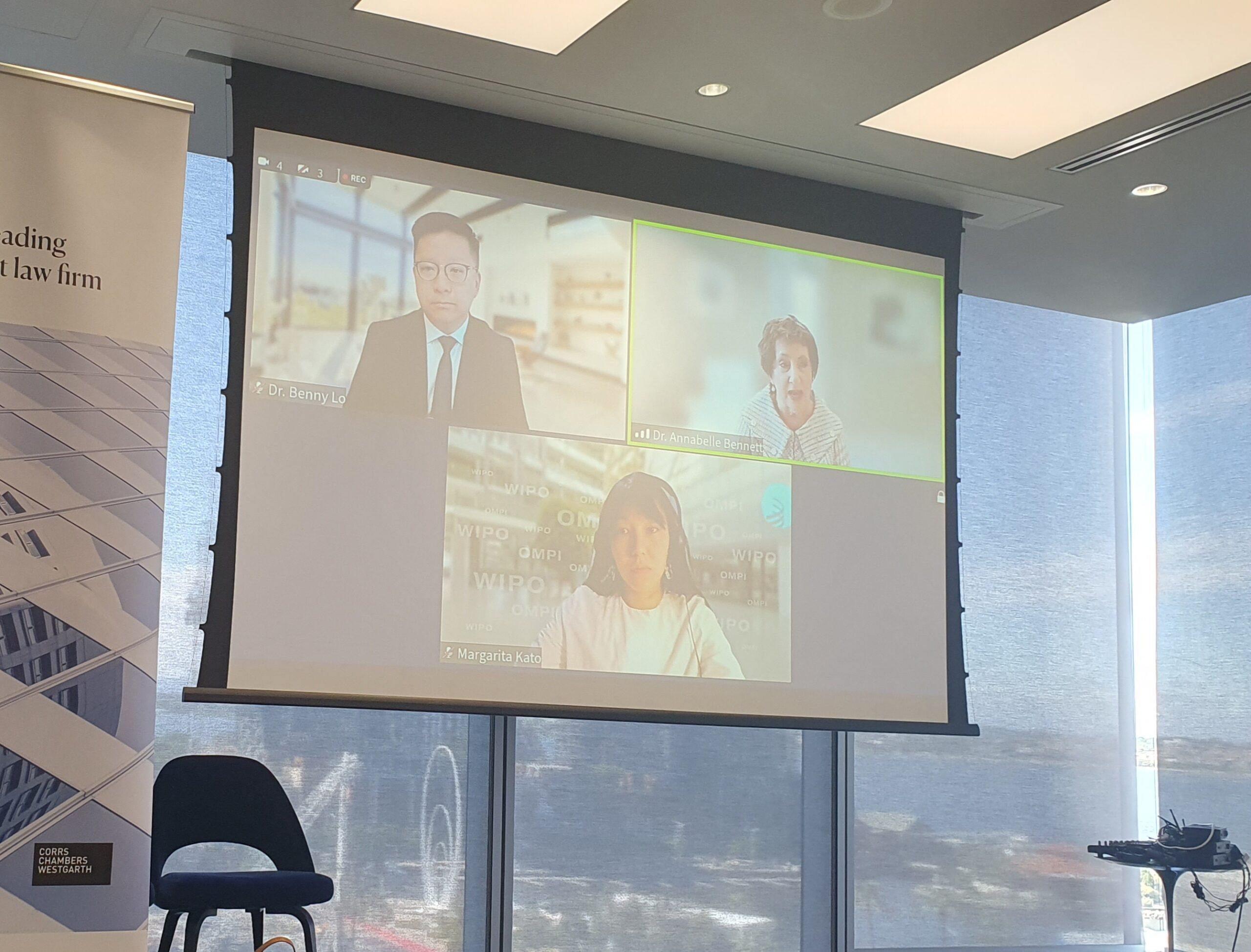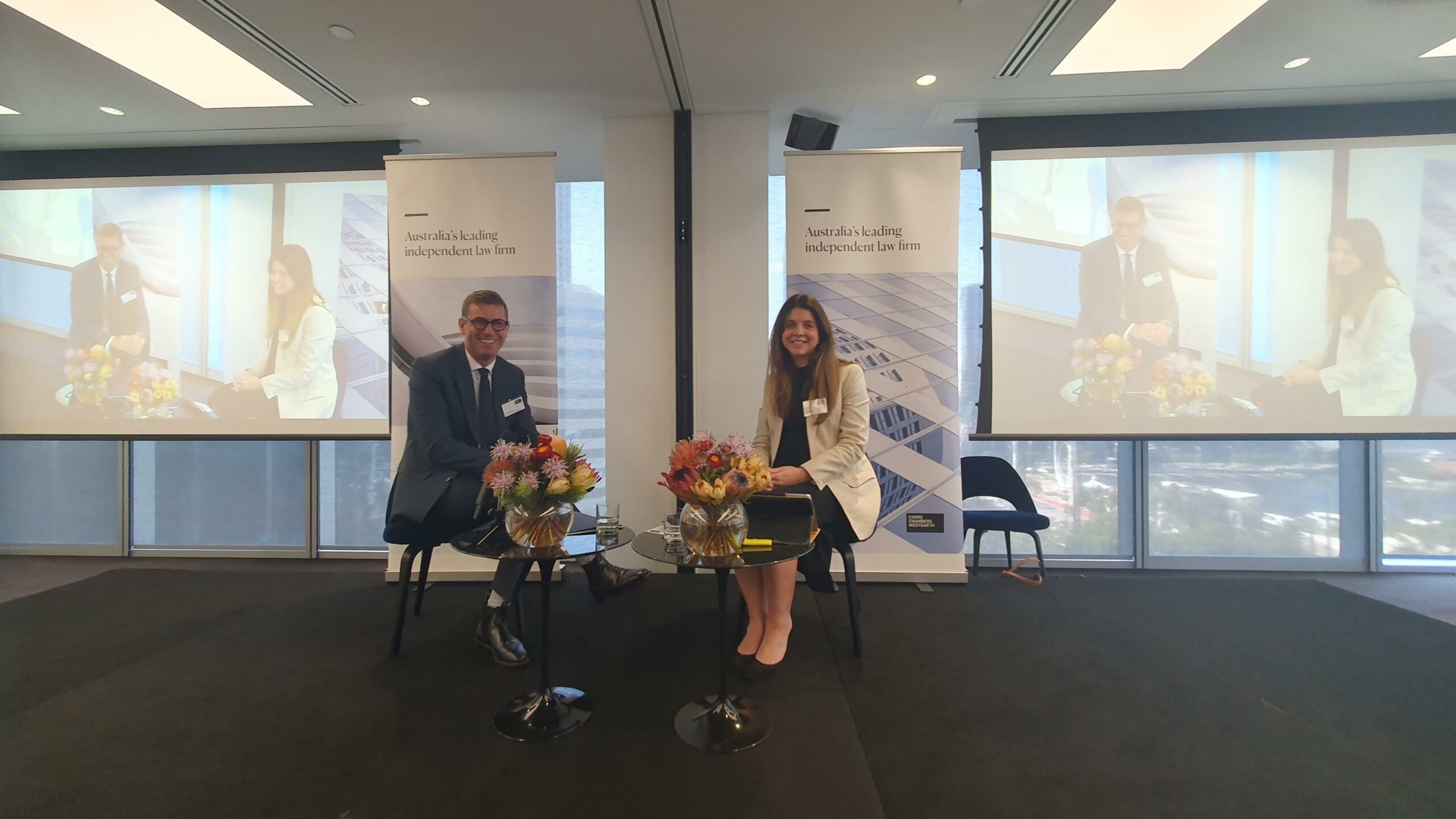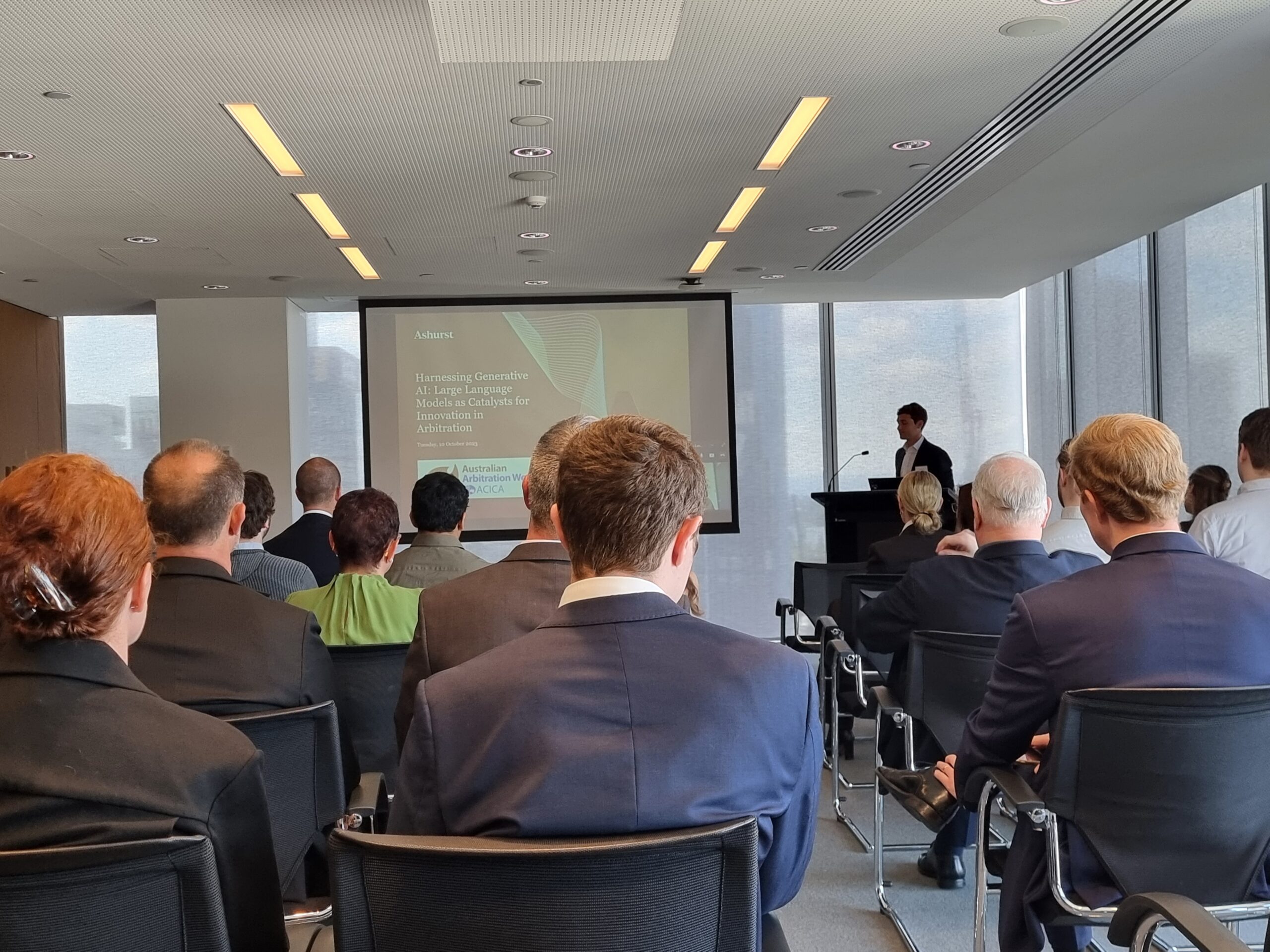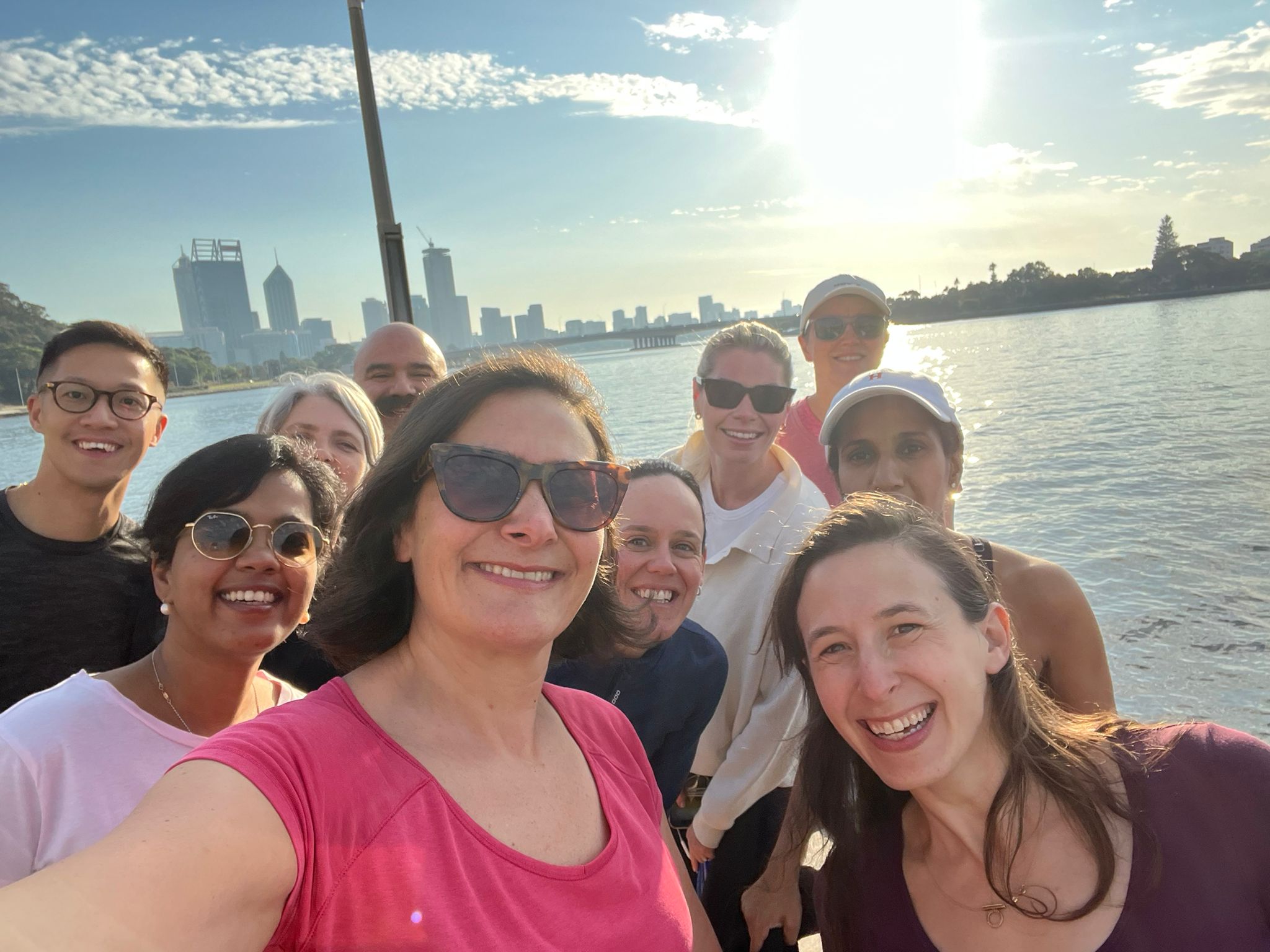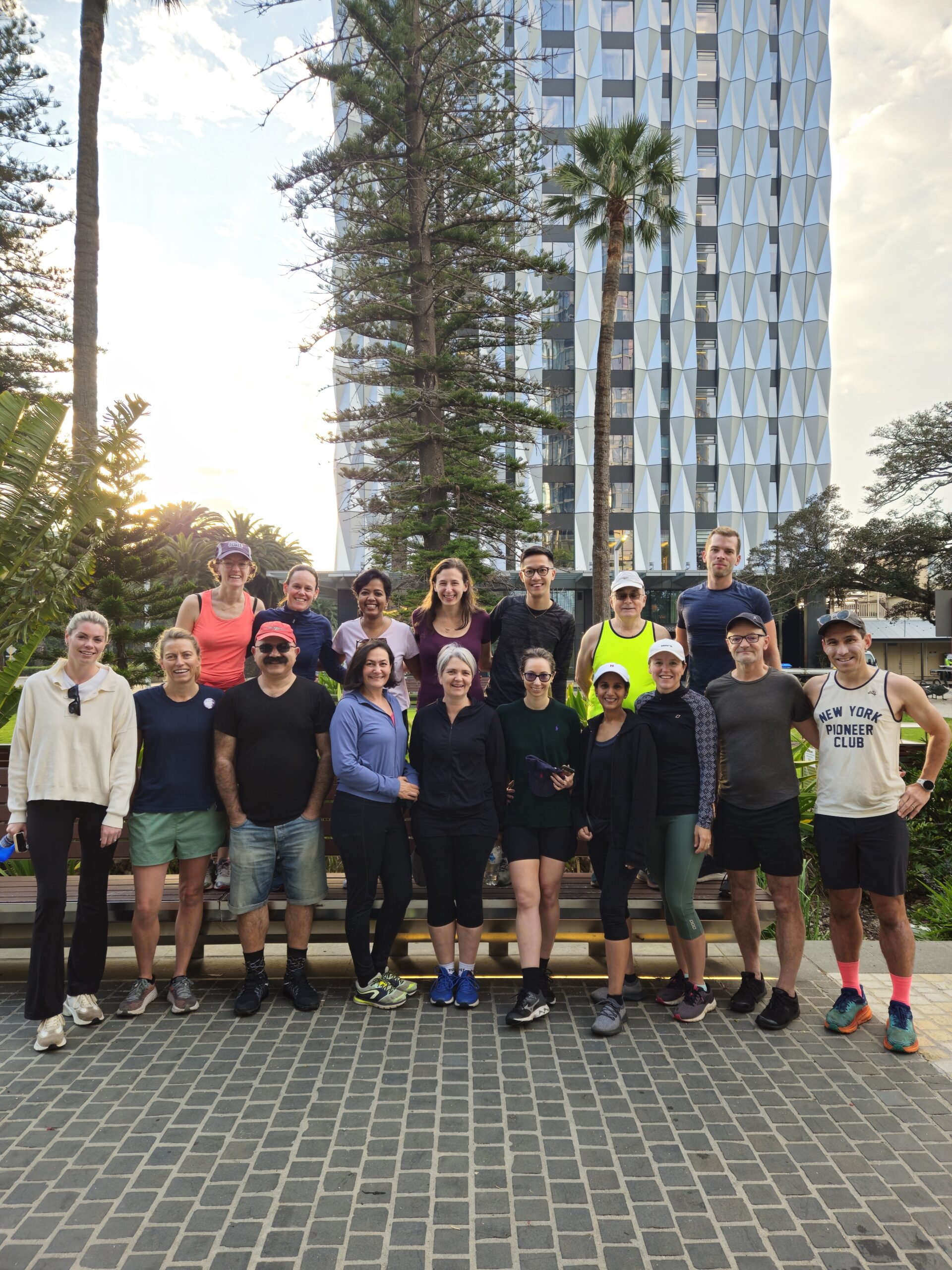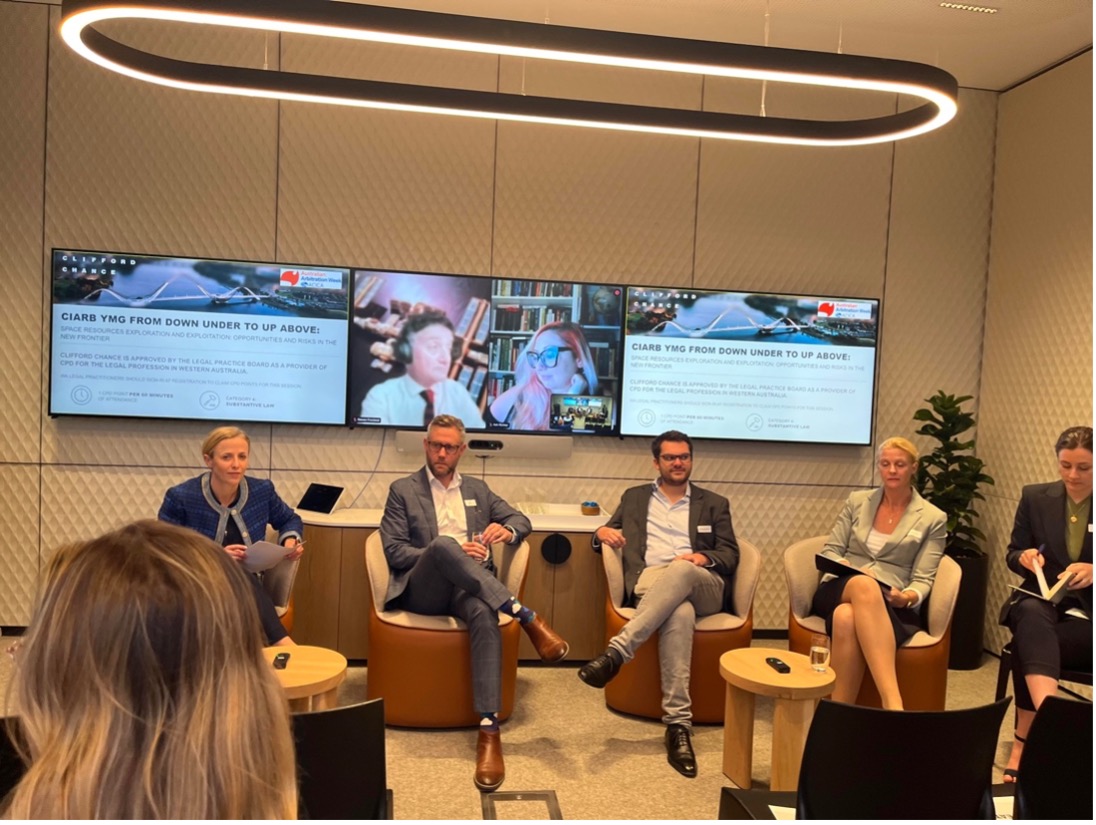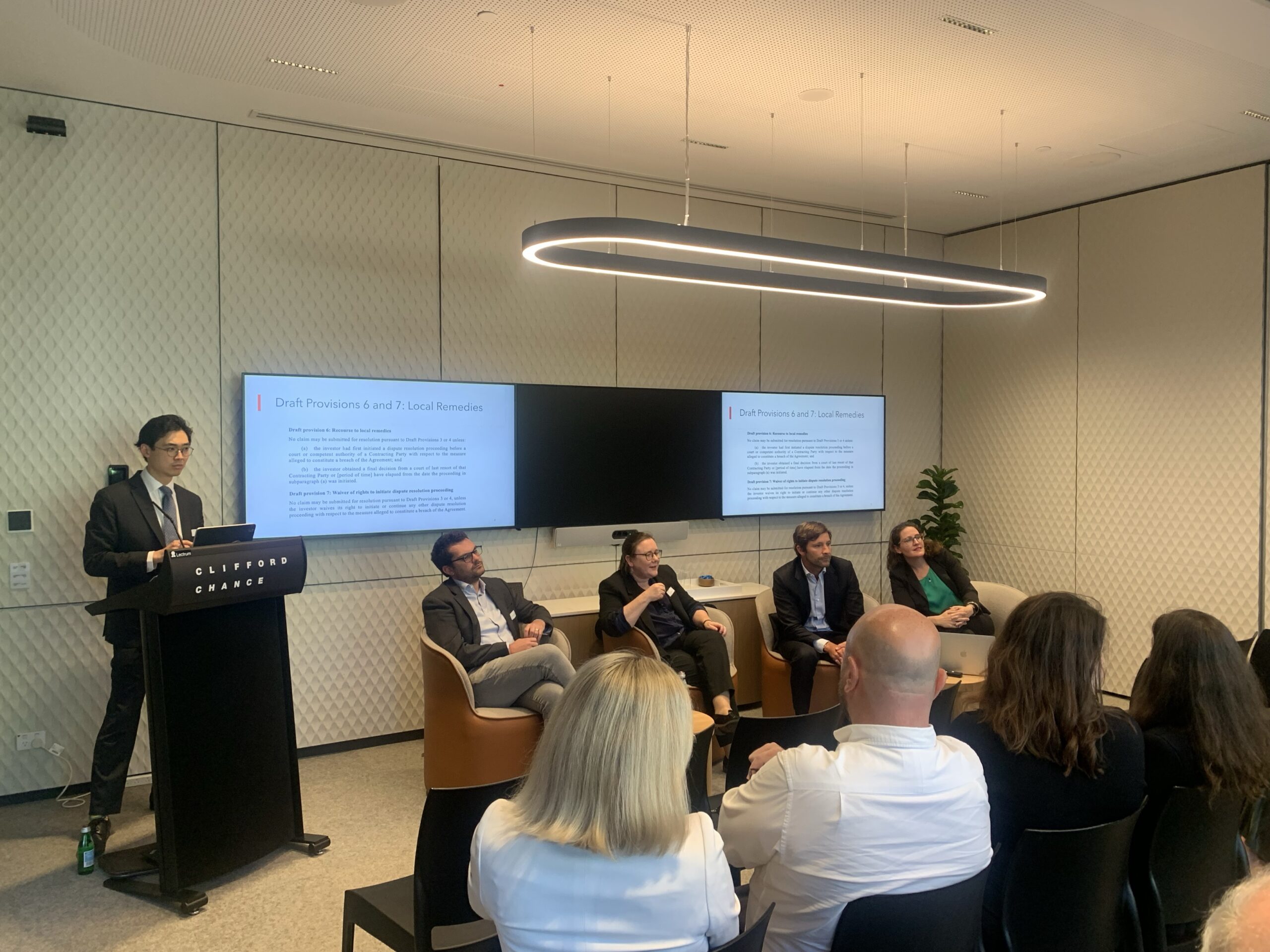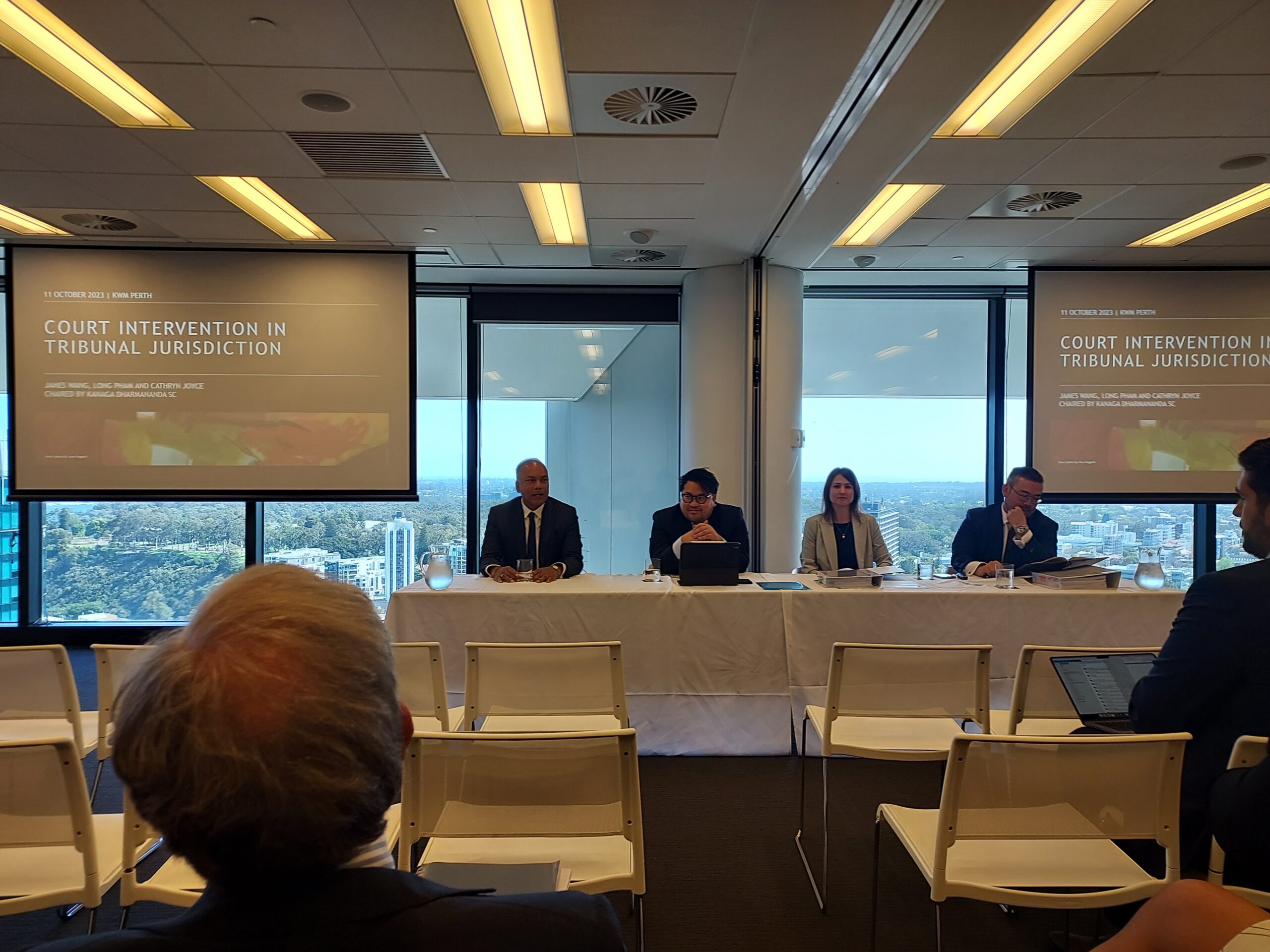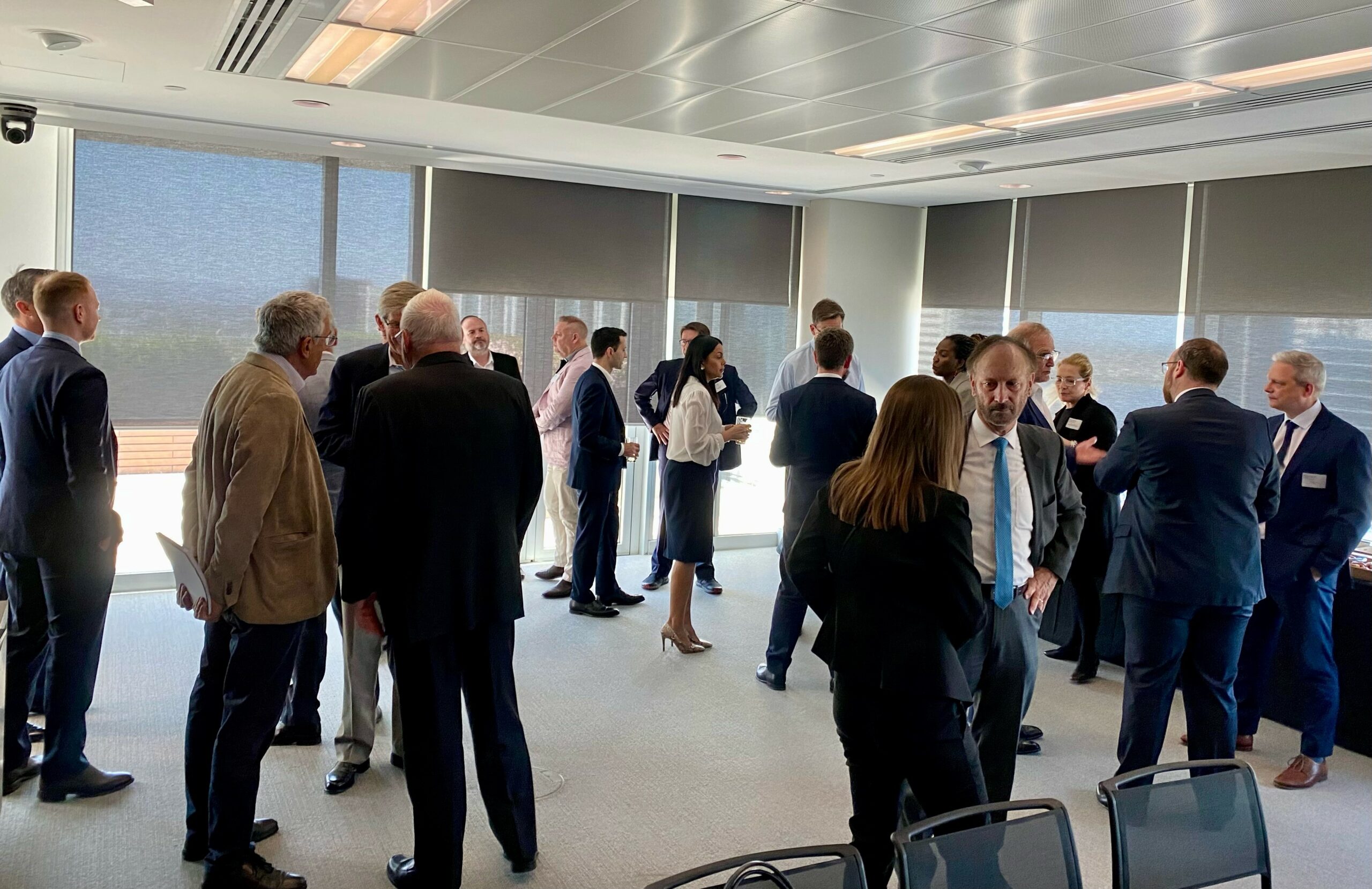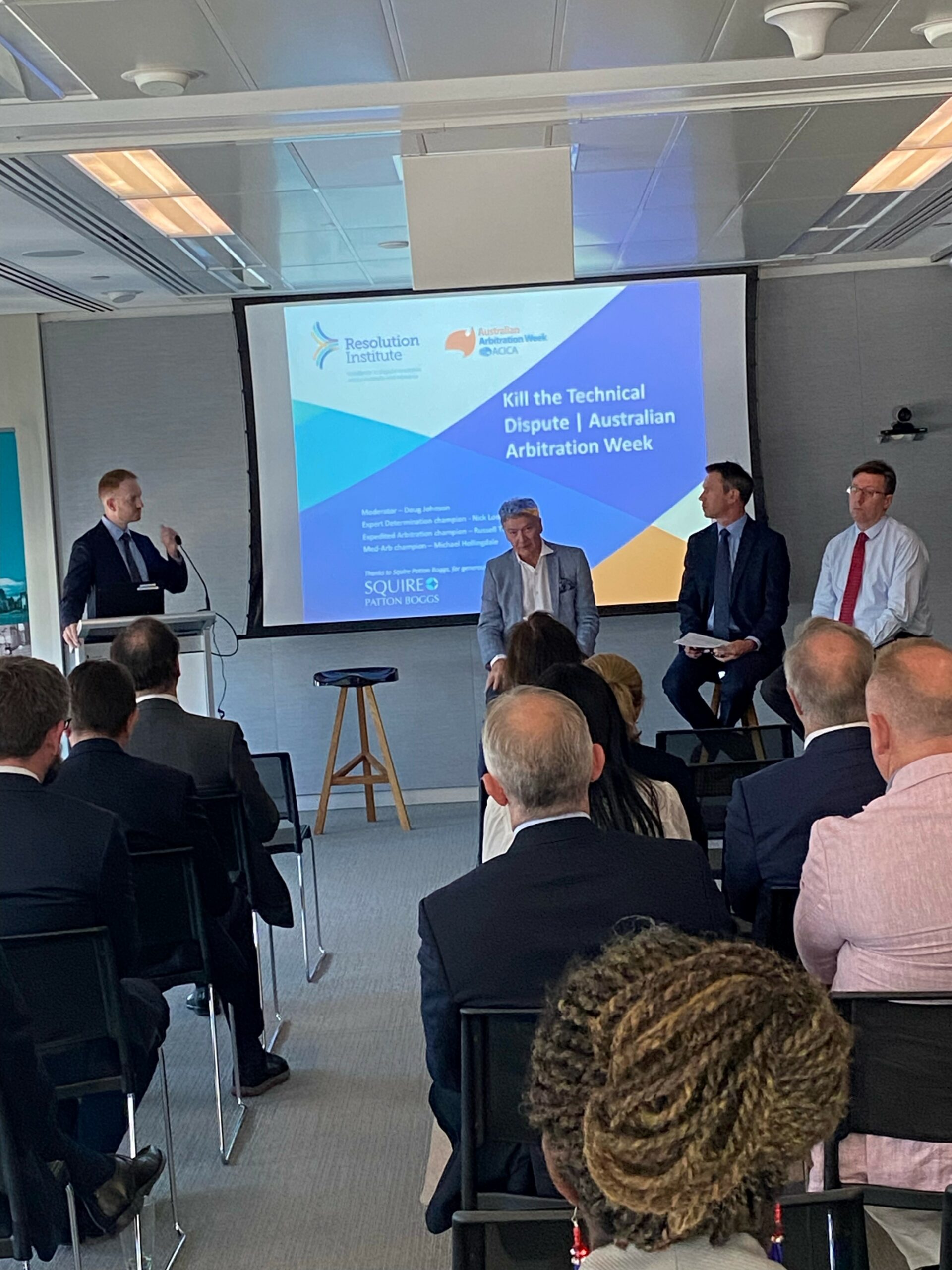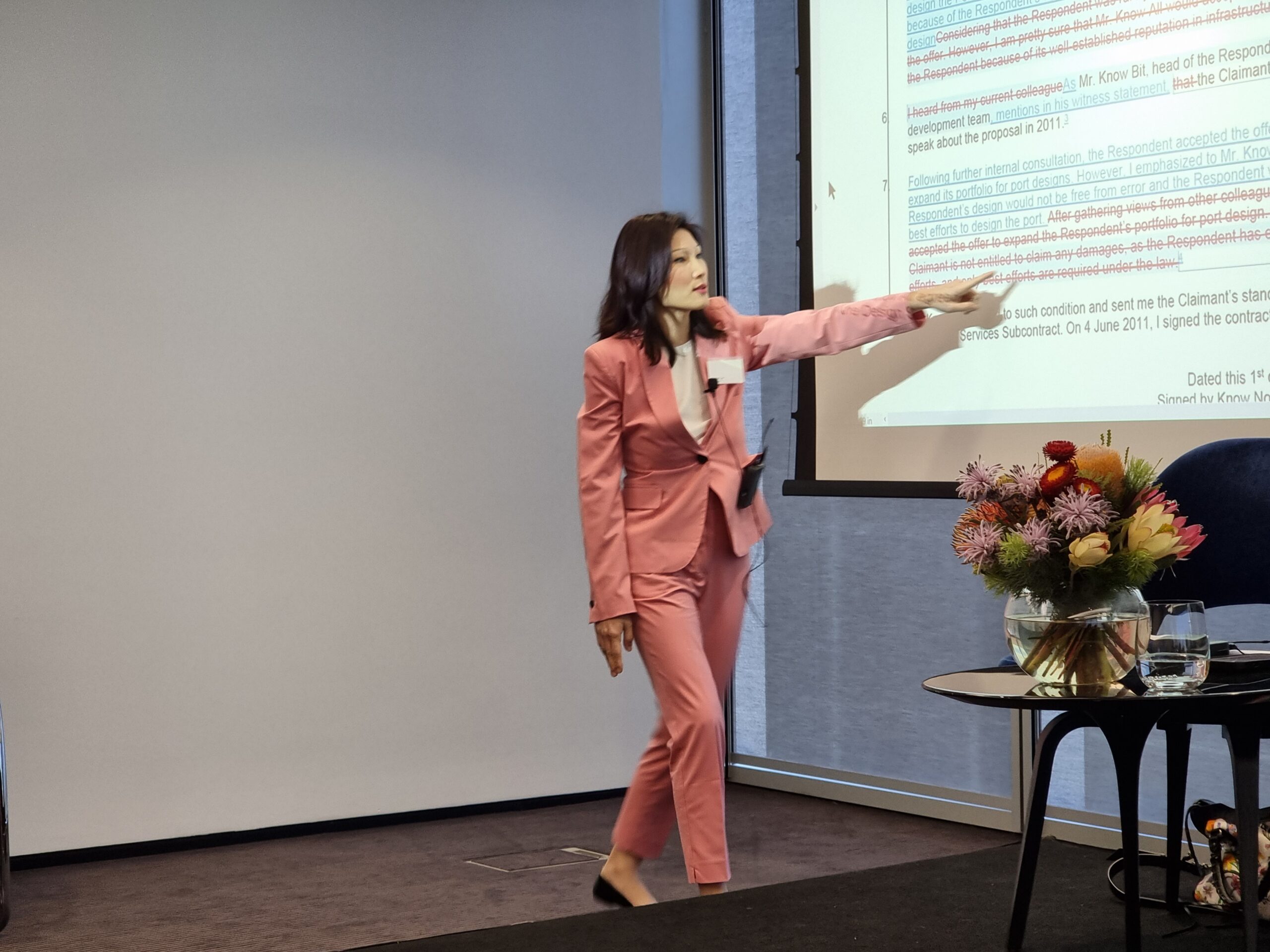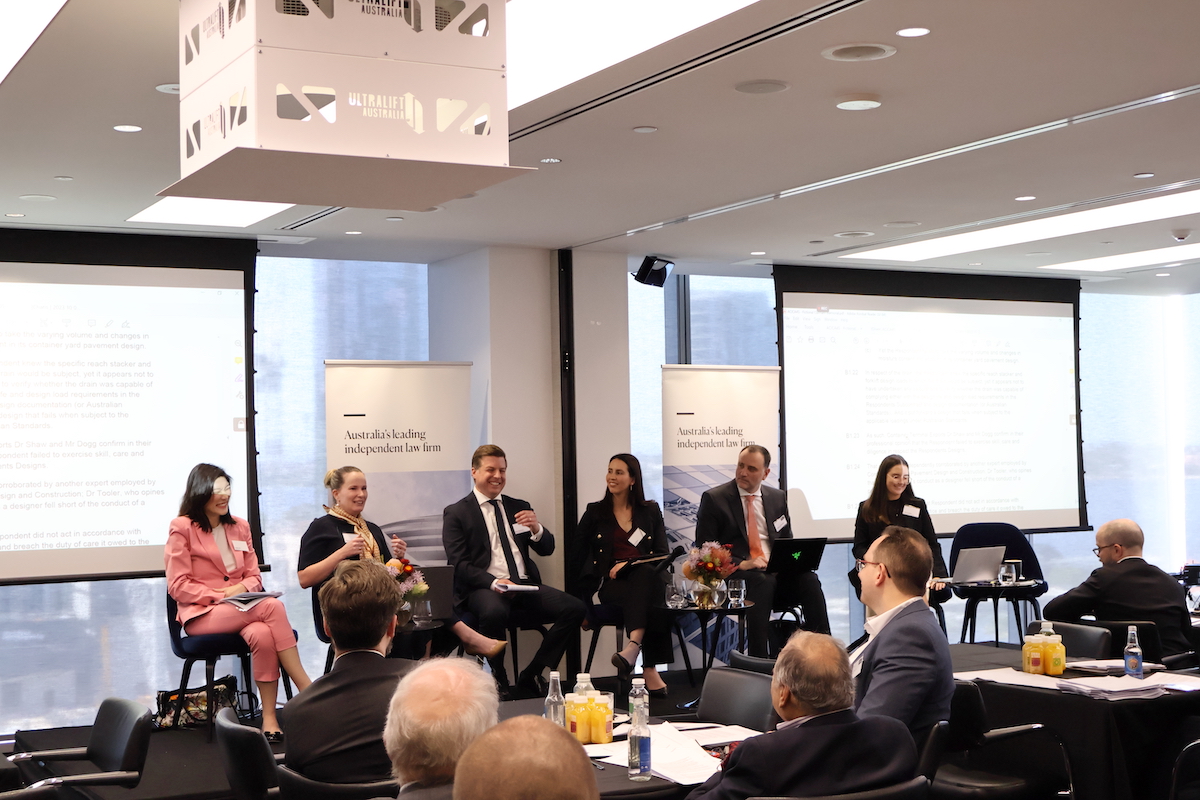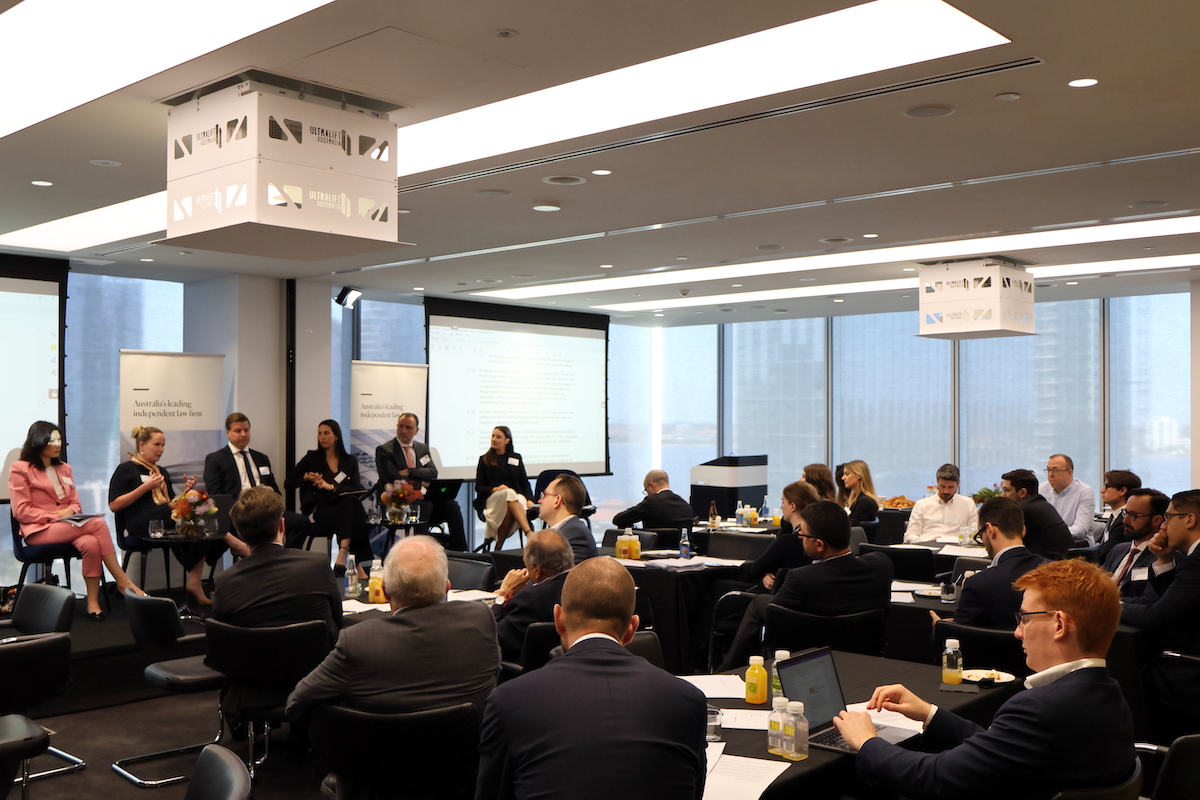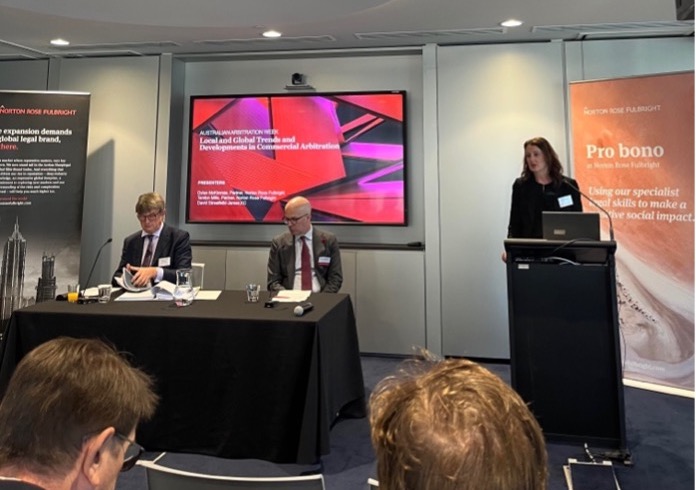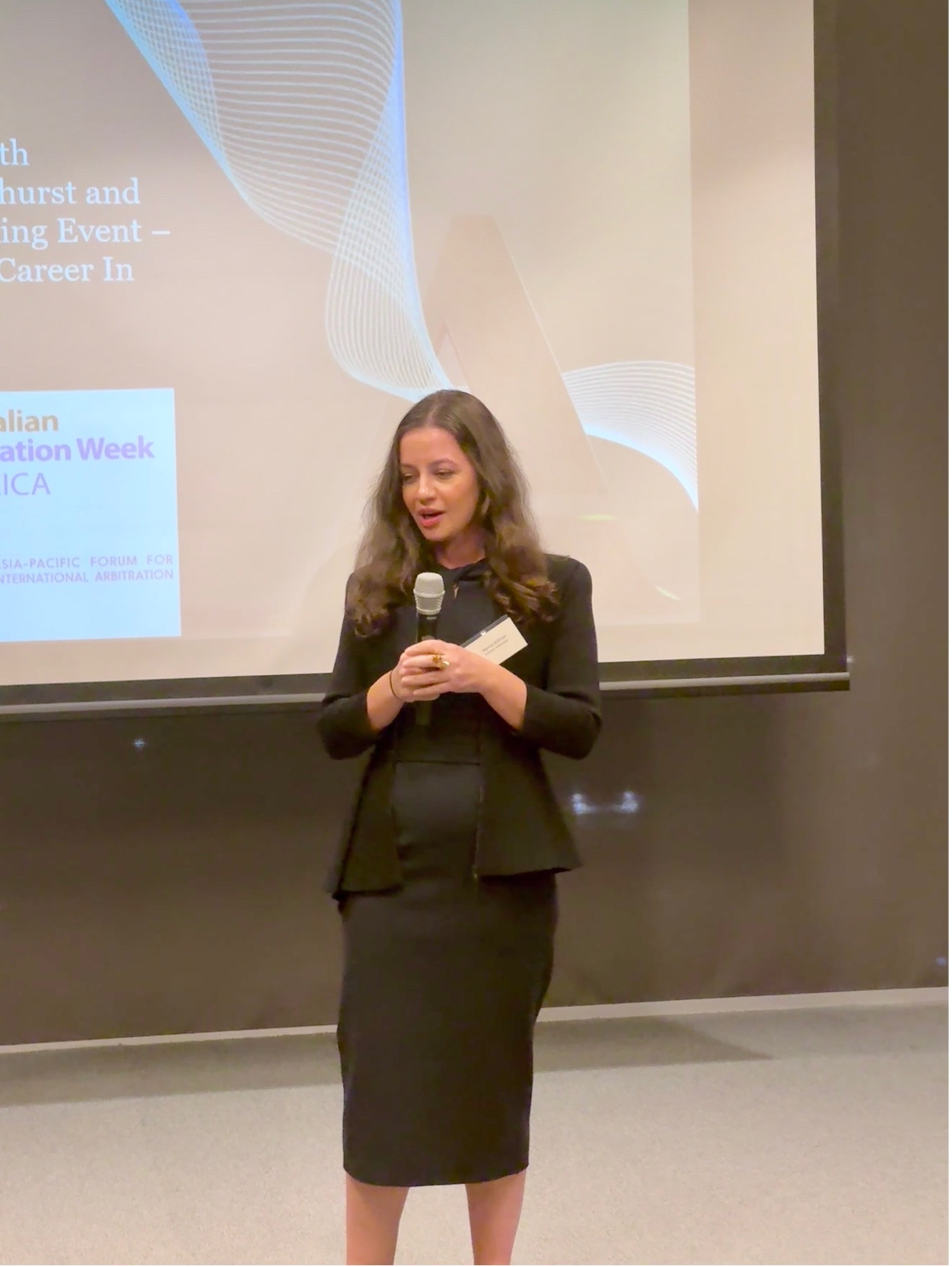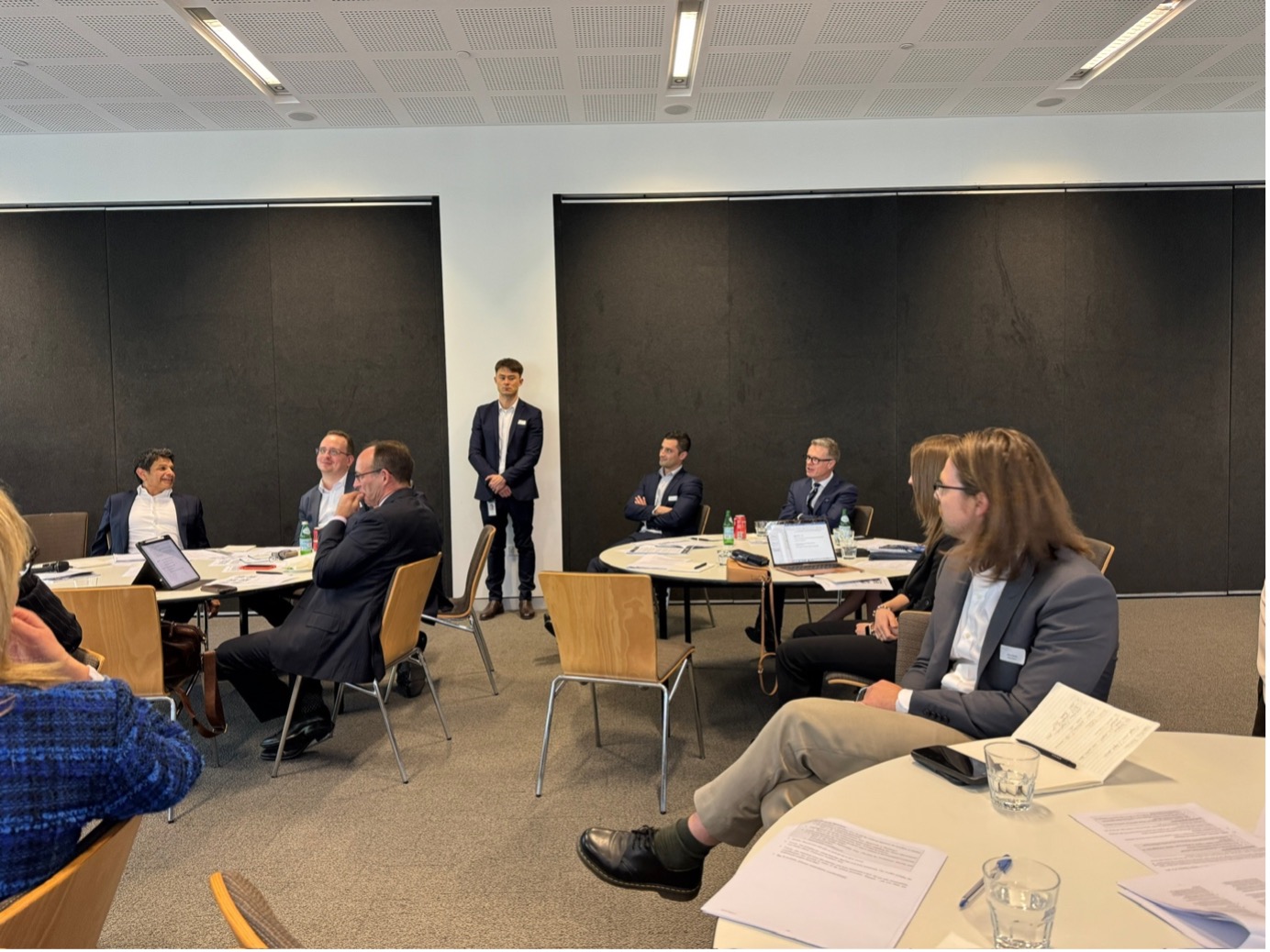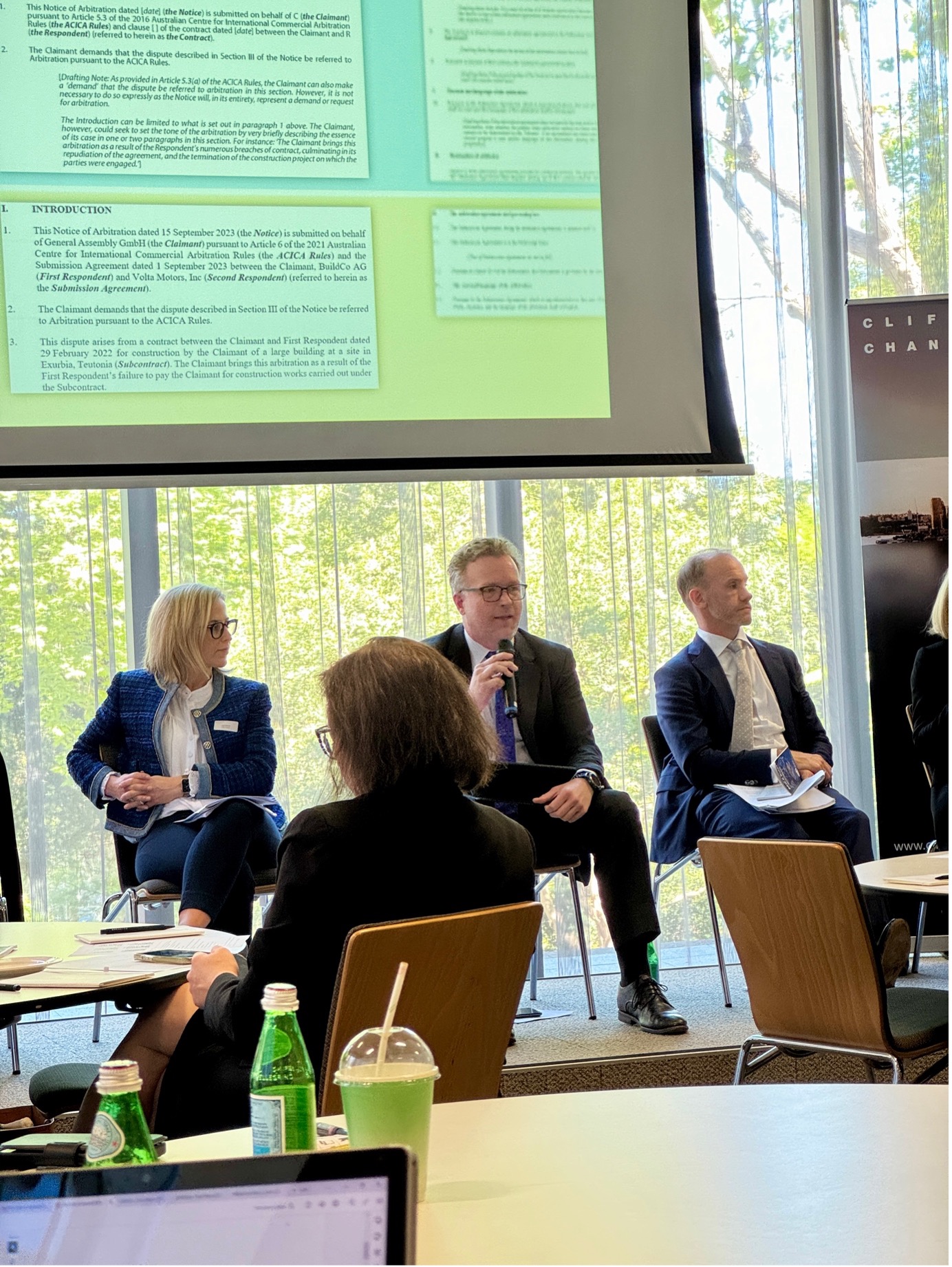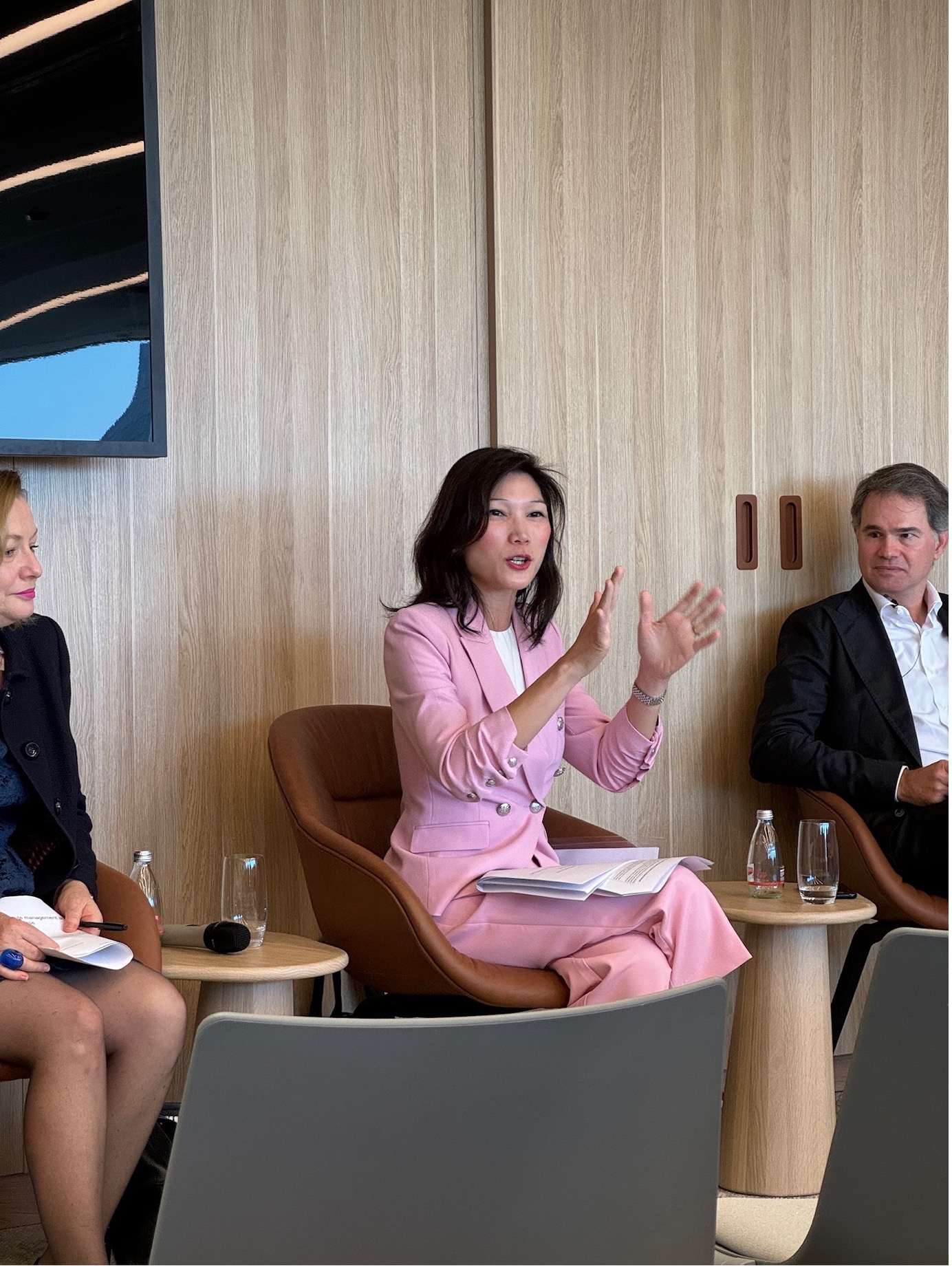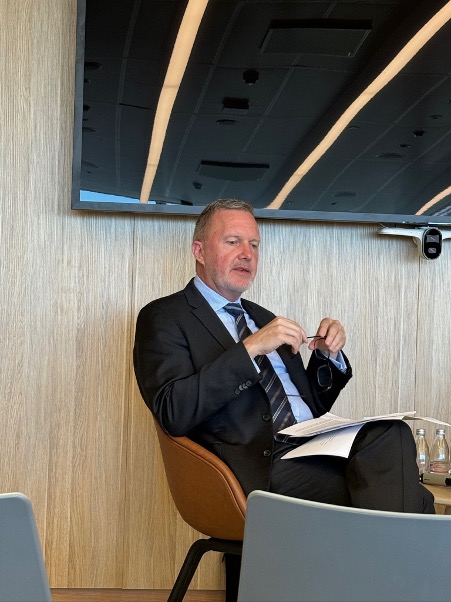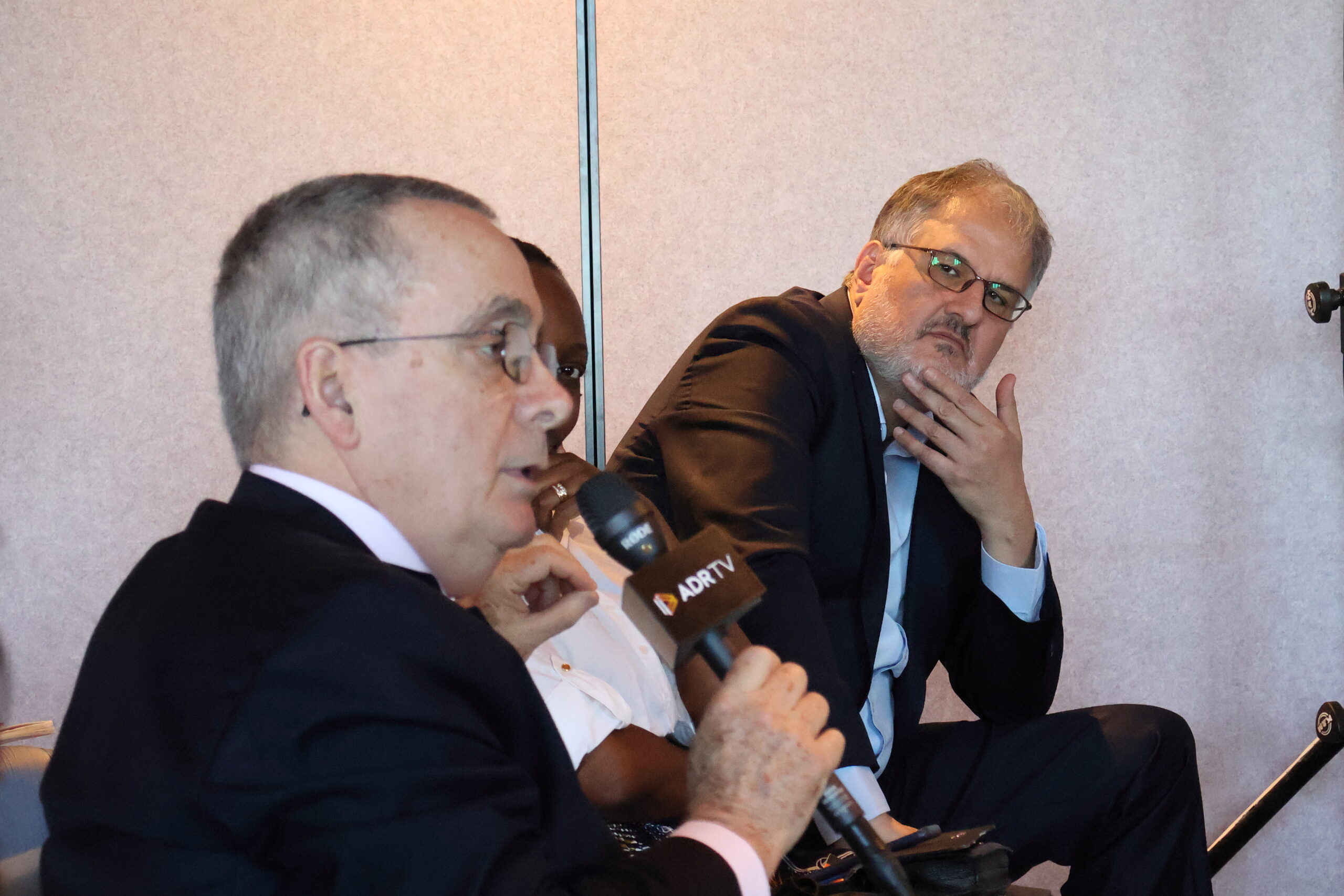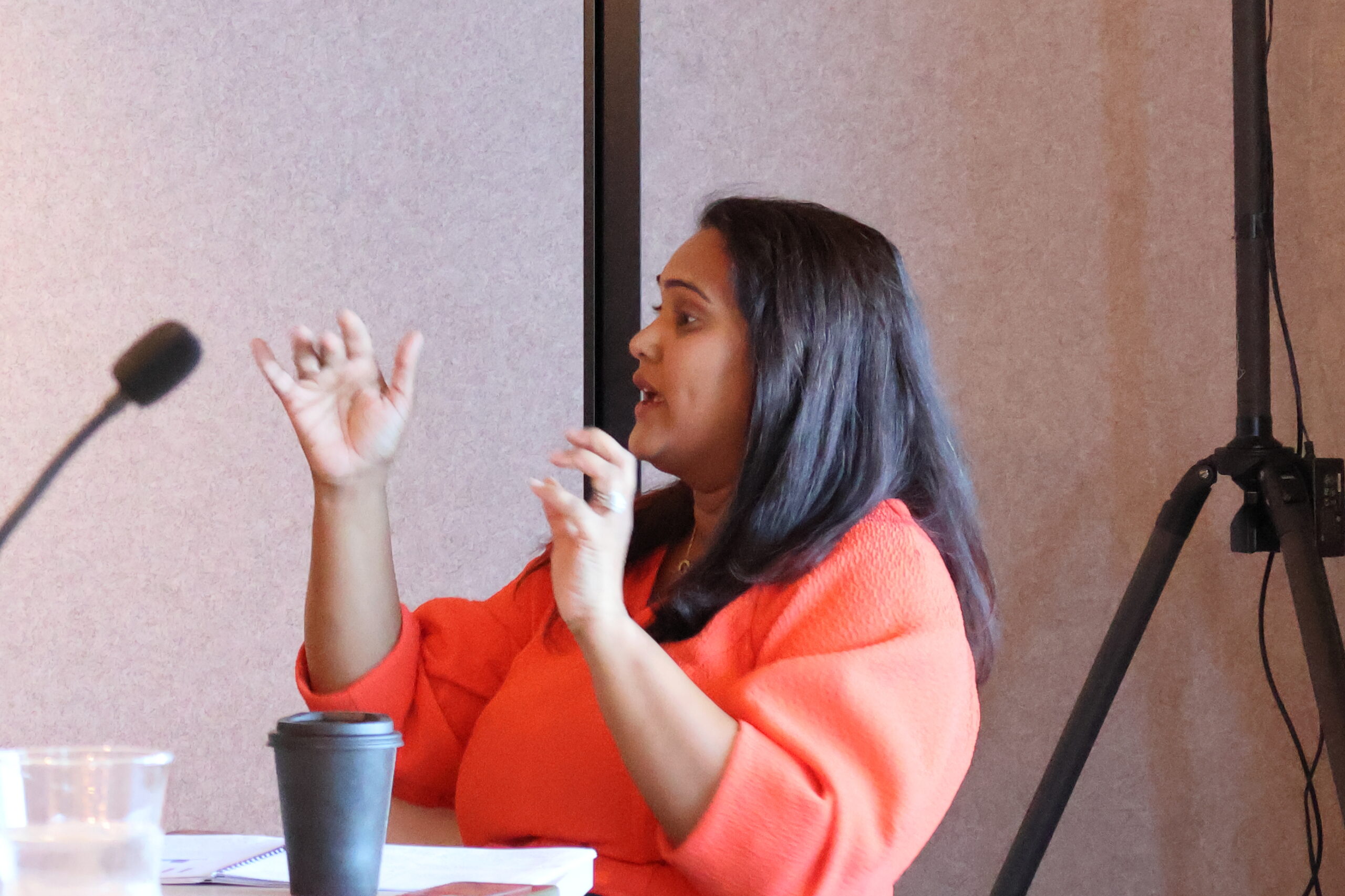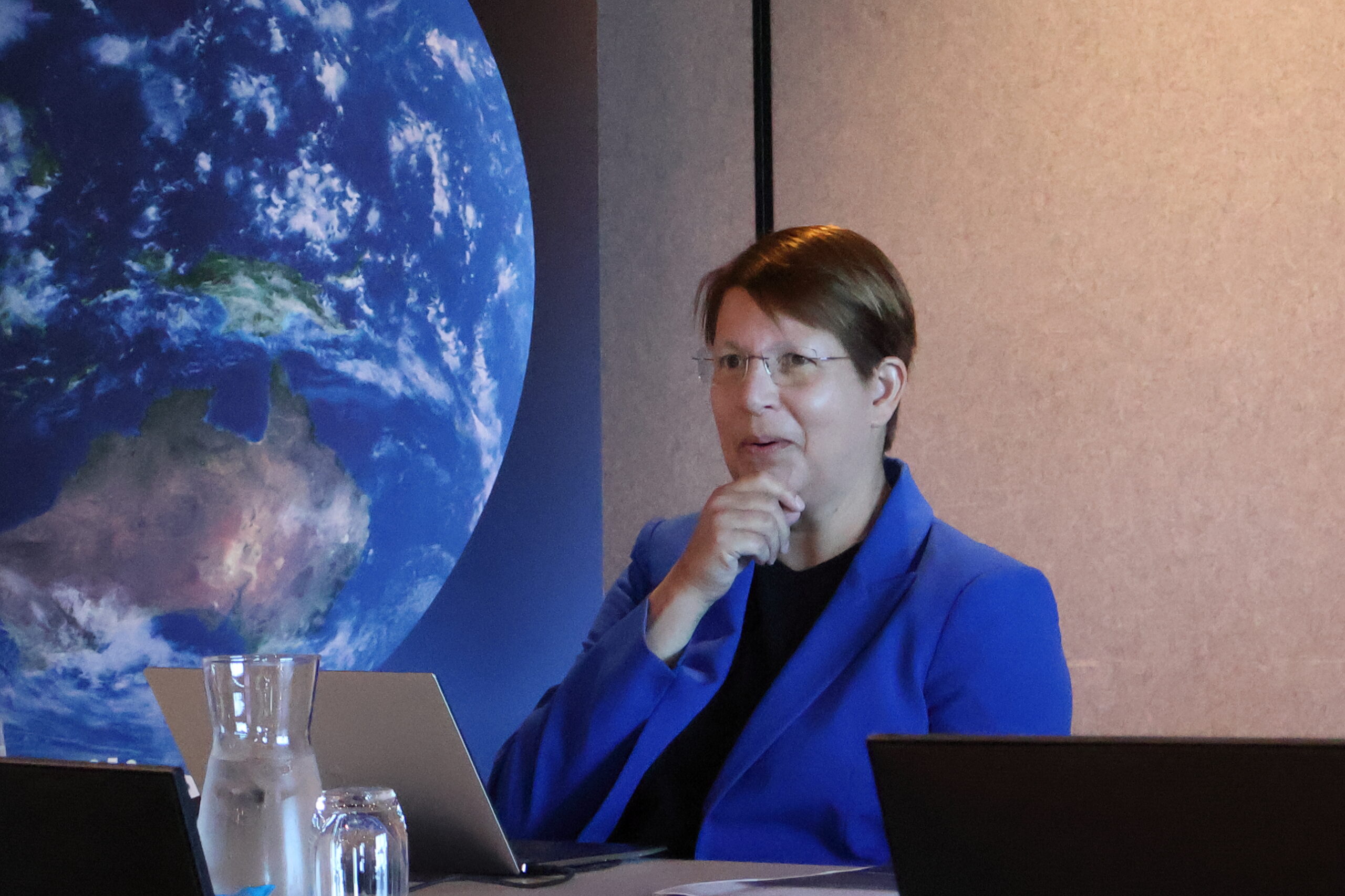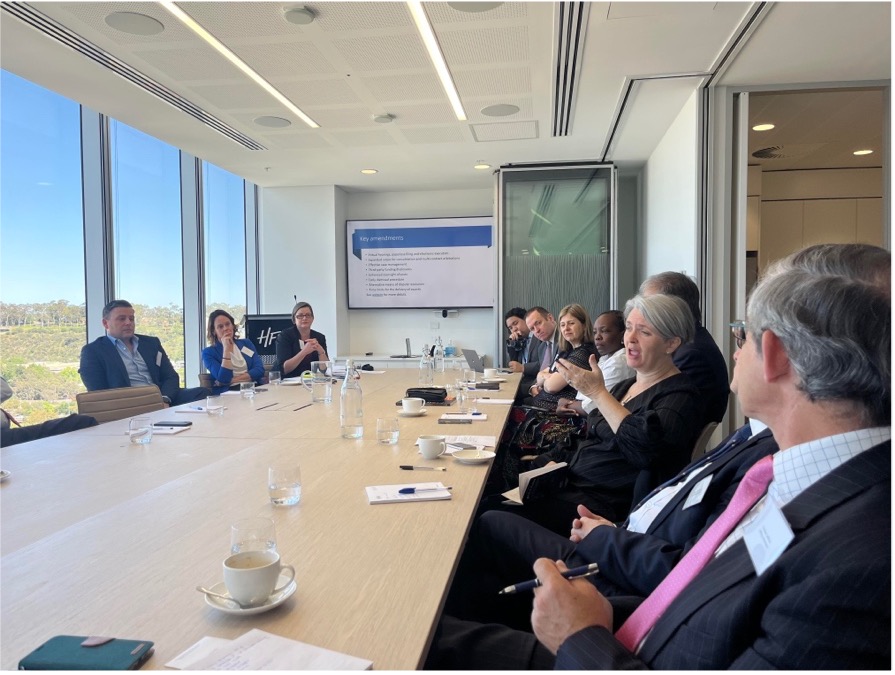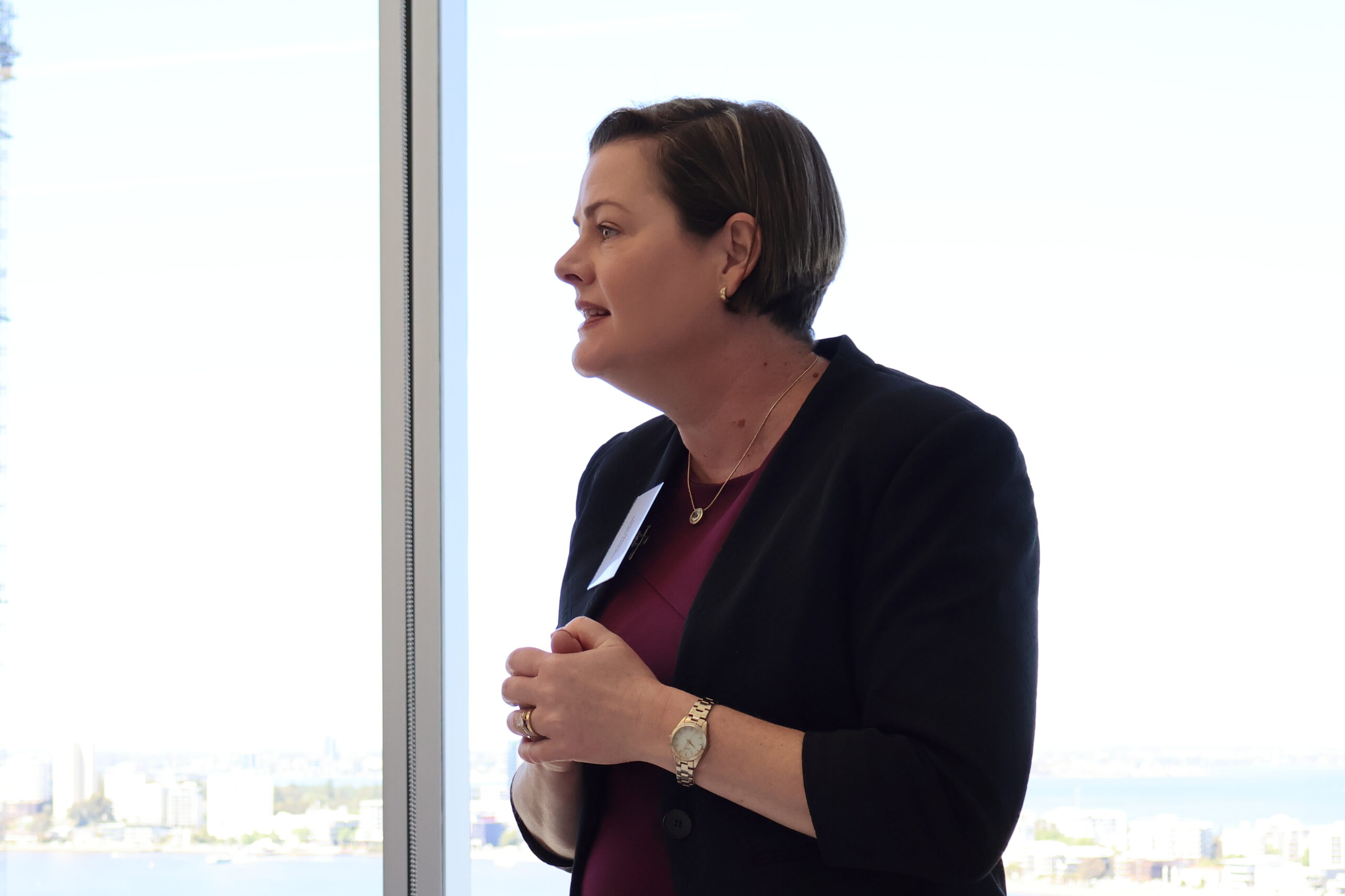AUSTRALIAN ARBITRATION WEEK 2023 BLOG
ACICA is pleased to launch the inaugural ACICA AAW Blog, through which we have provided daily reporting on events throughout AAW, showcasing the incredible content and speakers that was featured by Participating Organisations at events during the week.
ACICA’s special rapporteurs attended events throughout AAW and we have posted their insights and experiences here.
Ahead of the week, we heard from Georgia Quick (ACICA President & Partner, Ashurst) and James Morrison (Partner at Peter & Kim, ACICA Fellow and longstanding AAW participant), in their interviews on AAW with Chris Campbell for Tales of the Tribunal:
AAW Welcome Reception hosted by ACICA
Sponsor: Herbert Smith Freehills
Australian Arbitration Week officially commenced this evening with a welcome reception at the beautiful Perth offices of Herbert Smith Freehills. Looking out at a fantastic view over the Swan River, attendees were privileged to be given a welcome to country by Trevor Stack, who also performed a traditional Indigenous Australian song. Guests then heard from Elizabeth Macknay, Managing Partner (HSF) and Executive Director (ACICA). Elizabeth welcomed attendees to Perth, and specifically to the new offices of Herbert Smith Freehills. She also thanked the many esteemed individuals present, noting the growth and strong community of Australian Arbitration Week – now in its 11th year. Liz was followed by Deborah Tomkinson, Secretary General (ACICA), who spoke of the continuous growth of AAW, praised the engagement that ACICA had with the arbitration community in Australia and the region this year and referred to some of the new initiatives ACICA introduced in 2023 to encourage greater inclusion at all levels in AAW.
Deborah also took the opportunity to announce ACICA’s new Pacific Islander Scholarship Programme, which intends to open pathways for broader practice of international arbitration in the region. More can be read about the Scholarship Program here. Guests then enjoyed refreshments and delicious catering whilst mingling with friends and colleagues alike.
Now that AAW has officially commenced, attendees are looking forward to the first substantive event tomorrow, the ACICA & Ciarb Australia International Arbitration Conference, which is being held at the Ritz-Carlton Hotel.
Rapporteur: Charlie Hurst
ACICA & Ciarb Australia International Arbitration Conference
The Ritz-Carlton, Perth
Keynote Speech
The conference began with Kanaga Dharmananda SC delivering a thought provoking opening address, with insightful observations about the history and nature of black swan events, and how arbitration could learn from them. Kanaga pointed out that although the term “black swan” was intended to represent something so improbable as to be beyond prediction, in fact this was not the case, flowing from narrow Western perspectives.
Categorising black swan events as either Crashes, Conflicts, or Creations, Kanaga suggested that arbitration could become more fit for purpose by taking steps to improve the ability to adapt. Emphasising resilience, diversity as a strength, and greater transparency, he suggested that each of these factors could contribute to greater legitimacy of arbitration into the future.
Session 1: Around the World and Back
The first panel of the day lived up to its theme and took attendees around the world and back as it assessed developments in Africa, Hong Kong, Switzerland and London. From steps towards setting conditions for reform in Kenya including a court annexed mediation program, to the recent introduction of a new arbitration law in Nigeria, Jacqueline Githinji painted a picture of a continent increasingly embracing arbitration.
Dorothee Schramm challenged several commonly held myths about Switzerland, making the case that Switzerland was a value competitive, modern, dynamic, and innovative seat for arbitration. Dorothee said that Switzerland’s reputation for being a leader in international arbitration was well deserved, flowing in part from limited grounds for setting aside, and a practical approach to problems with a broad arbitration toolbox. She left the conference with three words she would use to summarise Switzerland – “Internationality, neutrality, pragmatism”.
Pryderi Diebschlag declared that – while it never really went anywhere – “Hong Kong is back”! From the enforcement benefits offered by the relationship with mainland China to the ability to make pre-commencement applications to freeze assets, Pryderi suggested that parties considering arbitration with a Chinese party would be wise to consider a Hong Kong seat. Additionally, he spoke about examples such as the recently decided pre-condition judgment of C v D and other case law demonstrated the support given to arbitration by the Hong Kong judiciary.
Samantha Lord Hill discussed proposed international arbitration act reforms for England and Wales, which included greater clarity for the ability of a tribunal to dismiss all or part of a claim on a summary basis, as well as greater support for emergency arbitration orders. Another notable proposed reform was to streamline the test applied to the law applicable to the arbitration agreement where this was not specified by the parties, following confusion generated by Enka v Chubb. The effect of this reform would be to encourage the application by Tribunals of the law of England and Wales as the seat where the applicable law is in doubt.
Session 2: Offshore Projects (and Onshore Problems)
From around the world to closer to Australian shores, the panel discussed the current state of play for offshore energy infrastructure and resource exploitation. Panellists stated that the initial scoping phase of many of the offshore infrastructure projects was now moving into a new completion and expansion phase. It was suggested that the primary source of arbitrations related to offshore projects would be project scope, delays, and unexpected knock on impacts.
Stephen Rae of FTI consulting in Perth observed that much of the fabrication now occurring is relating not only to turbines, substation components, and anchor structures, but also to purpose built repair and installation vessels. All panellists noted that the availability of such vessels was a significant bottleneck and driver of delay and associated cost blowouts, leading to an ‘arms race’ for such ships. The potential for arbitration at multiple levels of deep sea resource exploitation was flagged as an emerging area of international commercial and investor state arbitration.
The panel discussed disputes that could arise between combinations of the International Seabed Authority (ISA), state parties to the UN Convention on the Law of the Sea (UNCLOS) and commercial resource extraction contractors was also noted. Finally the panel discussed the advantages to choosing Australia for these and all kinds of arbitrations, reiterating Australia’s high level of experience in construction and energy disputes. Doug Jones AO pointed to Australia’s modern arbitral law, supportive judiciary, modern hearing facilities, long term neutrality and independence in the region, and the presence of sophisticated law firms and arbitral practitioners.
Session 3: Advocacy in Arbitration: A Deep Dive into Truly Persuasive Techniques
The conference was treated to a thorough presentation on arbitration advocacy that was incredibly valuable for emerging and current practitioners alike. Five main points were discussed:
- Know Your Case: the three pillars or triangle points of thorough preparation, sound case theory, and good judgment. Practitioners should prepare thoroughly with the end in mind, tailor their preparation to what is required, and remember that preparation generates confidence.
- Deal with the Entire Case: In a well prepared case there will be attractive pieces of prose or writing, though also room for flexibility and responsivity. Address your weak points, or that is the first thing the attention of the tribunal will be drawn to. Avoid hyperbole and overegging the pudding.
- Know your Tribunal: Be aware of tribunal member’s personality, and of extraneous issues like weather, time, and venue. Remember that arbitrators are more likely to be preoccupied with the question of do I have the power or jurisdiction to do what I am being asked to do. Know the arbitrators individually, to be able to understand their concerns. Take the advocacy role out of witness evidence – witness evidence should not be a vehicle for submissions.
- Keep it Simple: If the tribunal can’t readily understand your case, they are unlikely to accept it. Signal why you are making a particular point. Make your message easy to understand, with simple, everyday language. Signpost clearly so that you can take the tribunal on a journey with you. Empathise and understand not just your own case theory but what the other side are likely to be arguing.
- Be Authentic: Emotional intelligence is important. Read the room and understand how the Tribunal are responding to arguments. Be yourself – a persuasive advocate is not an advocate that fits a particular mould or template but someone who knows what works for them.
Session 4: Environmental, Social and Governance (ESG): Corporate Responsibility or State Responsibility?
In this session the panel approached ESG not with the baggage of recent political debates but as a pragmatic question of what international and domestic obligations exist and how can those obligations be met. Speakers discussed the human rights due diligence protocol, and how increasingly bilateral investment treaties featured language emphasising both the rights and obligations of treaty parties. The Panel discussed the way in which investor and commercial rights could be balanced against the public interest and ESG obligations, in particular the need for indigenous involvement and consent to resource investments.
Corruption as a principle of transnational public policy was used as an example of the way in which ESG does not necessarily have to flow from specific instruments but is increasingly being recognised as a standalone principle. The Panel agreed that the answer to the question of Corporate vs State Responsibility was that the responsibility for ESG lies with both, but also that it should not be viewed as a meaningless regulatory obligation, but a source of long term benefit.
Session 5: Conflict of Privilege Rules in International Arbitration: Blessing or Curse?
In a fascinating discussion about an issue which most arbitral bodies and rules are largely silent, the panel first compared the general positions taken on privilege between the common law and civil law world. Holly Blackwell explained that while generally in common law jurisdictions privilege attaches to the client and documents prepared for the dominant purpose of providing legal advice, the civil code position was different. In civil jurisdictions, privilege typically flows from professional secrecy obligations on the practitioner, and do not apply to in house counsel, while resulting in some commercial documents being privileged.
Lauren Lindsay pointed out that there were at least five ways the law applicable to privilege might be determined, including the law governing the contract, the law of the seat, the law of the place of performance, the law of the place where the documents were stored, and the law where legal teams are based and advice was generated. She spoke about the fact that the IBA were currently reviewing this issue, and that inspiration could be drawn from the Interpacific Bar Association’s innovative approach setting out an internal documented approach to privilege.
All speakers talked about the importance of disclosure schedules, and discussing the issue of how privilege would be dealt with at the outset at the first procedural hearing. Assumptions from both sides where different traditions of privilege exist can lead to significant time and cost delays, when setting expectations and agreeing at the beginning would have prevented them. Dr Peter Wolfgang suggested that whatever approach was decided, ‘most favoured nation’ principles should lead to privilege rules being consistent for all parties in a dispute.
Session 6: Arbitration New Frontiers: AI, Sustainable Practices and Other Ideas
This panel demonstrated the way in which AI in Arbitration is not only inevitable, it is already here. AI has the ability to scan and read documents in real time and answer questions about the contents of even 700 page documents with ease in less than a minute. With the ability to draft and prompt for contractual clauses, John Swinson ran a demonstration of the power of AI to generate (seemingly) fit for purpose reporting and summaries of the law. Though he noted that this is still prone to error, and the same question asked multiple times can yield different answers, showing the complexity of the field and the variability of machine learning.
The second significant theme discussed in the panel was of climate change, and the need for the arbitration community to contribute to sustainability and green initiatives. Suggestions such as embracing virtual hearings, electronic discovery, and forms of communication minimising carbon footprint were canvassed. Kiran Sanghera spoke about the Green Arbitration Protocols, and the way in which they provided a template and guidelines for arbitral tribunals, institutions, and practitioners to think consciously about what was truly necessary. Finally, in a synthesis of both themes, the conference was shown a headset that would allow tribunals to hold virtual hearings in a persistent digital space, complete with visual avatar representations of participants!
Session 7: General Counsel Roundtable
Following afternoon tea attendees heard valuable perspectives from in house counsel regarding their experience of arbitration as the interface between arbitration and arbitration clients. Their message was overwhelmingly about the importance of the relationship between external and in-house counsel, and the reliance on sound advice and guidance in choice of arbitrators as well as how an arbitration should be run. Confidentiality was cited as a key benefit of arbitration, perhaps even the overwhelming consideration when choosing between litigation and arbitration.
The panel sounded a cautionary warning to the arbitration community that arbitration should not allow itself to become litigation-lite or be bogged down in excessive formality, delays, and resulting cost blowouts. To the extent that arbitration was to continue to grow and be embraced in Australia, panellists urged practitioners and arbitrators to return to basics and keep arbitration a flexible, faster, and lower cost alternative.
Session 8: Why Arbitration? A Quiz and Pursuit of Glory
The final panel of the day saw the conference learn a lot they didn’t know about arbitration, and also a lot about our final panellists as attendees were treated to a game of arbitration trivia, hosted by Justin D’Agostino MH, where hilarity ensued.
Cocktail Reception Speaker
A post conference speech by the Hon. James Allsop AC reiterated the journey of international arbitration and the thriving arbitral community that has grown up around it in a fitting finish to the best Arbitration Conference to date!
Rapporteur: Jordan Dittloff
Speaking of Balance: Wellbeing in International Arbitration
Hosted by ACICA
Speakers:
- Amanda Lee, International Arbitrator, Consultant at Costigan King and Founder of ARBalance
- Desi Vlahos, Commissioner on the IBA Professional Wellbeing Commission & Senior Lecturer at the Australian College of Applied Professions
- Professor Samuel Harvey, Executive Director and Chief Scientist at the Black Dog Institute.
- Moderator: Deborah Tomkinson, Secretary General at ACICA.
This exciting panel highlighted some of the many difficulties faced by arbitrators and practitioners in what has become such an incredibly competitive and challenging field. The discussion commenced with a discussion around the use of the term ‘wellbeing’ and its relationship with the workplace.
It became apparent very early in the discussion that wellbeing is not just a one-dimensional term but one with wider and more holistic implications. This sentiment was recognised by all members of the panel and mentioned throughout. Amanda echoed the thought by saying towards the end of the discussion that while corporate wellbeing initiatives are helpful in starting a conversation, real change needs to occur through addressing things as simple as poor communication, bullying, passive aggressive behaviour, and a lack of boundaries within teams.
Professor Sam began by discussing three things workplaces need to consider when looking at improving wellbeing. Desi seconded this later in the discussion, stressing the necessity of addressing risk factors, seeking to promote positive outcomes, and supporting those with mental health issues. Companies, according to Sam, need to protect the mental health of workers through preventative measures. This can include identifying and reducing risk factors within the workplace. Workplaces should then look at implementing measures to promote wellbeing. Sam explained that there has been a shift from viewing mental health as simply as an absence of illness towards including positive wellbeing. Desi discussed how workplaces can promote wellbeing through allowing for flexible work, and through recognising the need for reasonable boundaries between work and personal life. Finally, workplaces should support and respond to people with mental illness by providing resources and by allowing for a graded return to work.
Desi cited research from PWC which “found that for every one dollar spent in introducing an effective action to create a mentally healthy workplace, companies can expect a $2.30 gain.”
The conversation moved to a discussion of the recent IBA study into workplace wellbeing. Desi told us that lawyer wellbeing is well below average and that 41% of survey participants said they were unable to discuss mental health with their employer without negative consequences. She raised the point that while many organisations realise the importance of aiming for wellbeing, there’s a disparity between organisations which have say they care about mental health and those that have concrete initiatives in place. Both Desi and Amanda raised the important fact that challenges around workplace wellbeing have a disproportionate effect on women, and on linguistically and culturally diverse people.
Sam noted that managing sleep, as much as is possible and practicable around travel, and maintaining social connections is crucial for individual wellbeing. He mentioned the power of social connections in wellbeing and noted the toll that international arbitration can take on the social front. Maintaining social relationships is, Sam said, the “closest thing to a secret around wellbeing that we’ve discovered so far.”
All speakers agreed about the futility of having corporate cupcakes and wellness BBQs without further, concrete action. Sam noted that this should include a top-down approach where companies take a real interest in the wellbeing of their workers. Desi and Sam agreed that companies need to monitor any measures they put in place to find out what works and should take care to really understand the workplace culture before writing policies. Amanda pointed out ways companies could help by identifying key stressors including public speaking and networking and then providing development. Sam spoke about how important it is for people to be aware that they can seek help and that there are solutions. Deb noted that the overall message should be not to be afraid to seek help if needed.
Sam and Desi noted a variety of resources including webinars and toolkits, some of which are posted below. Desi pointed out that different Bar Associations and Law Societies often host webinars and that it could be helpful to find a mentor through these associations. She stressed again the importance community when it comes to maintaining wellbeing and not facing mental health issues alone.
The fruitful discussion was brought to a close with a mention of some of the practical wellbeing initiatives at Arbitration Week, including a run and walk on Thursday 12 October. Groups are meeting at 6:30 am at the Bell Tower, Elizabeth Quay and you can register here.
Key Resources:
Workplace wellbeing information and resources – Black Dog Institute | Better Mental Health
Rapporteur: Dominic Casanova
Immunity and justiciability in international arbitration: the limits of inquiry into State conduct
Hosted by Twenty Essex
Speakers:
Professor Philippa Webb, Twenty Essex (Moderator)
Andrew Fulton KC, Twenty Essex
Mark Tushingham, Twenty Essex
The interrelated doctrines of foreign act of State and foreign State immunity were, respectively, considered in two recent decisions of the highest courts in the UK and Australia: “Maduro Board” of the Central Bank of Venezuela v “Guaidó Board” of the Central Bank of Venezuela [2021] UKSC 57 (“Venezuela Gold”) and the Kingdom of Spain v Infrastructure Services Luxembourg S.à.r.l. [2023] HCA 11 (“Kingdom of Spain”).
In this webinar, Professor Philippa Webb, Andrew Fulton KC, and Mark Tushingham of Twenty Essex reflected on the outcomes of these cases and explored the application of the foreign act of State and foreign State immunity doctrines in the context of international arbitration.
Mr Fulton KC opened by impressing upon the audience that the foreign act of State doctrine has been regarded as “one of the most difficult and most perplexing topics which, in the field of foreign affairs, may face the municipal judge in England” (Dr F A Mann, Foreign Affairs in English Courts (1986), p. 164). That would soon become apparent, as Mr Fulton KC delved into a myriad of issues raised in Venezuela Gold concerning the limits and exceptions to the common law rule that English courts will not inquire into the validity of an act of a foreign State that takes place or takes effect within the territory of that foreign State.
In the spirit of AAW, Mr Tushingham then turned to the question of whether the foreign act of State doctrine applies in international arbitration. Three key issues were identified in the context of international commercial arbitration. First, is an arbitral tribunal bound to apply the foreign act of State doctrine? Secondly, are executive acts the subject of the foreign act of State doctrine arbitrable? Thirdly, are parties who submit their disputes to arbitration to be treated as having waived the foreign act of State doctrine? A central piece of the puzzle is how the foreign act of State doctrine should be characterised. Is it a conflicts of law rule of the law of the seat, a substantive rule of the governing law, or some other kind of rule? The UK Supreme Court characterised the rule as “an exclusionary rule, limiting the power of courts to decide certain issues as to the legality or validity of the conduct of foreign states within their proper jurisdiction” (Venezuela Gold at [135]). But without further clarification, the verdict remains unclear.
Also unclear is the approach to waiver and the approach to the trinity of recognition, enforcement, and execution in the wake of Kingdom of Spain. Professor Webb discussed, from a comparative law perspective, the divergent and nuanced features of the ongoing Kingdom of Spain renewable energy litigation across Australia, the UK, and the US. The High Court of Australia ruled in Kingdom of Spain that the Kingdom of Spain had waived its foreign State immunity under Article 54(1) of the ICSID Convention. This required an express waiver, but such express waiver could be, and was, established through implication or inference, a curious principle that aligns with the US approach, albeit without reference to the features of US constitutional law on which the US approach is based. The immunity recognised with respect to recognition and enforcement in Kingdom of Spain leaves unanswered questions as to whether the same immunity would be afforded under similar but differently worded legal instruments, or in jurisdictions where the Australian or common law notions of ‘recognition’ and ‘enforcement’ may not have direct equivalents.
There is certainly a lot of food for thought. If you’re hungry for more, please do help yourself to the smorgasbord of insights (the full webinar) available at https://www.twentyessex.com/australian-arbitration-week-2023/.
Rapporteur: Edward Wu
Critical Errors and Strategic Missteps to Avoid in International Arbitrations Hosts: Jones Day and Quayside Chambers
Hosted by Jones Day & Quayside Chambers
Speakers:
- Matthew Gearing KC (Barrister and Arbitrator Quayside Chambers Fountain Court Chambers (UK))
- Katie Mead (Partner Global Disputes Jones Day Perth)
- Leon Firios (Barrister and Arbitrator Quayside Chambers)
- Simon Bellas (Partner Global Disputes Jones Day Melbourne) (Chair)
- Dan Chaney (Associate Global Disputes Jones Day Perth)
In a very helpful Hitchhikers’ Guide to the Galaxy of Arbitration, the panellists at this event took the audience through the lifecycle of an arbitration, examining the problems that may arise at each stage and providing advice on how to manage these challenges.
Starting with the drafting of the arbitration clause, Matthew Gearing reflected upon the historical focus on the choice of the seat, as an effort to anchor the arbitration to supportive curial jurisdictions at the seat. Matthew suggested that this emphasis has shifted as we see less curial interference with arbitration, to an at least equal focus on the issue of the law governing the arbitration agreement and the wide scope of issues that can come up in the context of the debate about the law governing the arbitration clause.
Katie Mead continued, highlighting that it is important to ensure that arbitration clauses are tailored and fit for purpose. Katie suggests considering issues such as where the parties are based, for enforcement reasons, and the commercial relationship with and profile of the counterparty, particularly whether they are likely to be litigious. These early drafting choices often set the foundation of the outcome of the arbitration.
Turning then to the selection of the tribunal, Leon Firios canvassed the attributes of a good arbitrator, such as availability, experience, subject matter expertise and collegiality, drawing out that at the core of these attributes is the importance of ensuring that there is a fair process and a quality decision, critical for the legitimacy of the arbitration. Leon and Dan Chaney both encouraged the audience of be innovative, with Dan highlighting the distinction between “a good arbitrator and a good arbitrator for your client”.
Next the panellists considered missed opportunities when setting procedure, looking at two critical questions: the use of pleadings or memorials, and the efficient use of experts. Katie examined the differences between a memorial style approach and the exchange of pleadings. She accentuated that the choice of approach requires consideration of costs and time, and what will best suit your clients case. For example, if your client will be reliant on a document production process, a pleadings style approach may be recommended. On the pleadings vs memorials debate, Matthew suggested that we may be able to be more creative and adapt memorials to include only what is appropriate, such as some lay evidence but not expert evidence, and walk along the line of the traditional dichotomy.
Leon then spoke about the management of experts, starting with the importance of setting the ground rules of the interactions between experts, with reference to CIArb’s expert’s protocol and the ability for international arbitration to take a much more liberal approach as compared to courts. Leon also focussed on the importance of the timing of the tribunal’s intervention and the dangers that can arise when the tribunal’s direction to the experts comes before the issues are crystallised.
Simon Bellas, chairing this panel, helpfully summarised that the crux of both issues is the importance of knowing your case and what will best serve your clients interests before the procedure is discussed and set at the case management conference.
Finally, arriving at the hearing stage, Matthew encouraged instructors and counsel to be as one team, working together and challenging conceptions about who is best for the task at hand. Matthew also spoke about how in the era of Zoom and Teams, we should encourage having conferences and hearings online, instead of just one single evidentiary hearing, highlighting the benefits of this and how it keeps arbitrators engaged. Dan also touched upon the importance of client management at the hearing and setting client expectations and involving them in communications about strategic decisions and case theory so that they are reassured their interests are being protected.
This panel was highly instructive and comprehensive, running through the common missteps and pitfalls that may arise during an arbitration. The experience and expertise of the panel provided a thorough guide for avoiding critical errors.
Rapporteur: Jessie Xiao
Maritime Arbitration Update
Hosted by AMTAC
Speakers:
- Gregory Nell SC (AMTAC Chair and Senior Counsel, New Chambers, Sydney) (Chair)
- The Hon James Allsop AC (Arbitrator, Sydney Arbitration Chambers & former Chief Justice of the Federal Court of Australia)
- Ashwin Nair (Partner HFW, Perth)
- Kendall Messer (Senior Associate, Hall & Wilcox, Perth)
While maritime law had been raised obliquely during Session Two of Monday’s ACICA & CIArb International Arbitration Conference, entitled “Offshore Projects (and Onshore Problems)”, and the DLA Piper event immediately prior, entitled “Navigating Rough Seas: Insights into Arbitration Trends and Issues Relating to Offshore Petroleum, Shipping, Decommissioning and Blue Bonds in Australia”, the Maritime Arbitration Update provided the stage for a nuanced discussion of this unique and important area of the law.
Gregory Nell SC began by providing some background information into the important role of the Australian Maritime and Transport Arbitration Commission (AMTAC) in facilitating the arbitration of maritime disputes in Australia. He then introduced the three speakers, each of whom delivered individual presentations on a wide array of issues at the intersection of maritime law and arbitration.
The Hon James Allsop AC spoke first by delivering a paper that expanded upon what he had presented last week in the 2023 Dethridge Memorial Address. His presentation traced the importance of the unique status of maritime law amidst national and international legal contexts, and provided a glimpse into the significance of arbitration in facilitating the proper development of maritime law. The presentation began by interrogating the nature of maritime law, particularly its international character, and the fact that, unlike national legal systems, it turns not on the social and cultural context of any one place, but rather it concerns an activity. The illustration given was that of a forest of trees. On the one hand, a comparative analysis of different legal systems naturally reveals certain similarities, just as individual trees interweave as they grow and produce a complex canopy of overlap. On the other hand, maritime law provides its own internally consistent set of principles, from which nations draw to develop their own national maritime regimes, like trees springing up from one shared root system. James proposed that the recognition of maritime law’s unique, international character is fundamental to ensuring the proper and coherent development of maritime law, namely by avoiding the tendency of individual nations overly to taxonomise and abstract principles of maritime law so as to fit within their national legislative regimes. The proposed ideal was to the effect that clearly and simply expressed principles are more conducive of certainty and predictability in the outcome of disputes, as they allow those with experience in maritime law to refer these principles to their personal professional experience, thereby arriving at the fair and correct decision. James concluded by noting that this is where arbitration has the capacity to make a great contribution, by allowing commercial parties to select arbitrators with expertise and experience who are capable of resolving their disputes with an intuition, precision and efficiency that is impossible in litigation.
Ashwin Nair was the next to speak, and discussed the adoption (or lack thereof) of electronic trade documents in maritime commerce. The theme for his presentation was “Crossing the River on Shifting Stones?”, a metaphor for the transition from analogue to digital that is still to be fully effected in maritime law, and that contains hidden challenges (“stones”) that will need to be overcome. Ashwin situated his discussion in the context of the widespread digitisation of a variety of legal activities, which it should be noted has itself become somewhat of a theme for Australian Arbitration Week and its orientation towards future trends. The presentation considered then in granular detail the multiple important functions of bills of lading in maritime law, and the difficulties that physical bills of lading continue to bring with them. Most striking of all, perhaps, is the cost that physical bills of lading entail, with it suggested that problems that they cause contribute 10-30% of total trade document costs, equivalent to several billions of US dollars. Ashwin then presented the benefits that electronic bills have the potential to bring about, including increased security and speed and reduced costs, but noted the ongoing challenges with fitting e-bills into the complex legislative regime that governs maritime law in Australia.
Kendall Messer concluded the event with a discussion of important foundational principles in arbitration law, which were presented with a maritime “theme” in that the Australian and international authorities referred to all involved maritime commerce. The topics discussed, namely the doctrine of separability with respect to arbitration agreements, and the principle in Fiona Trust that parties are presumed to have intended that their disputes be resolved in the same forum (unless a contrary intention should have been displayed), were both analysed from the perspective of whether they constrain or widen the scope for disputes to be settled via arbitration. The cases discussed revealed a complex tapestry of examples that demonstrate the primacy of party intention in resolving questions concerning the construction of arbitration agreements. Kendall’s presentation provided a fitting conclusion to the event, insofar as it illustrated the important place that maritime law has in contributing also to other areas of commercial law, including arbitration.
Rapporteur: Peter Taurian
Disrupting Disputes: The benefits of arbitration in Technology
Hosted by Corrs Chambers Westgarth
Speakers:
Elizabeth ‘Lizzie’ Chan (Tanner de Witt)
Eric Ng (HKIAC)
Dmitri Evseev (Independent Arbitrator)
Lucy Martinez (Independent Arbitrator)
The panel covered fascinating and topical aspects of the intersection between arbitration and technology.
Eric first discussed the suitability of arbitration as a dispute resolution mechanism for technology disputes, being a flexible, confidential process. Many arbitral seats now also allow for the arbitration of IP disputes, which often arise in technology transfer agreements, meaning arbitration can provide a complete dispute resolution offering.
Lucy then covered key trends in the intersection between technology and arbitration. First, the number of investor-state disputes arising in the technology sector is increasing, notable high-profile examples being the Huawei v Sweden and Uber v Colombia cases. Second, the number of technology disputes generally is increasing, in line with the increasing use of technology. Special dispute resolution rules have been drafted to deal with the unique exigencies of such disputes, including by the UK government, and by JAMS. Third, there are increasing challenges from a consumer protection perspective as to how and when consumers agree to arbitration agreements in contracts.
Lizzie then spoke on the metaverse, and noted that in the near term there will be limited disputes directly arising out of metaverse. However, in the medium term, with improvements in augmented and virtual reality, the metaverse could be used to host hearings remotely. In the long term, institutional rules could be adapted to suit metaverse disputes, such as provision for anonymity.
Technology and the Arbitral Process
Eric then discussed, from an institutional perspective, the impact of IT on procedure. He noted that COVID-19 changed the paradigm for critical aspects of the arbitral process, such as hearings and the delivery of documents, and this has fostered innovation and changed process norms. Technology assists parties to reach outcomes, in a faster and cheaper manner, an example being the HKIAC’s Case Connect, an online document platform. However, institutions must balance this efficiency with the integrity and confidentiality of the process.
Dmitri discussed the potential benefits, risks, and limitations of generative AI for the arbitral process. In terms of the benefits, AI tools can help automate processes such as reviewing documents, translation, and transcription. However, key limitations of such tools include their inability to give accurate citations and reasoning or process behind steps taken, alongside the lack of confidentiality protections. Additionally, misuse of such tools could cause significant harm, one example being the creation of fake documents through ‘deepfake’ technology.
Lucy then recounted her observations on increased technological dependence in the arbitral process. First, arbitrators must be comfortable with virtual hearings, while giving adequate weight to procedural fairness. Second, arbitrators must become familiar with electronic case file management systems. Finally, she commented that the shift to a virtual format can create a lonely experience due to the lack of organic human interactions.
Silicon Valley Arbitration & Mediation Centre Draft Guidelines on the Use of AI in International Arbitration
Lizzie then spoke on the potential use of AI by lawyers, drawing on her experience as a member of the drafting committee responsible for the Silicon Valley Arbitration & Mediation Centre Draft Guidelines on the Use of AI in International Arbitration. These guidelines were prepared against a backdrop of rapid adoption of AI by lawyers, counsel, and experts, raising disciplinary and ethical questions. While there have been ad hoc approaches to regulating the use of AI, there had not previously been a unified approach to the issue. The guidelines were prepared to address this lacuna. The drafting committee defined AI broadly, to allow for the development of new forms, and included two approaches to disclosure of the use of AI, noting that it remains a continuing area of controversy.
Dmitri, who also sat on the committee, provided further commentary on the guideline concerning the non-delegation of decision-making responsibilities, noting that it is difficult to define the acceptable outer limits of the use of generative AI. However, fundamentally, tribunals should not ask AI tools to provide evaluations. Additionally, tribunals should be careful when using AI to generate a factual background to supplement expert reports, since this could constitute the use of information outside the record. Ultimately, the guidelines aim to raise questions about acceptable behaviour, rather than prescribe certain conduct.
Technology and Investor-State Dispute Settlement
Finally, Lucy discussed the protections offered to technology companies offered under investment treaties, noting that the extent of protection is necessarily determined by the specific definitions and features of the individual treaty. There are also outstanding questions regarding whether data can be protected as an ‘investment’, and the quantification of tech assets can be difficult where the economic value of an asset has not yet crystalised. These issues remain ripe for exploration in existing and future cases of investor-state disputes.
Rapporteur: Caroline Xu
Climate Issues at the Intersection of Law and Politics
Hosted by Allen & Overy and Twenty Essex
Speakers:
- Karina Travaglione – Allen & Overy (moderator)
- Jonathon Redwood SC – Twenty Essex
- Suzanne Spears – Paxus LLP
- Daniel Kalderimis – Twenty Essex
- David Jenaway – Allen & Overy
Daniel Kalderimis perfectly summed up the key issues arising out of this panel session when he called climate change a ‘grey rhino’ of legal disruption, that is, a phenomenon that you know is there and will have an impact but you’re not entirely sure how it will play out yet. The panel considered what this disruption might, and indeed is already starting to, look like.
In the public space, Suzanne Spears explained that individuals and groups are making legal claims against States and companies armed with the IPCC Report and Paris Agreement. This raises several issues. First, and broadly, there is a debate on whether it’s the court’s role to order States and corporations to act on climate change, or whether this should be left to the State legislatures.
If indeed courts are competent, the next question is how to identify a legally actionable duty and right, a task that can be difficult when there aren’t specifically enforceable rights relating to climate change in constitutions or human rights documents. Courts at every level have increasingly been called to draw on existing human rights in the context of climate change, and Suzanne Spears points to the US state case of Held & Ors v Montana where the Claimants were able to prove standing and causation and the Court was able to identify a method of redress in relation to a claim against the State for harms caused by its energy policy.
Daniel Kalderimis also gave the example of the New Zealand case of Smith v Fonterra & Ors where the plaintiff made claims in public nuisance, negligence and a new proposed cause of action in tort relating to climate change. While all three claims were struck out in the Court of Appeal, a final decision from the Supreme Court awaits and this will be a significant test case. Other claims have arisen in relation to climate change alleging misleading and deceptive conduct, and Jonathon Redwood SC also points to the likely increase in climate related class actions.
As policy and legislation on climate change continues to redefine state obligations and the scope of company and investor’s property rights this will also have an impact on investment arbitration. Suzanne Spears considers that although the tribunals in Rockhopper v Italy and Eco Oro v Colombia considered the issue of a host state’s climate obligations to be political, there will be a rise in state defences for breach of treaty provisions on the basis of obligations to protect their populations from climate change.
Similarly in a commercial space, climate change creates new challenges and opportunities for traditional contracts. David Jenaway explained how new technology and novel players in the game, as well as a rapidly changing regulatory environment will push lawyers to consider risk identification and allocation in a different way.
Arbitration is very well suited to bilateral contractual disputes in the private commercial space. Jonathon Redwood SC pointed to the selling points of flexibility, enforceability and the ability to select arbitrators with the relevant technical knowledge for your particular dispute. He did however consider that given the overlay of class actions and public law considerations, there would be limitations with confining disputes strictly to the parties in the arbitration. Regulatory frameworks could also pose public policy and arbitrability issues.
Climate change is an issue that both in effect, and in proposed solution, demands the intersection of law and politics and, as the panel demonstrated, this will create both challenges and opportunities alike.
Rapporteur: Alisha Mathias
International Arbitration in the Asia-Pacific: What is Hot and What is Not? Key Trends and Developments in the Region
Hosted by King & Wood Mallesons
Speakers:
Professor Anselmo Reyes (Arbitrator, SICC Judge)
Edwina Kwan (King & Wood Mallesons)
Amanda Lees (King & Wood Mallesons)
Holly Blackwell (King & Wood Mallesons)
The speakers in this panel provided invaluable insights on arbitration trends in the Asia-Pacific region.
Amanda first noted three developments in Singapore. First, Singaporean courts are more willing to set aside awards when process issues arise, as illustrated by the eight awards set aside between 2020 and 2022. Courts are increasingly concerned about curbing improper behaviour by tribunals, examples including the refusal to hear a witness where no witness statement was previously provided, and an award with incoherent reasoning. Second, the recent decision of Anupam Mittal v Westbridge Ventures II Investment Holdings provides clarification on determining arbitrability, setting out a two-step process: (i) the subject of the dispute must be arbitrable under the law governing the arbitration agreement, and (ii) it must also be arbitrable under the law of the seat. Third, the SIAC has released new draft proposed rules. Key features include a streamlined procedure for disputes under $1mil, a preliminary determination process, and more areas for intervention by the Registrar and President.
Anselmo then spoke on the merits of international commercial courts, noting that each jurisdiction considering the implementation of a commercial court should carefully consider its objectives. For example, the SICC aims to attract cases to Singapore which ordinarily would never be decided there, while the Uzbekistan Commercial Court forms part of the legal framework supporting foreign direct investment. In terms of the benefits of international commercial courts, Anselmo drew from his experience as an SICC judge, noting that the jurisdiction to deal with arbitration-related cases has been successful in drawing cases to Singapore.
Holly spoke on the slow but steady evolution of China’s arbitral practice. Progress is signalled by the 2021 announcement of proposed updates to the arbitration law, and the growing presence of international commercial courts across China, which sit as specialised courts and have jurisdiction to hear arbitration-related cases. The draft arbitration law, which is currently under deliberation, moves Chinese law closer to the Model Law. Key updates include provision for ad hoc arbitration and competence-competence, the power to order interim measures, a unified system to set aside or resist enforcement of domestic and foreign awards, and the legal framework for foreign arbitral institutions to administer cases in China. China has also passed its new Law on Foreign State Immunity, which moves from an absolute immunity model to more restricted immunity for foreign States.
Edwina spoke on the continuing strength of Hong Kong as an arbitral seat, pointing to the special arrangement allowing for enforcement of interim measures against Chinese parties by Chinese courts, and the mutual recognition of arbitral awards between Hong Kong and the People’s Republic of China. Cases such as Song Lihua and C v D also illustrate the pro-arbitration stance of Hong Kong courts. She also commented on the spate of enforcement proceedings for investment awards in Australia, including notably the Kingdom of Spain decision of the High Court of Australia. Reasons for Australia’s popularity as a destination for enforcement, even in the absence of significant assets, include the speed of court determination, the judiciary’s pro-arbitration stance, and the authority or precedential value which an Australian court decision provides.
Amanda then spoke on the relative difficulty of arbitrating in a number of Southeast Asian jurisdictions, and expanded on the difficulties of arbitrating in India, including the lack of supervisory support by Indian courts during the arbitral process, the fewer grounds for challenging enforcement based on public policy, and the Supreme Court decision of N.N. Global which held that unstamped arbitration agreements are void and unenforceable.
Finally, Anselmo discussed the efforts on Japan’s part to promote itself as an arbitral seat, including the proposed amendments to bring Japanese arbitration law in line with the 2006 Model Convention, and the new discretionary power of Japanese district courts to provide for the non-translation of documents, making Japanese courts more accessible to foreign parties. Japan aims to draw on its civil law background as a differentiator to major seats like Singapore and Hong Kong, to attract parties under the civil law tradition. Anselmo also noted the growth of investor-state claims, as a response to the increasingly protectionist stance of States in the wake of COVID-19, and that the existing investment agreement regime could be replaced with a model in line with the Singapore-EU Free Trade Agreement, with a specialised court or tribunal.
Rapporteur: Caroline Xu
Navigating rough seas: Insights into arbitration trends and Issues relating to offshore petroleum, shipping, decommissioning and blue bonds in Australia
Hosted by DLA Piper
Speakers:
- Corey Steel (DLA Piper)
- Michael Robbins (DLA Piper)
- Laura Nagy (DLA Piper)
- Claire Robertson (DLA Piper)
- Pat Saraceni (Clifford Chance)
- Darren Murphy (Baker & O’Brien)
The risk inherent to offshore petroleum projects, meshed with the regulated and multinational character of these projects, demands arbitration above all. The panel provided a wide-ranging discussion of trends in international arbitration, spearheaded by Laura Nagy and Claire Robertson (DLA Piper), Pat Saraceni (Clifford Chance) and Darren Murphy (Baker & O’Brien), and steered by Corey Steel and Michael Robbins of DLA Piper.
The panel began with an insightful deep-dive into decarbonisation with a comparative twist, delving into decarbonisation practices across Australia and the United Kingdom. Pat Saraceni emphasised the significance of decarbonising existing archaic shipping practices, currently comprising 80% of global trade, with reference to international strategies to achieve net-zero emissions by 2050. In response, Darren Murphy illuminated the contemporary trend towards smaller projects within the United Kingdom to lessen reliance upon traditional gas energy sources in favour of projects for biomass and offshore wind, for example.
The scope of discussion subsequently spilled into the sphere of marine and ocean conservation. Claire Robertson led a spirited and informative analysis of the role of blue bonds, as a form of sustainable finance, in driving decarbonisation within ocean-based industries. In particular, Claire contrasted the benefits of this debt instrument in funding various marine-based projects, focusing upon ocean-based energy, marine protected areas and wastewater treatment, against the likely disputes arising from the misuse of proceeds or misrepresentations of the instrument itself.
The panel next touched upon the rising significance of decommissioning within the realm of both offshore and onshore projects. Laura Nagy, Pat Saraceni and Darren Murphy outlined the sheer cost associated with the decommissioning of existing projects, with the Australian offshore market demanding approximately $40 billion USD to decommission Australian assets, the majority of which shall transpire within the next decade. The panel reinforced the significant challenge posed by decommissioning to the broader industry and within Australia, projected to transform into a key global trend. The discussion shifted towards the risk posed by a lack of international efforts to decommission certain projects, with Darren Murphy citing the threat posed by neglected oil pipelines residing on the seabed within the Middle East to highlight the importance of global decommissioning endeavours.
Finally, the speakers assessed the consequent future disputes arising from offshore projects, and the critical role of arbitration in resolving these complex transnational issues. The multifaceted nature of offshore projects creates an environment ripe for disputes to arise between varies parties, with issues spanning supply chains, contractual agreements, delays and force majeure providing grounds for potential arbitral disputes in the near future. In addition, the relative infancy of renewable offshore projects in comparison to established oil and gas projects has resulted in offshore projects posing issues of reliability after several years of use, thereby creating multiple avenues for disputes to occur – this raises the question of whether a ‘handover of knowledge’ is required from existing gas projects to less advanced windfarms. Furthermore, the greater focus upon marine conservation as part of broader decarbonisation raises the likelihood of increased investor-state and investor-investor claims in this space, with actions being commenced under international instruments including the United Nations Convention on the Law of the Sea for environmental damage. Cumulatively, arbitration remains the most preferred mechanism of dispute resolution in this sphere, primarily due to the volume of foreign investors with an active interest in shipping and offshore projects.
Rapporteur: Sami Shamsi
The Next New Variant? Arbitration in the Healthcare and Life Sciences Sector
Hosted Corrs Chambers Westgarth
Speakers:
- Cara North, Special Counsel, Arbitration and Commercial Litigation practice groups, Corrs Chambers Westgarth (moderator)
- The Hon Dr Annabelle Bennett SC
- David Fixler, Partner, Intellectual Property, Corrs Chambers Westgarth
- Dr Benny Lo, Barrister, Des Voeux Chambers
- Margarita (Rita) Kato, Representative of the WIPO Arbitration and Mediation Centre’s Singapore Office
Attendees at Corrs Chambers Westgarth this morning were treated to a fascinating panel discussion on the disputes arising from the healthcare and life sciences sector, and importantly, the place of arbitration in resolving these disputes.
The life sciences sector, including pharmaceuticals, medical devices, biomedical technology and research and development amongst other products and services, is one of the fastest growing sectors of the global economy, particularly after the COVID-19 pandemic.
Moderated by Cara North, the experienced panel of IP experts and arbitration practitioners discussed the types of disputes arising from this growing sector, which is worth over $250bn in Australia. David Fixler gave examples of some of the many types of disputes that can arise out of the life sciences sector, including pharmaceutical intellectual property disputes (e.g. patents), confidential information cases arising out of research collaborations and disputes about royalties, and advertising and marketing to name a few.
Why Arbitration?
The panel considered that arbitration was well suited to these types of disputes, and indeed is already being preferred by many parties for the resolution of their life sciences disputes. Rita Kato from the World Intellectual Property Organization (WIPO) explained that 15% of WIPO’s caseload related to life sciences disputes, and 70% of Medicine Patent Pool agreements included WIPO ADR clauses.
The panel attributed this trend to several key reasons.
First, Dr Annabelle Bennett SC suggested that there is value in being able to select arbitrators who have technical expertise in the subject matter, which is not always possible with judges in litigation. Dr Benny Lo emphasised that being able to select arbitrators who already have the appropriate background and know-how to understand the issues and render an award expeditiously has great time and cost benefits. On the issue of timing, Rita Kato explained that WIPO assists as an institution by providing clear timelines for the arbitral process and the opportunity for further expedited processes with sole arbitrators. WIPO also provides for, and encourages, the use of online tools e.g. virtual procedural hearings which can reduce delay.
Dr Bennett also considered that arbitration was well-suited to the very multi-jurisdictional nature of many life sciences disputes e.g. by being able to bring parties from different jurisdictions into a single arbitration. Dr Lo added that multijurisdictional disputes are served well by international arbitration which supports cross-border enforcement both for final awards, and also importantly for interim relief. Dr Lo explained that Hong Kong has legislated for the enforceability of an emergency arbitrator’s orders for interim relief.
The panel also pointed to some of the traditional benefits of arbitration which are particularly attractive for life sciences and patents disputes such confidentiality and flexibility e.g. parties being able to agree on the specific issues for determination.
What are the Issues?
Cara North put it to the panel that historically there has been a view that most intellectual property disputes have been incapable of resolution by arbitration but there are signs that this is changing.
Dr Lo said that Hong Kong has amended its ordinance to clarify that disputes about IP rights, defined broadly, are arbitrable and that an award cannot be set aside simply because it deals with IP rights. This position is less clear in Australia, although the 2011 decision of Larkden Pty Limited in the NSW Supreme Court appears to create some opportunity for a favourable position towards arbitration in the life sciences sector. David Fixler reiterates however that while an arbitral decision can bind the parties to an arbitration, it would not impact the IP public register and therefore the rights of third parties. Dr Bennett SC added that it will also be very important to consider the potential competition law consequences of arbitral decisions between two private parties.
As the life sciences sector grows, and with it the number of disputes, these discussions are increasingly relevant.
Rapporteur: Alisha Mathias
Harnessing Generative AI: Large Language Models as Catalysts for Innovation in Arbitration
Hosted by Ashurst
Speakers:
- Lachlan McCalman (Chief Practitioner, Gradient Institute)
- Natasha Blycha (Partner, Stirling & Rose)
- Luke Carbon (Senior Associate, Ashurst)
If a paragraph of ChatGPT is just “glorified statistics”, then Einstein’s seminal paper on the theory of special relativity is just “glorified brain chemistry”.
This sentiment, expressed by Dr Lachlan McCalman, is reflective of the spirit of critical re-evaluation of what it means to be human that characterised today’s event at Ashurst on generative AI. Whereas there is a certain intuitive affinity for “human” knowledge and “human” judgement, including in the legal profession, the speakers on today’s panel — Dr McCalman and Natasha Blycha, chaired by Luke Carbon — interrogated the basis of this affinity, and suggested that the advent of increasingly complex AI should encourage us seriously to reconsider similar such preconceptions.
Today’s event began with an insightful preliminary discussion on what AI, particularly generative AI, of which Large Language Models are a subset, actually is; and how such AI tools operate, namely by combing through and analysing the vast sea of data on the internet, and then by “generating” text on the basis of the likelihood that one word should follow another in natural human speech. The speakers then confronted some of AI’s well-known problems and limitations, including the “black box” problem of AI inexplicability, the “hallucinations”, such as fake judicial decisions, that sometimes occur, and the unwanted bias that data sets and algorithms may produce. While acknowledging these obstacles, the panel observed that similar such issues have always been features of, for example, decisions by human judges – after all, human judges are under no obligation (and are not able to) describe all the conscious and subconscious factors that led to the decision in question, including various biases that they, as fallible humans, invariably possess.
Natasha Blycha furthered the discussion by providing an overview of the uptake of AI technologies throughout the world, including the difference in approaches between different jurisdictions, and the “democratisation” of AI through such openly available resources as ChatGPT. Notwithstanding signs of resistance, at the level of both “soft” and “hard law”, to the AI takeover, the panel presented a clear and unanimous picture of the future as one in which AI will pervade our day-to-day lives. The legal profession, in which lawyers and judges are under express and implied duties to use technological means of improving their efficiency, is no exception.
The discussion then shifted to arbitration in particular, and the suitability (or otherwise) of certain generative AI tools for the preparation of administrative documents, and even pleadings and awards. It was noted, for example, that arbitration sits in an interesting and paradoxical niche of being, on the one hand, highly flexible and amenable to procedural innovation, but also, on the other hand, constrained by a general reluctance to take risks as a result of the high-stakes, high-value nature of disputes.
Most provocative was the suggestion of an entirely “synthetic arbitrator” built with AI, to which concept the attendees of today’s event had already been exposed during the panel discussion in Session 6 of yesterday’s ACICA & CIArb International Arbitration Conference, entitled “Arbitration New Frontiers: AI, Sustainable Practices and Other Ideas”. It was said that a sophisticated AI could be more than simply a conglomeration of data, and that it could have “emergent capabilities” as a product of “general intelligence” that equals or, indeed, surpasses that of humans. Dr McCalman suggested that the feasibility of developing an AI arbitrator of this kind would require us first to define what we as members of the arbitration community deem to be the features of a “good arbitrator”. He concluded the discussion by enunciating his perspective that the preference for human judgment and procedural safeguards in arbitration has the potential to run counter to “getting good outcomes”, in the sense of providing efficient answers to the relevant questions in dispute.
The discussion ended with a glimpse into the near future of AI in the legal profession, for which the speakers recalled how unprecedented the recent explosion of interest in AI is, and considered a projection of even only 10 years into the future as defying prediction — a black swan event indeed.
Rapporteur: Peter Taurian
In Celebration of 30 Years of ArbitralWomen – Unleashing the Arbitration Disrupters: The Metaverse, Digitalisation and Decentralisation for a New Era of Justice
Hosted by: ArbitralWomen, Clifford Chance
Speakers:
Erika Williams (Williams Arbitration) (Moderator)
Julia Dreosti (Clifford Chance)
Jake Lowther (SCC Arbitration Institute)
Emily Hay (Hanotiau & van den Berg)
Covering ‘digitalisation’, ‘decentralisation’, and the ‘metaverse’ respectively, each of the panellists spoke on one of three new frontiers of dispute resolution. Julia first discussed space arbitration. Once the sole domain of State actors, the encouragement of innovation and entrepreneurship has led to the expansion of NewSpace, or the private space industry, creating interesting dispute opportunities involving complex public and private international law issues. Emily spoke on the ‘metaverse’, noting her involvement with Metaverse Legal, a decentralized organization which explores legal issues and organizes meetings in the metaverse. Jake spoke on decentralized arbitration platforms, including notably Kleros, the dispute resolution tool designed for the Ethereum cryptocurrency. The Kleros platform is premised on game theory, as anonymous ‘jurors’ bid to hear cases and are financially incentivized to converge on an outcome during the decision-making process. Such platforms aim to democratize dispute resolution and facilitate online transactions, particularly those relating to blockchain and smart contract disputes.
Typical Disputes
As to the types of disputes that arise in each ‘space’, Julia first noted that space disputes involve the same issues as those on Earth, such as M&A, contract, delays, antitrust, etc. Unique disputes arise between State actors under treaties, such as the Liability Convention. Emily noted that disputes within the metaverse remain a work in progress, though there is the potential to hold metaverse arbitral proceedings, as augmented reality technology may be able to accurately transmit 3D images. Possible disputes concerning the metaverse range from sector-related disputes arising out of the development of the metaverse as a product, to regulatory issues surrounding digital assets, such as competition, gambling, criminal, and consumer and data protection issues. Jake noted the public policy concerns, and issues surrounding the independence and impartiality of arbitrators, when examining the Kleros platform from a traditional dispute resolution perspective.
Role of Arbitration
Regarding the role of arbitration in each area of disruption, Julia noted that the Liability Convention provides for arbitration as the dispute resolution mechanism for disputes concerning compensation, though the award is a mere recommendation unless the parties agree it is binding. However, with the emergence of private actors, arbitration clauses are increasingly included in space-related contracts. Jake noted that dispute resolution platforms like Kleros are complementary to traditional dispute resolution methods such as arbitration, and cater to digitally sophisticated parties. Traditional arbitration can play a role in the execution or physical enforcement of decisions, illustrated by an award copying the content of a Kleros decision being enforced under the New York Convention. Emily noted that metaverse will necessarily comprise both offline and online elements, and that a combination of dispute resolution methods is needed, as questions regarding the application of laws, jurisdiction, and legal personality, among others, will need to be decided offline. Generally, metaverse-type platforms include arbitration clauses in their terms of use, while others select courts or small claims courts. Kleros could be a suitable platform, as jurors are familiar with the technological framework and its underlying values. Traditional dispute resolution mechanisms can also be adapted to better suit the digital environment, as evidenced by the recent development of digital dispute resolution rules.
Enforcement
Finally, on the issue of enforcement, Julia noted that typical enforcement issues are reflected in space arbitration. Generally, awards are complied with, but non-compliance can lead to costly and protracted enforcement efforts, as Devas v Antrix illustrates. Emily noted that enforcement issues for the metaverse depend on the tools used. For Kleros, such issues could include the writing requirement under Art II(2) of the New York Convention, as interactions in the metaverse do not fit into traditional conceptions of ‘electronic communications’ and may not be easily decipherable by decisionmakers. As to the validity of arbitration agreements, there may be issues surrounding the determination of a ‘meeting of the minds’, the status of an agreement with a decentralized autonomous organization, or whether proper notice for incorporation by reference has been given. There is also uncertainty as to the interaction with mandatory laws, as illustrated by Soleymani v Nifty Gateway. Courts have, however, devised creative methods for enforcement despite party anonymity, such as the Singapore High Court’s interim order against a defendant only identified by their Twitter and Discord handle.
Rapporteur: Caroline Xu
Walk & Run for Wellbeing Session 1
There was no better way to start World Mental Health Day 2023 at Australian Arbitration Week!
Thank you to the fabulous group of people who joined us for the first AAW Walk and Run for Wellbeing on a beautiful morning today in Perth. Runners, led by Daisy Mallett and Matt Lee, included Damian Sturzaker, Douglas Jones AO, Nicola Swan, Bryce Williams and Stephanie Hunt. Walkers, led by Judith Levine and Deborah Tomkinson included Caroline Swartz-Zern, Gordon Tan, Lauren Lindsay, Amanda Lees, Katie-Beth Jones, Anjali Anchayil, Sapna Jhangiani KC and Kourosh Kayvani. It may not have been so easy to get out of bed, but everyone felt better for it!
On this day in particular, the World Health Organization calls for all stakeholders to engage with issues of mental health, and to talk about what more needs to be done to make mental health care a reality for people everywhere. The theme for World Mental Health Day 2023 is ‘Mental health is a universal human right’ to improve knowledge, raise awareness and drive actions that promote and protect everyone’s mental health as a universal human right. Together as an arbitration community we aim to promote the importance of each others’ wellbeing.
To that aim, we look forward to our Talk for wellbeing this afternoon, with Amanda Lee FCIArb, Desi Vlahos and Professor Sam Harvey.
22nd Annual Clayton Utz and University of Sydney International Arbitration Lecture
Hosted by Clayton Utz and the University of Sydney
Speaker: The Hon Justice Michael Buss, President of the Court of Appeal
As was noted by Professor Vivienne Bath in her vote of thanks after the lecture, it is difficult to imagine a more comprehensive treatment of so much of Australia’s international and domestic arbitration regime than that in tonight’s 22nd Annual International Arbitration Lecture, organised by Clayton Utz and the University of Sydney and hosted at the Federal Court of Australia.
The lecture was delivered by the Hon Justice Michael Buss, President of the Court of Appeal, who spoke on “The Role of Court Assistance in Commercial Arbitration”. As President Buss outlined at the beginning of the lecture, court involvement in arbitration is typically conceived of as “interference”, and is often automatically associated with such judicial approaches to arbitration as tend to vitiate parties’ agreement to dispose of their disputes in an extracurial setting by way of arbitration. In fact, this was the view of the authors of the Explanatory Note to the UNCITRAL Model Law, who explained that the clear trend in international commercial arbitration was to limit the jurisdiction of courts in these contexts. However, court “assistance” is a wholly different species of court involvement in arbitration, and is a valuable, indeed necessary, means of facilitating and legitimising the resolution of disputes via arbitration. The President suggested that the provisions of the Model Law pertaining to court involvement be considered in two categories: first, those provisions whereby the court expressly imposes itself on arbitral proceedings, including in the appointment of arbitrators, review of the tribunal’s jurisdiction and recourse against the award; secondly, those provisions whereby the court’s role in supporting arbitration is “adjacent” to the arbitral proceedings, such as by staying curial proceedings, ordering interim measures, or facilitating (or, where appropriate, refusing) the enforcement of an award.
The President began with the provision of the Model Law that expressly defines the “extent of court intervention” (Article 5), namely by prescribing that “[i]n matters governed by this Law, no court shall intervene except where so provided in this Law”. Whereas the meaning of this concise provision may seem clear at first blush, the President dissected its constituent components to reveal a complex history of judicial treatment of the subject. For example, the words, “matters” and “intervene”, are left undefined in the Model Law, and the qualification that the provision applies only to “matters governed by this Law” leaves open the possibility of other means by which a court can intervene in arbitral proceedings.
A large portion of the body of the President’s lecture concerned the interesting topic of interim measures. In the original 1985 UNCITRAL Model Law, court-ordered interim measures were the subject of Article 9, which consisted only in permissive language to the effect that court-ordered interim measures would not necessarily constitute a violation of the parties’ agreement to eschew litigation before the courts in favour of arbitration. Relevantly, Article 9 did not positively confer jurisdiction on the courts to order interim measures in respect of arbitrations, nor did it delineate what interim measures might be ordered, nor did it provide criteria for a court to take into account in assessing whether or how to order such measures. While further instruction was provided for in Article 17J, inserted in the 2006 amendments to the Model Law, it suffices, by way of summary of the President’s lecture, to say that this insertion by no means finally resolved these ambiguities.
In the final half of the lecture, the President considered a variety of provisions under the UNCITRAL Model Law, including those pertaining to the appointment, challenge and replacement of arbitrators, the jurisdiction of the tribunal, and the collection of evidence, and the role of the court in respect of all of the foregoing. The most substantial discussion was, however, in reference to the award, including the standard of reasons upon which a court is permitted to insist in an arbitral award, and the grounds upon which a court may set aside or refuse to enforce an award. In light of a series of judicial decisions on these topics, the President concluded that Australian courts understand and respect the particular role carved out for them in the legislation, and the distinction between support and interference in arbitral proceedings. Courts “get it”.
Rapporteurs: Edward Wu & Peter Taurian
Ciarb YMG: From Down Under to Up Above
Hosted by Ciarb Young Members Group
Speakers:
- Julia Dreosti (Clifford Chance)
- Rodolphe Ruffie-Farrugia (Clifford Chance)
- Ruth Stackpool-Moore (Omni Bridgeway)
- Steven Davis (Descartes Labs)
- Steven Freeland (Western Sydney University/Bond University
- Ash Richter (BHP)
This seminar was co-supported by Clifford Chance and Omni Bridgeway with the focus being ‘Space Resource Exploration and Exploitation: Opportunities and Risks in the New Frontier’. To begin with, three key probing questions were outlined that the panel would take us through being as follows:
- What are the opportunities in space particularly with the benefit of the resources sector we have here in Western Australia?
- What is the legal framework for exploiting resources in space?
- If there are disputes, what is the best resolution?
Steven Davis gave us an interesting overview from the private sector space industry. He provided a number of ways in which the space industry is currently adding commercial value to society including:
- Utilising existing information signals that solve customers’ problems and commercialising this data.
- Utilising AI to identify geological anomalies in assisting mining exploration.
- Utilisation of satellite data to identify signals in commodities markets (for example, monitoring competitor factories to witness trends in market outputs).
Notably, Steven brought attention to the fact that any special interest group, such as regulators, can look at the activities a company is undertaking from space, which raises a question of privacy as well as liability for inaction by regulators should they fail to monitor undertakings.
Ash Richter from BHP furthered this discussion by drawing attention to activities and challenges that BHP is facing in the sector. She noted that mining companies are taking a more active approach towards the space industry in forming JV arrangements in order to harness new technologies such as geospatial mapping. Ash noted that we are a long way off space mining but is optimistic on developing comprehensive international space regulations that are beneficial to society.
Clifford Chance lawyer Rodolphe also provided a comprehensive discussion on space treaties noting that space should be used for scientific and peaceful endeavours which was an idea formulated in the 1960’s and prior. He did however note that there is currently no international law on resources in space and whether they can be appropriated for private use, also mentioning the 2015 US legislation that allowed companies who gathered resources in space, ownership of those resources back on earth.
Rodolphe also discussed disputes in space, including the common current day disputes involving satellites, noting that more disputes will arise over resources and national interests. The panel noted that this was similar to the nature of private and state disputes that currently exist between mining companies. The point was also made that state-to-state disputes will likely arise in relation to space exploration. Rodolphe also mentioned that investor-state disputes are very similar to today’s (and future) space problems, suggesting it as a possible model for the international law on space.
Steven Freeland also provided notable discussion topics, especially as someone with a high level of expertise on the subject matter. He noted that we need to learn from terrestrial mining activities when allocating resources in space and consider the environmental impact on mining in space. Steven also noted that the current treaty framework, while 60 years old, has meant that space has worked and also mentioned that we are largely regulating an unknown in which balance has to be found between maximising the benefits or resources in space in a way that also minimises risk.
The entire panel noted that arbitration was likely a primary form of dispute resolution in relation to the sector going forward and the panel provided a very unique and interesting conversation on the topic.
Rapporteur: Edward Hamersley
Australian Insights: Update on the UNCITRAL Working Group III and the future of ISDS reform
Hosted by UNCAA
Speakers:
- Boxun Yin (Barrister, Banco Chambers) (moderator)
- Dr Sam Luttrell (Partner, Clifford Chance)
- Jo Feldman (Partner, Norton Rose Fullbright)
- Lucy Martinez (Independent Arbitrator, Martinez Arbitration)
- Rodolphe Ruffie-Farrugia (Senior Associate, Clifford Chance)
The topic of investor-state dispute settlement (ISDS) took centre stage as the panel discussion focused upon the prospective changes flowing from the recent sessions of the UNCITRAL Working Group III and the implications for Australia. The panel featured Dr Sam Luttrell (Partner, Clifford Chance), Jo Feldman (Partner, Norton Rose Fullbright), Lucy Martinez (Independent Arbitrator, Martinez Arbitration) & Rodolphe Ruffie-Farrugia (Senior Associate, Clifford Chance), whilst expertly moderated by Boxun Yin (Barrister, Banco Chambers).
The panel first addressed the multilateral character of the UNCITRAL Working Group. The Working Group is regarded as the sole forum on ISDS reform in the global arena, indicating the critical role played by this body. The Group meets three times a year to discuss key topics of ISDS reform with both countries and NGOs, with sessions predominantly featuring academics, private practitioners and government representatives. The panel further elaborated upon the sessions continuing to bear political undertones given the discussions primarily focus upon the domestic policies of nation states.
Lucy subsequently provided an in-depth analysis of the overarching context of ISDS reform, highlighting the relative infancy of the ISDS framework. The establishment of the first bilateral investment treaty (BIT) in 1959 and ISDS claim in 2000 showcases the rapid development of treaty drafting and ISDS reform over the past two decades. Lucy further elaborated upon the Draft Provisions on Procedural and Cross-Cutting Issues, drafted by UNCITRAL Secretariat, as possible reform of the existing ISDS framework after multiple sessions convened by the Working Group.
The panel turned to Draft Provisions 6 & 7, on Recourse to Local Remedies & the Waiver of Rights respectively, to contrast avenues of ISDS to local remedies available within national jurisdictions. In particular, Rodolphe spoke towards the irony of recent ISDS reform in redirecting parties to local remedies from courts prior to seeking ISDS mechanisms, when the concept of ISDS was born from the need to separate disputes from possibly biased national courts. Sam further reinforced the concerns associated with overreliance upon national courts, with local remedy clauses threatening to stall the resolution of disputes given the significant case loads of local courts.
Draft Provision 10 on Shareholder Claims became the next focal point, with Sam providing further elaboration to the use of these clauses by private parties and tribunals. Sam additionally underlined the denial of benefits based upon third-party funding under 2(a) of the Draft Provision may restrict access to justice for small to medium-sized enterprises, which are often reliant on third party funding for investor-state arbitration.
The discussion then shifted towards the Right to Regulate enshrined within Draft Provision 12. Rodolphe deftly encapsulated the current contentious issue between countries on this Draft Provision as whether a state attracts liability for passing a law regulating issues of public interest. Whilst Jo indicated this right may be expressly included in agreements, Lucy advocated for greater flexibility within international law by relying less upon codification and prescription in international law, facilitating a genuine and accurate assessment of each case on its merits.
The panel concluded with a discussion on the implications of the suggested substantive reforms contained within the Draft Provisions on Australia broadly. Sam provided a unique analysis of Australia’s inherent balanced perspective to ISDS given Australia’s role reversibility. Sam further added the benefits of preserving the ISDS framework for Australia’s mining industry, which often relies upon the treaty programs of other countries as destinations of mining investment. Jo then contrasted the geographical advantages and disadvantages of Australian investors in the Europe region in comparison to the Asia-Pacific, with Rodolphe expanding upon the European lenses by characterising ISDS as a matter of key public scrutiny within the region.
Rapporteur: Sami Shamsi
Competence-Competence or Incompetence-Incompetence? Court Intervention in Tribunal Jurisdiction
Hosted by King & Wood Mallesons
Speakers:
- Kanaga Dharmananda SC (Barrister, Quayside Chambers) (Chair)
- James Wang (Partner, King & Wood Mallesons)
- Cathryn Joyce (Senior Associate, King & Wood Mallesons)
- Long Pham (Barrister, Quayside Chambers)
Competence-competence (or kompetenz-kompetenz) was the topic of this afternoon’s panel discussion hosted by King & Wood Mallesons and chaired by Kanaga Dharmananda SC, who stood in for the Hon Justice Michael Lundberg. Suitably for a principle that is fundamentally built on paradox and doctrinal complexity, the speakers of today’s event commented on the intricate tapestry of nuances and subtleties that undergird it. As was outlined at the outset, the question that arises from the principle of competence-competence in practice is the extent to which court intervention should be permitted in evaluating the jurisdiction of arbitral tribunals. Whereas the courts are under an obligation to hear parties with legitimate disputes who may not have submitted to the jurisdiction of a tribunal, that obligation is to be balanced with the serious public policy consideration of protecting innocent parties against the frivolous litigation of disputes for which arbitration was the agreed form of dispute resolution. In light of this legitimate balancing exercise of public policies, it was suggested that regarding jurisdictions as simply “pro-“ or “anti-arbitration” elides the importance of this balancing exercise.
James Wang began the discussion by providing an overview of the legal issues that arise in relation to competence-competence, beginning with a definition of the concept, an exposition of its ancient and modern origins, and an evaluation of proper and improper ways of construing it and its bases. The concept was contrasted with the doctrine of separability, which was submitted to be a distinct concept that, nonetheless, may complement competence-competence in certain circumstances. Particularly relevant for the discussion that ensued was the idea that competence-competence is not (and cannot be) a product of any arbitration agreement; rather, it arises from statute, which may be the lex arbitri or the law of the court in which enforcement of an award is sought, whichever the case may be. The former (the lex arbitri) governs applications for stay of proceedings and for setting aside, which would be the theme of the following two speakers, respectively.
Long Pham described two alternate approaches to the judicial assessment of stay applications: the so-called “prima facie approach”, whereby a court grants a stay of proceedings when there appears, prima facie, to be an arbitration agreement validly conferring jurisdiction on an arbitral tribunal; and the “full merits approach”, whereby the court grants a stay of proceedings only after fully assessing the merits of the parties’ contentions on jurisdiction, and deciding definitively that the tribunal does in fact have jurisdiction. The approaches of various jurisdictions around the world were compared and contrasted, with the Australian example being offered finally as a jurisdiction with no such clear dichotomy of approach, which relies instead on contextual indicators to inform its approach in each instance. The overarching question, therefore, for arbitral tribunals is to be considered in light of the fact that courts will always be the final arbiter of a tribunal’s jurisdiction: should the tribunal decide on jurisdiction in the first instance, or should it refer the decision automatically to the court?
Finally, Cathryn Joyce considered the position in respect of setting aside applications. The main topic for discussion was whether a court hearing an application to set aside an award on jurisdictional grounds should hear the evidence pertinent to the tribunal’s jurisdiction de novo, by way of rehearing, or as an appeal. It was suggested that the language of Australia’s arbitration legislation precludes the latter approach, as there is no requirement to expose error in the tribunal’s approach. As such, the question turns on the amount of deference to be given by the court to the tribunal’s reasoning and findings. The case study provided for this question was the controversial decision of the Supreme Court of Western Australia, affirmed by the Court of Appeal, in Chevron Australia Pty Ltd v CBI Constructors Pty Ltd [2021] WASC 323, which considered the exhaustion of a tribunal’s jurisdiction through the doctrine of functus officio.
As was evidenced in particular by the thorough engagement by the audience with the panellists after the presentation proper, this area of arbitration law continues to be the site of scholarly interest and controversy. The panellists were surely correct to suggest that members of the arbitration community watch the progression of the law in this area closely, in light of a series of anticipated forthcoming judicial and legislative developments.
Rapporteur: Peter Taurian
Blood Sweat and T…ribunals: Australian Sports Tribunals and Lessons Learnt from International Sports Arbitration
Hosted by Clifford Chance
Speakers:
- Jamie Calvy, Senior Associate, Clifford Chance (moderator)
- Stephen Meade, General Counsel, Australian Football League
- John Boutlbee AM, Inaugural CEO, National Sports Tribunal
- Venetia Bennett, Barrister and NST Member, Francis Burt Chambers
Moderated by Jamie Calvy, this session brought together an experienced panel who each work directly at the intersection of sports and law, to discuss the use of tribunals as the primary method of dispute resolution for sporting bodies in Australia.
The panel gave insight into three levels of sporting tribunals: league-specific, national and international.
Many familiar leagues including Rugby Australia, the Premier League and the AFL all have rules which refer disputes to arbitration. Stephen Meade explained that the benefits of a league-specific arbitration process for the AFL, particularly for on-field disciplinary matters, is that the tribunals can be constituted of people who are deeply familiar with the sport and the issues specific to it.
In 2019, the National Sports Tribunal was created as an independent tribunal to resolve sporting disputes. Its inaugural CEO, John Boultbee AM, explained that the NST’s jurisdiction is wide, with the CEO having power to designate bodies as sporting bodies and disputes as sporting disputes such that they fall within the Act – he clarified that carriage driving disputes, however, fall under neither. The NST does not have jurisdiction over on-field disputes nor the power to award damages. The biggest users of the NST are Paddle Australia and Triathlon Australia (which John Boultbee AM attributed to selection/eligibility disputes particularly for Olympic teams) as well as Equestrian Australia and Gymnastics Australia who were involved in bullying, harassment and discrimination disputes as well as safeguarding disputes surrounding protections for young athletes. John Boultbee AM considered that these types of disputes will increase given society’s focus on the role and behaviour of coaches after documentaries like Athlete A.
As the NST is new, many larger professional sports bodies, like the AFL already have established dispute resolution mechanisms and are reluctant to use the NST. While Stephen Meade noted this reluctance from the AFL, he considered that cases concerning the participation of non-binary and transgender athletes in sport, as well as allegations of racially motivated misconduct, might be better referred to an independent, external tribunal as participants may have a distrust of the sporting organisation and discomfort with using its internal mechanisms.
Venetia Bennett was asked to consider some of the difficulties with this process including consent. She emphasised that although the process of going to arbitration at the NST is by agreement, in her experience people tend to agree to have the matter referred to the NST because of its position as a neutral, independent body. She also discussed the significant issue of funding, particularly in relation to anti-doping cases where the costs of obtaining important evidence are high. She mentioned that while some sports might support athletes through a tribunal process, it often depends on the goodwill of the legal profession. In this regard, John Boultbee AM described a legal assistance panel that is set up to do just this through the NST and mentioned that the NST also has the option to waive fees for impecunious litigants.
The panel then turned to consider the Court of Arbitration for Sport, an international body that decides, amongst other things, all disputes referred by the Olympic Charter. The main Australian cases decided by the CAS have been doping appeals, as well as selection disputes. However, John Boultbee AM explained that since the creation of the NST all Australian Olympic Committee selection disputes go to the NST which is quicker, and less expensive.
The panel considered that a significant issue with CAS is that it does not publish all its decisions, and it is difficult to access the decisions on its database. On this issue of transparency and precedent, Venetia Bennett spoke on the point that although there is no formal system of precedent in arbitration, consistent decisions around the world for the same sport are very useful. There will of course be justifiable differences where laws and customs of a jurisdiction may be influential on a sport’s rules but for contexts like anti-doping where there is a World Anti-Doping Code, there can be a lot of useful reference to previous cases. The NST can publish reasons if a decision sets a precedent, which John explains, many do given that it is new body.
The panel agreed that confidentiality throughout the investigation and fact-finding process is important, especially in doping cases which can be invasive and impact an athlete’s career before a finding is made. However, the panel agreed with John Boultbee AM that when clear and carefully worded reasons are given, it is in the public interest that these are published, albeit sometimes with anonymity measures in place, rather than relying on media speculation about the outcome.
There are developments in the procedures by which sports disputes are determined, and with the relatively new creation of the NST and its interactions with other sporting bodies and sports tribunals, this will be a space to watch.
Rapporteur: Alisha Mathias
Kill the Technical Dispute
Hosted by Resolution Institute
Speakers:
- Doug Johnson (Barrister, Francis Burt Chambers, Perth) (moderator)
- Nick Longley (Partner, HFW, Melbourne)
- Russell Thirgood (Independent Arbitrator, Brisbane)
- Michael Hollingdale (Principal, Hollingdales, Perth)
As projects become larger and incorporate increasingly complex technology at all levels, technical issues frequently arise resulting in complex technical disputes. This was the sentiment expressed in the opening remarks of session moderator, Doug Johnson, who set the stage for the distinguished panel, before they explored three different dispute resolution processes and how they might best be utilised to ‘kill’ the technical dispute (or at least deal with it efficiently).
Each member of the panel provided a brief overview of their nominated dispute resolution process, along with a high level assessment of the advantages and disadvantages that method brings to the table when tackling technical disputes.
Med-Arb – Michael Hollingdale
Michael Hollingdale kick-started the discussion with an overview of the Med-Arb process, a unique blend of mediation and arbitration. He highlighted how the hybrid method offers parties flexibility in dealing with multiple disputes. He distinguished the process of the arbitrator acting as mediator from the alternative process of a mediator and arbitrator as separate neutrals working in the same dispute resolution process. In the latter process, the mediator could be aligned with the arbitration process sequentially or in parallel or on standby. Giving insight on the strengths of this process in resolving technical disputes, Hollingdale suggested that Med-Arb could be used to segment intricate technical disputes to be settled via arbitration, whilst allowing other, less difficult issues to be resolved at the mediation stage. As for the weaknesses of the process, where the arbitrator also acts as mediator there would be confidentiality concerns and scepticism of the dual role of the mediator and arbitrator can lead to parties being unwilling to ‘put all their cards on the table’. These factors were acknowledged as likely contributing to the underutilisation of this process in the Australian jurisdiction.
Expedited Arbitration – Russell Thirgood
Next in line was Russell Thirgood, whose focus was on expedited arbitration, a timely and efficient alternative dispute resolution processes, with the time limits imposed helping to reign in the process. He referred to the Resolution Institute Arbitration Rules 2023. It was noted that under those rules, cases involving less than $2m must fall within the expedited process in those rules (a hearing within 4 months and an award within 1 month subject to some exceptions). He advocated that the best outcome was achieved by parties first reaching their own resolution on as many points to a dispute as possible before the final points are referred to expedited arbitration for swift resolution. In emphasising the benefits of arbitration generally, Thirgood noted confidentiality as being one of the most important factors which attacts parties to this method. Additionally, he noted that the binding and ‘final’ nature of an arbitration award means that it really can ‘kill’ the technical dispute, with only a few narrow ways for an award to be set aside by the courts.
Expert Determination – Nick Longley
Lastly, Nick Longley championed expert determination as being, in his experience, the most frequently used method of binding ADR in Australia. Noting that expert determination is increasingly used as the final dispute resolution method in tiered dispute resolution clauses, Longley attributed this to the attractiveness of allowing parties to select their expert, determine how quickly a dispute is resolved (by imposing a time limit on the process and the expert’s determination) and flexibility in deciding whether the determination would be binding, non-binding or binding up to a limited quantum (although his clear preference was for a binding determination).
Throughout the presentations, common threads emerged. Each speaker highlighting the benefits of allowing parties to tailor the process to best address the particular dispute as being paramount. Being able to utilise multiple processes, with the easier parts of the dispute being addressed in a separate process to the more complex points (which might require a third party’s determination) was also raised by speakers. It was recognised that complex technical disputes were prime candidates for issues which should be isolated and dealt with separately where practicable.
The interactive session allowed participants to pose questions to the panel, resulting in a lively exchange of ideas on the prevalence of each dispute resolution process in Australia and the reasons why some processes are preferred over others.
In the ever-evolving world of technology, where the rise of technical disputes is inevitable, today’s session provided a useful reminder of the virtues and limitations of these dispute resolution processes and how they might best be used when we want to ‘kill’ a technical dispute.
Rapporteur: Harrison Kerr
The History and Evolution of Australian Arbitration: Past, Present and Future
Hosted by ICC Australia
Speakers:
- Mark Mangan – Partner, Dechert, Singapore
- Simon Davis – Barrister, Francis Burt Chambers, Perth
- Judith Levine – Independent Arbitrator, Levine Arbitration, Sydney
- Daisy Mallett – Independent Arbitrator, Sydney
- Ben Olbourne – Barrister, 39 Essex Chambers, Singapore
On the occasion of the Centenary of the ICC Court and the 190th Anniversary of the Australian Chamber of Commerce and Industry which houses ICC Australia, this panel addressed the past, present, and future trajectories of the arbitration landscape in Australia.
A lot of discussions at Arbitration Week tend to focus on the “present” and “future” of arbitration in Australia, but Simon Davis took the audience back 65,000 years with an insightful speech beginning with the dispute resolution processes used by Aboriginal and Torres Strait Islander peoples akin to arbitration before colonisation. In making his comments, he drew on the work of Distinguished Professor Larissa Behrendt of the University of Technology. He referred to how Elders within communities acted like arbitrators in “meetings” that took place during ceremonies, and women playing a prominent role in these meeting by using their influence to prevent violence between the aggrieved people. Simon then moved onto discussing the use of arbitration after colonisation, in particular, the legislative developments that established Australia’s international and domestic arbitration regimes.
Judith Levine furthered the discussion with her comments regarding the post-2013 developments that have strengthened the practice of arbitration in Australia. She split her speech into three parts: legislative, institutional and judicial. First, she discussed the legislative amendments to the International Arbitration Act 1974 (Cth) in 2010 and 2018. It was noted, for example, that in the 2018 amendments the code regulating confidentiality in international arbitration does not apply in relation to certain investor-state disputes. Judith then discussed three key institutional documents that highlight the developments made, and achievements that have been accomplished, in Australian arbitration:
- ACICA Australian Arbitration Report (2020)
- ACICA Rules (2021)
- ACICA Reflections Report (2022).
Finally, she considered some recent court cases that are significant to arbitration practice in Australia. This included Rinehart v Hancock Prospecting Pty Ltd, Kingdom of Spain v. Infrastructure Services Luxembourg S.à.r.l. & Anor, Tesseract International Pty Ltd v. Pascale Construction Pty Ltd and Zeph Investments v Australia.
Next up was Daisy Mallett, who was tasked with identifying new frontiers for arbitration related work in Australia. She began by discussing how the energy transition and the physical impacts of climate change will result in an uncertain regulatory landscape and new arbitration related worked. She then considered the new Power Purchase Agreement entered into by Fortescue Metal Groups Ltd with a wholly owned subsidiary of Genex Power Limited for 335.5 megawatts of new solar energy (see: https://cdn.fortescue.com/docs/default-source/announcements-and-reports/02722440.pdf?sfvrsn=77fed7b0_6). She identified the problems that can arise with the supply of renewable energy, such as connection to the grid, uncertain regulatory approval and intermittency of the renewable energy.
The final part of this panel was a discussion on the ways in which Australian arbitration can be further developed. Ben Olbourne took the lead on this issue. He first noted that arbitration practice in Australia was already in good form with a robust legislative framework, an efficient court system and modern arbitral rules. He posited that it is difficult to further develop Australian arbitration internationally because it is not a first mover in international arbitration and due to its geographical location. Despite these difficulties, he argued that Australia arbitration could be developed further by clearly demonstrated its “comparative advantage”. Ben applied this economic theory to propose that Australia should not try to do the same thing as other countries, but rather, should focus on specialisation in particular areas of arbitral practice. One such example of an area of specialisation that Australia could become a leading centre was deep sea mining disputes. Furthermore, it was suggested that greater demand for Australian arbitration needs to be created internationally. This could be done, for example, by impressing upon other institutional bodies the benefits of including Australian seated arbitration clauses.
Within a one-hour session these formidable panellists treated its audience to an engaging discussion on the “Past, Present and Future” of arbitration in Australia. The key takeaways from the panel were that the history of arbitration in Australia is unique, the present developments have been effective and robust, and the future looks bright.
Rapporteur: Tasnim Ahsan
Memorials – the Good, the Bad and the Ugly
Hosted by ACICA45
Memorials – the Good, the Bad and the Ugly featured a panel of six experts who conducted a two-part workshop on how to improve memorial writing for arbitrations. Key takeaways from the first part of the following are as follows.
- Memorial Basics
- A memorial is the first fully developed submission and serves as a roadmap for the proceedings.
- It sets out legal arguments, lay evidence, expert evidence, and documents in a narrative style.
- It may not be necessary in jurisdictional matters, where traditional pleading is more advantageous due to the cost constraints.
- Both memorial and traditional pleading have their place in arbitration.
- Traditional Structure
- A memorial follows a structured approach, including an executive summary, factual background, legal arguments, and the application of law to facts.
- Low-value items can be dealt with in annexures or schedules.
- Issues need to remain clear and distinct as to not confuse the presiding arbitrator(s).
- How to Structure a Claim in a Memorial
- Ensure that the narrative doesn’t overshadow the elements you need to prove the claim. Remember the law and the facts take priority.
In the second part of the workshop, we were presented with a fictional memorial involving a scenario where a respondent is alleged to have performed defective design services at a container terminal. This memorial focused on a duty of care claim and as such the various elements were considered in relation to effectively structuring, key points made are as follows.
- Legal Argument
- Make it easy for the arbitrator to follow.
- Clearly explain fundamental arguments, defined terms, and back legal points with authority.
- Present your conclusion at the end for clarity.
- The Facts
- Begin with the facts and make them engaging and narrative-like for readability.
- Witness Statements
- Explain the importance of witness statements.
- Encourage specificity to add weight to the evidence.
- Avoid allowing witnesses to comment on aspects of the law.
- Expert Evidence
- Engage experts with high expectations in mind.
- Assist arbitrators by not assuming they understand expert concepts. Include an annexure with basic concepts.
- Provide a summary of expert evidence as an annexure.
- Avoid acronyms and provide a glossary.
- Include drawings and photographs in the memorial to enhance understanding.
- Ensure accurate document ID numbers.
- Conclusion
- In your conclusion, draw the threads together and summarize the key points of your memorial.
All in all the session was immensely engaging and informative, especially as a young person interested in the field.
Rapporteur: Edward Hamersley
Local & Global Trends and Developments in Commercial Arbitration
Hosted by Norton Rose Fulbright
Speakers:
- Dylan McKimmie
- David Streatfeild-James KC
Dylan McKimmie and David Streatfeild-James provided an insightful presentation on emerging trends in commercial arbitration at Norton Rose Fulbright’s offices.
The first trend the pair highlighted related to the trend for arbitration in very large project disputes, particularly in the LNG space, in Western Australia and Queensland. The sector has been impacted heavily upon and will likely be amplified by global affairs such as the conflict in Russia and emerging crisis in the Middle East. The overarching point that was made is that commercial disputes arising from price volatility in LNG projects will become increasingly common. In association with the ongoing energy transition, price reviews are becoming more prevalent. These reviews can lead to entrenched disputes, often requiring arbitration for resolution. This price volatility risk also increases the risk of counterparty insolvency as other contractors are impacted via contagion, leading to further examples of an increase in the role of arbitration. This was seen in the early-mid 2010’s regarding Iron ore which directly saw an increase in arbitrations.
The second trend discussed involved discussion of the growing use of Artificial Intelligence (AI) in arbitration which covered six main areas, including:
- case summaries,
- witness statements,
- predicting arbitration outcomes
- the sources of AI learning
- AI’s role in arbitral decision-making
- and virtual arbitration platforms that simulate in-person interactions.
The panellists emphasised the potential role and issues of AI dispute resolution systems making decisions in disputes offering advantages such as speed, cost-effectiveness, high-quality decisions, and increased access to legal processes. However, AI decisions also lack transparency and concerns were raised about negligence arising when AI is not utilised by counsel.
Rapporteur: Edward Hamersley
Investment Arbitration: an evening of conversation
Hosted by Norton Rose Fulbright
Speakers:
- Jo Feldman, Partner at Norton Rose Fulbright
- Daniel Allman, Partner at Norton-Rose Fulbright
- Nathan Landis, Barrister at Francis Burt Chambers
- William Panlilio, Investment Manager and Global Disputes Counsel, LCM
Investment Arbitration, also known as Investor-State Dispute Settlement (ISDS), is a complex aspect of the international business arena aimed at resolving disputes between foreign investors and the governments of ‘host states’ where investment has been made. During a recent evening of conversation, Daniel Allman and the attendees had the opportunity of tapping into the industry expertise offered by Jo Feldman, William Panlilio, and Nathan Landis, who shared their insights across a range of matters encompassed under the umbrella of Investment Arbitration.
Understanding Investor Perspective
The evening begun by shedding light on the mindset of foreign investors and the areas of concern when embarking on an investment. The key takeaway is the necessity for investors to adopt a proactive approach in the early stages of investment to make the most of Treaty Protection.
It’s common for investors to come to the realisation, belatedly, that they’ve failed to organise their investments to take advantage of treaty protection. This oversight can have significant repercussions, relevantly for entities like Australian mining companies, which are susceptible to changes in the regulatory landscape of the host state. Treaties can also be used as a tool for better managing negotiation with governments. Government policy decisions might not be intentionally harmful to investors or in clear violation of treaties, yet frequently, no action is taken until an investor identifies a breach and requests the government to conduct a review. This type of conduct covers a whole tranche of disputes between governments and investors, from negotiation through to arbitration. In these instances, it is far better having treaty protection than not.
The (lost) role of Political Risk Insurance
An attendee turned the conversation to the role of political risk insurance. A decade or two ago, it was widely believed that political risk insurance would replace treaty protection. However, the reality is different. The benefit of treaty protection, as opposed to political risk insurance, is the longevity, no policy limit and and the best part? it comes at no cost!
We were then reminded, “its free until it’s not!” Treaty protections are available to anyone via investment structure. However, when it comes to asserting rights and engaging counsel, the costs indeed increase. Investment arbitration is incredibly complex, particularly if an investor is operating in high-risk regions or industries. While treaty protection is encouraged, investors need to be aware of these risks – and of a good litigation funder.
Litigation funding
As the event progressed, we listened to unique perspectives within the field of litigation funding, concerning relational expectations. Regardless of funder presence, we were reminded that the lawyer-client relationship lies at the heart of all disputes. It is the client who drives the process.
To illustrate this point, we heard an anecdote of two conglomerates who won a series of arbitrations against their host state. However, the government simply refused to honour the award and even went as far as withholding licence renewals unless the conglomerates waived their rights – a concession which they made to keep operating. In such scenarios, both legal and practical implications need to be considered, and it remains the client’s prerogative to steer the action, irrespective of a litigation funder. Bouncing off this story, it was added that in some instances, just the threat of arbitration can be a powerful tool against governments, as we have seen in Australia. However, via anecdote of a claimant who found themselves arrested upon stepping foot into host state land, we were reminded that if you threaten to pull the trigger – be ready! To this point, an attendee shared the invaluable assistance of on-ground co-counsel to shed insight on local dynamics.
The conversation then considered common disclosure practices of third-party funder relationships. A driving force is the need to protect the integrity of a tribunal and determine any conflicts that exist. Otherwise, disclosure as to the fact of funding and the identity of the funder may be sufficient. Working Group III has otherwise made broad attempts to reform this area.
An attendee asked whether becoming aware of a litigation funder’s involvement can influence strategy. This was addressed this by the sharing of two key messages that are aimed to be conveyed by a litigation funder:
- There is presence of a relatively objective third party, who has looked at a dispute, undertaken robust due diligence and has still concluded that the case is poised to succeed from a quantum recovery perspective.
- Financial resources are available! This should discourage the opposing side from engaging in delaying tactics or games, as litigation funding is committed to seeing the dispute through to its resolution.
Challenges of enforcement
A question was put to an enforcement team member in the audience, as to the behaviour of respondent states. “Enforcement is problematic”. Winning the award is just the beginning. Sovereign states have far more power than an ordinary corporate respondent. For example, they can place a claimant in administration in their jurisdiction or another over which they are able to exercise power. Often after an award there can be many coercive acts against people and companies, and to this point, the first treaty arbitration is not always the last!
The conversation then steered to the difficulties of incentivising claimants to engage in arbitration despite enforcement challenges. It is not as simple as host states having wealth held abroad to be pursued by investors. The situation is further complicated by the general position that judgements cannot be enforced against a sovereign asset. Accordingly, one needs to identify commercial activity to attach by drawing a line between the party on the award and the assets trying to be accessed. We heard a captivating anecdote as to the searching for assets after a party received an award that was not being complied with. Highly creative investigations were undertaken to interrupt a relatively low value, yet important, asset which was used as leverage to secure settlement in accordance with the award.
To conclude,the conversation carried on with more questions from attendees, and then broke into an evening of networking and nibbles!
Rapporteur: Maya Stampfer
Sundowners with Sandgropers – Ashurst and AFIA Networking Event – Pathways to a career in arbitration
Hosted by AFIA and Ashurst
Keynote Speaker – Marina Kofman (Kofman Arbitration)
Key Event Notes
Attending the Sundowners with Sandgropers – Ashurst and AFIA Networking Event was an enlightening experience. The evening began with a captivating presentation by Marina Kofman of Kofman Arbitration, who shared her valuable insights from her vast experience in arbitration. Her talk was not only informative but also incredibly engaging, offering a glimpse into the complexities and nuances of this field from her experiences from graduating law school here in Australia, to starting her own Arbitration practice. What made the event even more special was the opportunity to connect with fellow attendees who were part of the AFIA (Asia-Pacific Forum for International Arbitration) community. It was a chance to learn about the benefits of AFIA membership and to network with young practitioners (and some not so young) who share a deep interest in arbitration. The event, aptly named “Pathways to a Career in Arbitration,” lived up to its promise, offering a fantastic platform for young professionals like myself to explore the diverse avenues in this international forum. It was an evening filled with knowledge sharing and meaningful connections, making it an event to remember. For all those who share a similar passion for arbitration, membership of AFIA is open to all like minded individuals.
Rapporteur: Charlie Richards
Expert Evidence – Optimising Success
Level Twenty Seven Chambers and Hall and Wilcox
Speakers:
- Penelope Ford – Hall and Wilcox (host)
- Roger Traves KC – Level Twenty Seven Chambers
- David Chesterman KC – Level Twenty Seven Chambers
- Oliver Cook – Level Twenty Seven Chambers
- Siobhan Hennessy – McGrathNicol
- Janine Thompson – McGrathNicol
Key Event Notes
Expert witnesses play a pivotal role in the courtroom, offering insights and analysis that can sway a case one way or another. To ensure they are well-prepared, and their evidence is presented effectively, the recent Hall and Wilcox Expert Evidence Event offered valuable insights. Set out below are some of the key take aways from the event.
Cross Examination of Experts: Preparation is Key
One of the crucial aspects of expert witness testimony is the preparation. Experts should focus on essential propositions in their evidence, meticulously documenting each piece of information that supports or contradicts these propositions. This comprehensive approach helps experts present a robust case in court, minimizing the risk of having their evidence overthrown.
Additionally, experts need to prepare for the challenge of a hearing occurring long after the initial report. They should reacquaint themselves with their findings, assess how their propositions might be challenged, and exercise flexibility in navigating contentious issues.
Expert preparation involves not only the hearing itself but also maintaining a deep understanding of the report. A helpful tool for experts is to create a table that outlines propositions, points in favour, and points against, allowing them to compare and contrast their stance with that of opposing experts.
Collaboration and Communication: The Role of Lawyers
Collaboration between experts and lawyers is essential for a successful case. Lawyers need to communicate openly with experts, ensuring a shared understanding of the report and its key findings. This partnership is vital because, at the heart of an expert report, lies the ability to communicate effectively. Often, experts face challenges in their writing skills, making the lawyer’s role even more significant in translating complex technical information into clear language.
Furthermore, lawyers play a critical ethical role. They can advise experts on legal opinions, guide them in creating admissible and coherent reports, and help them consider alternative viewpoints. However, it’s important to remember that lawyers cannot prepare the first draft of an expert report.
Expert Reports, Conferencing, and Mock Hearings
Choosing the right expert can be a game-changer in a legal case. Factors such as experience, personality, and expertise are crucial when selecting an expert witness. It’s also essential to consider how an expert’s personality aligns with the tribunal, as a harmonious fit can positively impact the case.
Ethical obligations and duties of experts and lawyers are paramount. Lawyers can advise and guide experts but must ensure that the language used is clear and that they do not lead witnesses to give false or misleading evidence.
Mock hearings, a tool sometimes used for preparation, are a subject of debate. Research suggests they have limited impact on the final hearing’s evidence, and there are concerns regarding their ethics. It is essential to adhere to bar rules, which prohibit coaching witnesses or suggesting false testimony.
Development and Delivery of Evidence
Joint reports and concurrent evidence, known as “hot-tubbing,” have been employed to improve the quality of expert evidence. However, they have their disadvantages, such as experts struggling to find common ground due to differences in the questions they are asked.
To address these issues, facilitators can be brought in to enhance expert engagement and ensure that experts are properly instructed before engaging in the process.
Questions from the Audience and Independence
In some cases, experts may have the opportunity to question each other during concurrent evidence. While there may be concerns about control, this exercise is gaining traction.
Independence and disclosure of communications are crucial. Experts need to provide early evidence and guidance without compromising their impartiality. When done correctly, this should not pose a problem.
In conclusion, expert witness testimony is a multifaceted process that requires meticulous preparation, effective communication, and a strong ethical foundation. The insights shared at the Hall and Wilcox Expert Evidence Event shed light on the intricate relationship between experts and lawyers and the importance of thorough preparation and collaboration in delivering compelling evidence in the courtroom.
Rapporteur: Charlie Richards
ICCA Hong Kong 2024 Australian Roadshow
Hosted by HKIAC & ICCA2024 Hong Kong
Speakers:
- Sam Luttrell (host)
- Neil Kaplan CBE KC SBS
- Dr Mariel Dimsey, Secretary General, HKIAC
- Judith Levine, Independent Arbitrator
- Jim Morrison, Partner, Peter & Kim
Key Event Notes
The International Council for Commercial Arbitration (ICCA), a prominent figure in the realm of international arbitration, stands as a quasi-governing body that provides invaluable guidance through its publications, expert advice, and world-class congresses. The eagerly anticipated HKICA ICCA Hong Kong 2024 event promises to be an unforgettable occasion, with high expectations for the significant contributions of Neil Kaplan CBE KC SBS.
Hong Kong, often celebrated as the dynamic global hub for arbitration, proudly takes centre stage as the host of this momentous gathering. This event is poised to further solidify Hong Kong’s standing as a preeminent destination for arbitration, fostering a strong sense of community and collaboration among legal professionals worldwide.
Judith spoke about the chosen theme, “international arbitration as a human endeavour,” promises to be a thought-provoking exploration, acknowledging its deep impact on human interactions, culture, well-being, and regionalism. Anticipated sessions will delve into human fallibility, shedding light on the sociology and sustainability aspects of arbitration, as well as delving into the intricate realm of AI’s interaction with human arbitrators and the broader field of arbitrations.
The Young ICCA, renowned for its well-informed and casual workshop-style events, will take centre stage and emphasize mentorship opportunities, serving as a stepping stone for the next generation of arbitration experts. Their critical role in bridging cultural divides and ensuring that arbitrations are conducted with professionalism and integrity is expected to be a central focus.
Jim, a seasoned professional in the field, highlighted the unpredictability of each arbitration case. He emphasized the randomness that came with different facts and subjects, offering advice to embrace this unpredictability by exploring diverse opportunities, such as internships, further education, and exploration of varied jurisdictions. The continued significance of Hong Kong as a preferred seat for arbitration, especially concerning commodity offtake agreements with China, was recognized and discussed.
Mariel, a practitioner who strategically relocated to Hong Kong, underlined the city’s strategic importance as a bridge between Australia and the flourishing Chinese legal landscape. She elaborated on the ease of requalification for Australian lawyers and the myriad opportunities available in Hong Kong. The city’s dynamic legal environment, offering access to a wide range of legal roles, particularly as counsel, served as a testament to its position as a magnet for legal talent.
In conclusion, the eagerly awaited ICCA event in Hong Kong in 2024 is not merely a gathering of legal minds; it promises to be a vibrant celebration of the thriving arbitration community. With a strong focus on innovation, diversity, and addressing the unique challenges that each case presents, the event is poised to underscore Hong Kong’s enduring significance as a pivotal destination for international arbitration and an inspiring hub for legal professionals from around the world.
ICCA Hong Kong held on 5–8 May is a must do for any arbitrator in 2024.
Rapporteur: Charlie Richards
ACICA Practice & Procedure Toolkit Cutting-edge tools for timely, cost-effective and fair arbitral proceedings
Hosted by ACICA
Speakers:
- Julia Dreosti and Kristian Maley | Counsel, Clifford Chance (hosts)
- Jo Delaney | Partner, HFW
- Mark Mangan | Partner, Dechert
- Caroline Swartz-Zern | Counsel, ACICA
- Bill Smith | Chair, P&P Board and Partner, Ashurst
- Suzanne Spears | Founder, Paxus LLP
Key Event Notes
Arbitration plays a pivotal role in resolving commercial disputes. In a recent session centred around a hypothetical scenario involving Volta Motors and BuildCo, participants engaged in a captivating discussion, focusing on enhancing their understanding of arbitration practice and procedures. The session, facilitated by experts in the field, Julia Dreosti and Kristian Maley (Counsel at Clifford Chance), emphasized the importance of neutrality, expertise, and adherence to ethical standards while navigating complex contractual landscapes. Moreover, it delved into the intricate details of arbitration procedure, the challenges it poses, and the benefits it offers to businesses worldwide.
Neutrality and Expertise in Multinational Contracts
The significance of neutrality and expertise when handling contracts involving multiple parties from different states was emphasised throughout the session. In such scenarios, such as the one presented, arbitrators must not only be impartial but also possess the technical expertise required to dissect complex contractual disputes. This ensures fairness and the proper application of the law, essential for the arbitrations success. Participants delved into the practice and procedure regarding arbitrator appointments in circumstances were they might be doubts as to their neutrality.
ESG Clauses and Code of Conduct
Panel members brought to light the pressing matter of Environmental, Social, and Governance (ESG) clauses, underscoring their enforceability through arbitration. These clauses have become increasingly important in today’s business landscape, demanding careful consideration during the contract drafting process. Ethical and responsible business conduct is crucial, and arbitration offers a means to enforce ESG-related codes of conduct.
National and State Regimes
The discussion expanded to the complexities associated with national and state regimes. Differences in legal systems, be it common law or civil law, impact the procedures and considerations in potential claims against companies. Participants were encouraged to meticulously evaluate their contractual provisions, considering jurisdiction, applicable rules, and the number of arbitrators.
Procedural Complexities and Interim Orders
Procedural complexities often arise in subcontract disputes, and the session highlighted the need for parties to pay attention to detail. Arbitrators are empowered to make broad and powerful interim orders, which can be equivalent to court orders. This authority allows them to take actions such as restraining parties involved, emphasizing the flexibility and effectiveness of arbitration in resolving disputes.
Memorials and Pleadings
The session concluded with a discussion on the benefits and differences between memorials and pleadings. Participants were reminded of the importance of setting out their case clearly, ensuring that the respondent fully comprehends the dispute. This clarity in presenting cases is crucial for effective arbitration proceedings.
Conclusion
The ACICA Practice and Procedures Toolkit provides valuable insights into arbitration practice and procedures, serving as a guide for practitioners and parties involved in commercial disputes. The session’s emphasis on neutrality, expertise, ethical considerations, and procedural complexities shed light on the nuanced aspects of arbitration. By incorporating these insights, lawyers and members of the international arbitration community can navigate the intricate landscape of international contracts with confidence, ensuring fair and efficient dispute resolution. Arbitration remains a powerful tool for resolving complex disputes in our globalized business world, facilitating equitable solutions for all parties involve
Rapporteur: Charlie Richards
Mitigating Sovereign Risk in International Construction Projects
Hosted by Clifford Chance in partnership with Construction Law Society of Australia
Speakers:
- Sean Marriott (Counsel, Clifford Chance)
- Professor Doug Jones AO (Arbitrator, Sydney Arbitration Chambers / Atkin Chambers London)
The seminar, hosted by Clifford Chance in partnership with Construction Law Society of Australia, focused on how International Investment Treaties, particularly, Bilateral Investment Treaties (BITs) and Free Trade Agreements (FTAs) may make a key difference in mitigating common risks in international construction projects in circumstances where standard contractual remedies may lack. The common risks addressed in the seminar included but where not limited to:
- early project termination;
- lack of access;
- permit denials; and
- non-payment.
Professor Doug Jones, a distinguished expert in international arbitration law, opened the presentation by providing an insightful overview of the changing landscape of international construction projects. He noted that overtime the commercial and contractual structure of international construction projects had become more akin to traditional construction contracting with similar long-term investment and project finance practices. Consequently, this has generated a greater need for international construction projects to utilise the International Investment Treaty system which was designed to protect these types of investment projects which often involve significant capital, technological contributions and of course assumptions of risk. Thereby protecting contractors who effectively now have more “skin in the game”.
Turning then to the topic of Investment Treaties, the panellist provided a comprehensive overview of what an Investment Treaty is. Professor Jones, noted that there are over 3,300 such agreement in force worldwide today, comprising of BITs, Multilateral investment treaties and FTAs. During the discussion, Clifford Chance Counsel, Sean Marriott drew the audience’s attention to the utility of Investment Treaties, highlighting that they enabled contractors to bring Investor-State Dispute Settlement (ISDS) claims directly against the State in which their investment is made, before an international arbitration tribunal that is outside the control of the host Government.
The panel then turned to consider the substantive legal protections offered under International Treaties. These included:
- No unlawful expropriation: the host state must not expropriate the foreign investor’s investments unless it is done for a public purpose:
- which is non-discriminatory;
- is in accordance with the due process of law; and
- accompanied by prompt, adequate and effective compensation;
- Fair and equitable treatment: the host state must not:
- breach any legitimate expectations it has created by its representations to the investor;
- harm the investment by unreasonable, discriminatory, arbitrary, or inconsistent or non-transparent conduct; or
- fail to maintain a stable legal framework;
- National Treatment: the host state must grant foreign investors the same treatment that it gives to its nationals; and
- Most-favoured-nation treatment (MFN): the host state must grant foreign investors the same treatment that it gives to nationals of third countries. MFN lases can be used to import additional or better substantive protections from other Treaties.
- Full protection and security: the host state must physically (and possibly legally) protect the investment.
The esteemed panel enhanced the seminar by providing both real-life examples and a fictious case study to illustrate the benefits of an Investment Treaty. The seminar concluded with final remarks from both panellist.
This seminar reinforced the significance of proactive risk management in international construction projects and the need for to utilise invaluable systems such as International Treaties in order to safeguard investments in the face of political and regulatory risk.
Rapporteur: Courtney McVeigh
Resolving Disputes on Major Projects – Lessons Learnt from Recent Arbitration Proceedings
Hosted by ACICA and the Australian Bar Association
Speakers:
- Brian Millar, Barrister & Arbitrator, Francis Burt Chambers (Moderator)
Charis Tan, Partner, Partner, Peter & Kim
Gavin Denton, Arbitrator & Head of Chambers, Arbitration Chambers
Ben Luscombe, Barrister, Francis Burt Chambers
Helen McGahan, Senior Legal Counsel, INPEX
Dawna Wright, Senior Managing Director, FTI Consulting
The Honourable Kenneth Martin KC, Francis Burt Chambers
Nicolas Crouy, APAC Area Contact Manager, Saipem (Provided written insights presented by Ben Luscombe)
Key Event Notes
In a recent seminar, industry experts delved into the intricacies of arbitration, sharing valuable insights and experiences with a focus the lessons learned over decades of experience. The seminar covered three key phases of arbitration: (1) inception of the project and how to best incorporate the best arbitration practices into contracts; (2) dealing with disputes as they arise throughout the delivery projects; and (3) dealing with major disputes arising at the end of projects. Here’s a breakdown of the key takeaways:
Project Inception: Charis Tan’s Insights
The seminar commenced with Charis Tan discussing the critical aspects of protecting projects under treaties. Tan highlighted the importance of investment structuring, emphasizing the need to take advantage of bilateral and multilateral treaties. This strategy serves as an insurance policy in case things go awry. The discussion focused on sectors like Oil and Gas, especially in CIS countries, with investments exceeding 100 million. A case study on Bilateral Treaties was presented, discussing the positioning of treaty shopping and tax benefits. Incorporation, Charis pointed out, was no longer the sole requirement; treaties now demand substantial business activity.
Ben Luscombe’s Five Key Points
Ben Luscombe weighed in with five critical points, advocating for proper investment structuring from the project’s outset. He noted the industry’s aversion to forum shopping and the ability of well-structured investments to secure better borrowing rates. Ben also highlighted the significance of international treaties, especially for Australia. He emphasized the need to check for fraud and irregularities with the assistance of local advisors and to establish robust systems for protecting both people and documents. Lastly, Ben urged participants to leverage the benefits of treaty associations and on the ground, local support, to best manage key interests.
Drafting Effective Arbitration Clauses: Charis Tan and Gavin Denton’s Insights
Charis Tan continued by shedding light on drafting arbitration clauses for the best effect. She stressed the importance of flexibility, discussed the pros and cons, and encouraged the use of model clauses. Charis emphasised the importance of expressly stating the law which is to govern the arbitration agreement. However, Charis cautioned against concluding arbitrations too quickly, as it can lead to issues of fairness and risks burning out legal teams. She advised against insisting on unicorn arbitrators, instead encouraging broad drafting terms which look for arbitrators who carry particular ascertainable characteristics and skill sets that align with the nature of the particular conflict.
Gavin Denton shared his perspective on drafting techniques, highlighting the prevalence of model clauses. He discouraged prescribing arbitrators, emphasizing the importance of flexibility in the contract. Gavin recommended strategies to keep arbitrators and chairs accountable, commenting on the docking of pay for significant delays and the use of closing submissions to trigger the timeframe for awards. Specifying the arbitrator’s skill set and understanding their cultural background was stressed. Effective communication among co-arbitrators and clients was presented as a way to strategically influence the arbitration process to ensure that the best outcomes were reached to the mutual satisfaction of all parties.
In-House Counsel and Dispute Management: Helen McGahan’s Perspective
Helen McGahan addressed the role of in-house counsel in arbitration. She underscored the difficulty in balancing the interests of prospective disputes and agreeing on arbitration clauses while ensuring accountability to management and adhering to the goals of ensuring project get underway. Helen advocated for providing in-house counsel with the tools and feedback needed to succeed and stressed the importance of transparent communication between internal and external counsel.
‘Si vis pacem, para bellum’ – Nicholas Crouys tips and tricks
Nicholas spoke through Ben, encouraging the spending of legal costs during the drafting and project delivery stages to minimise the risk of incurring significant and extensive costs down the road.
- Spend an extra 50k on contract focusing on limiting liability.
- Get external honest independent legal advice.
- Challenge the legal advice.
- Deal with basics as you go along. Read the entire contract.
- Focus on the stuff that can bring the contract down.
- If things so badly, open an effective dialogue between key stakeholders.
- Once in arbitration work to narrow the dispute. Put it in the procedure orders.
- No one complains if you win. Spend to win.
Managing Disputes as They Arise: Dawna Wright’s Strategies
Dawna Wright shared four essential strategies for managing disputes as they arise. She emphasized the need to agree on changes and variations throughout the project, rather than deferring them. Dawna also encouraged leveraging alternative dispute resolution mechanisms and seeking independent perspectives to test the merits of claims. She noted the importance of documentation and having a project overseer to ensure issues are documented along the way, and don’t get lost in changing personnel.
The Honourable Kenneth Martin’s Perspective and the Role of Arbitrators
Kenneth Martin underlined the importance of counsel’s intimate knowledge of the matter. He advocated for flexibility and finding arbitrators willing to make decisions while avoiding overloading them. Kenneth Martin shared stories from his experience as a Justice of the Western Australian Supreme Court. This had a particular focus on his experiences sitting on the CMC and Arbitration lists.
Final Thoughts: Key Takeaways
The seminar concluded with key takeaways:
- Effective communication among parties and the tribunal.
- A commitment to innovation and new perspectives.
- The significance of early planning and preparedness.
- An emphasis on efficient communication with experts.
- The efficiency and finality of arbitration.
The seminar provided valuable insights into the complex world of arbitration and dispute resolution, highlighting the importance of proper investment structuring, flexible arbitration clauses, and the advantages of effective communication throughout the process. It also underscored the role of mediation and the need for early identification of key issues in disputes. By following these insights, organizations can navigate the intricate world of arbitration more effectively and achieve quicker, more satisfactory resolutions to their disputes.
Rapporteur: Charlie Richards
Doing Evidence in Arbitration Better: Presenting the 2023 Evidence in International Arbitration Report
Hosted by ACICA
Speakers:
- Brenda Horrigan (Independent Arbitrator) (Chair)
- Minoshi De Silva (KWM)
- Victor Ageev (FTI Consulting)
- Kanaga Dharmananda SC (Quayside Chambers)
- Martin Cairns (Sapere Forensic)
- Georgia Quick (Ashurst)
Evidence forms a significant part of any arbitration; indeed, the International Arbitration Report (September 2023) (Report), indicates that evidence plays a vital role in case outcomes. The final ACICA event of Australian Arbitration Week was held at Dexus Place and featured a mixed panel of esteemed arbitrators, experts and counsel – all tasked with addressing the findings of the Report. The panel reflected persistently that the great strength of arbitration is its flexibility and efficiency in comparison to litigation. The difficulty, however, arises in making the most of those advantages. This notion of ensuring that arbitration is a ”smooth” process for witnesses was acknowledged to generally revolve around giving parties a “fair” amount of time so as to not swamp tribunals in memorials, documents and written or oral evidence.
In relation to witnesses, experts or otherwise, perhaps the most significant topic discussed was one regarding the ever-important requirement of empathy. All panel members acknowledged the difficulties associated with providing either oral or written evidence. Minoshi De Silva noted that barriers can include understanding of language, unconscious bias and cultural differences; notwithstanding the stresses of appearing to give oral evidence. This led to a highly interesting discussion pertaining to the honest misinformation that can arise from fallible memory and employing questioning techniques such as leading questions. Victor Ageev concurred, providing anecdotes on the ways in which poor translations can prejudice evidence. As Kanaga Dharmananda expressed, there is no “one size fits all” approach to giving evidence. He went on to discuss document production, and stressed that the three most vital considerations of the necessity, timing and approach to documentary evidence are rarely met unanimously. The panel agreed – particularly with the proposition of panel moderator, Brenda Horrigan, that it is somewhat rare to receive a “useful” document. Sustainability was the final topic of discussion, with panel members all acknowledging that the evidence element of arbitration could be conducted in less wasteful ways. Georgia Quick stated that, fundamentally, this required discipline in questioning whether “x” document needs to be printed, or if “y” person needs to fly overseas to provide oral evidence.
In hearing questions from the audience, the panel also agreed unanimously that diversity in the expert witness field was an area for improvement; however the trends in this space are promising. One suggested method of improving the representation of female expert witnesses was to provide lists of female experts to be considered more strongly by parties.
ACICA would like to thank DEXUS for hosting the event in their beautiful space.
Rapporteur: Charlie Hurst
The Neutral Path: The Past, Present & Future Role of Arbitration in East-West Dispute Settlement
Hosted by Clifford Chance & SCC
Speakers:
- Sam Luttrell, Clifford Chance
- Jake Lowther, Stockholm Chamber of Commerce
- Kate Apostolova, Mayer Brown
The final seminar of Arbitration week focused largely on East-West disputes which have seen a renewal of the dichotomy as a consequence of the Russian invasion of Ukraine. Sam Luttrell, partner at Clifford Chance, preceded the session by highlighting that global politics is currently in a similar dynamic to the cold war, in which arbitration played a critical role in east-west disputes, thus foregrounding the importance of arbitration in years to come.
The discussion then moved on to Jake Lowther from the Stockholm Chamber of Commerce who talked through the SCC Arbitration Institute. He mentioned the Institute was originally established for intra-member pricing disputes, but focus shifted to international disputes due to Sweden’s advantage as a neutral country for East-West arbitrations during the Cold War. Characteristics that make Sweden such a good jurisdiction for international arbitration include:
- The rule of law.
- Independent judiciary,
- Neutral and not corrupt.
- Quick
- Cost efficient.
- Competent local law firms.
However, Jake also noted that challenges for Sweden as the seat for arbitration do exist. Such challenges included over compliance, long proceedings in courts of appeal. The biggest challenge in relation to East-West disputes comes with Sweden abandoning its long tradition of non-military alignment by commencing proceedings to join the NATO Alliance, which may turn away Russian entities or potentially other Eastern aligned countries such as China. The panel noted that the question of neutrality in Sweden is not a problem from a rule of law perspective as well as other aligned countries are also centres for dispute resolution, potentially mitigating any impact to Sweden’s status.
This led to the discussion shifting to how International Arbitration largely arose during the Cold War era via treaties that were method based rather than substance based as they were negotiated through differing political and philosophical persuasions. These treaties largely proved successful based on the method they provided particularly as for the first-time parties such as companies could be the subject of an international dispute.
Kate Apostolova then moved on to discuss current geopolitical tensions and discussing the SCC’s role in future negotiations between NATO Bloc members and Russia. Kate suggested it will likely remain involved in arbitrations because of the history and the successful outcomes of past negotiations particularly during the 1970’s, however noting that joining NATO could be problematic as was seen with the decline in the relationship between Bulgaria and Russia after the former joined NATO. Kate mentioned that competitors such as Singapore could be seen as alternative for East-West disputes, but this has not materialised as of yet, with the panel mentioning that this was expected when Crimea was annexed by Russia but did not materialise.
Moreover, the panel considered the role of arbitration in ending the war in Ukraine. The main role that the panel formulated would be in allowing investors to seek compensation. It was discussed that currently tribunals are seeing Ukrainian investors bringing damages claims against Russian as well as Russian companies who had assets appropriated by Western governments. There will be challenges in enforcing these awards against Russia, however comparison was drawn to that of the enforcement of awards against Argentina which was eventually successful after some years.
Overall the panel brought an interesting perspective on the future of arbitration in relation to current and emerging geo-political trends.
Rapporteur: Edward Hamersley
ACICA Arbitrator Workshop: Enhancing your ACICA Experience
Hosted by ACICA
Speakers:
- Peter Sadler, HFW
- Deborah Tomkinson, ACICA
- Amanda Lees, King & Wood Mallesons
- Erika Williams, ACICA
The ACICA Arbitrator Workshop provided Arbitrators with a workshop style discussion platform to analyse the 2021 edition of the ACICA Rules 2021. The rules revision process featured a primary focus on autonomy and lower administration costs as well as e-arbitration and the integration of technology in the process. The methodology of the rules committee was discussed within the workshop, followed by a discussion of some of the new rules.
Methodology of the Rules Committee:
- Diverse rules committee:
- There were fresh perspectives, considering international best practice as the committee was made up of practitioners with experience in a multitude of different jurisdictions.
- Examination of other arbitration rules was a heavy focus.
- Consideration was made to third-party funding that was not addressed in the previous iteration.
- Drivers of Change included the following:
- Time and cost were the driving factor considered by the committee.
- Old rules underutilized the Secretariat.
- How the experience of the Secretariat can be drawn on was considered extensively.
- It was decided that ACICA should remain a light touch institution, but with high oversight. As such, the Executive now has greater powers to move cases along and more oversight of cases.
- Review of arbitrator fees by ACICA was a large consideration.
- Parties can still nominate Arbitrators, however ACICA now confirms them, making it easier to handle conflicts of interest.
- There was a rigorous public consultation process undertaken with arbitration practitioners.
New Rules and Key Amendments:
- Virtual hearings, paperless filing, and electronic execution.
- Expanded scope for consolidation and multi contract arbitrations.
- The single arbitration under multiple contracts rule was modified. It allows a party to file a single notice, and then file for consolidation at the beginning of the procedure (technically separate arbitrations).
- Effective case management.
- Third-party funding disclosures.
- Proactive disclosure requirements to manage conflicts of interest (identity of the funders).
- It is arguable whether this includes insurers, however noticeably a lot of parties are disclosing the involvement of insurers.
- Enhanced oversight of costs.
- Early dismissal procedure.
- Alternative means of dispute resolution.
- Requires discussion of mediation or other alterative means of resolution. This is often dealt with in the preliminary conference but may be dealt with at various stages of the arbitration.
- Specific provision about suspending the arbitration to allow ADR.
- Time limits for the delivery of awards.
In addition to these in-depth discussions particular attention was made to constitution of the tribunal and file transfer. This is important because the final award shall be made no later than nine months from the date the file was submitted or no later than three months from the date the arbitral tribunal declares the arbitration proceedings closed, whichever is earlier. It was noted that parties can agree to an extension, but ACICA will not always grant the extension that is asked for if the request for an extension has no reasonable basis.
Some final practical considerations were covered to provide guidance to tribunal in terms of invoicing and payments.
Overall, the session was immensely informative for arbitrators, allowing practitioners get up to date guidance on the application of ACICA’s latest rendition of arbitration rules.
Rapporteur: Edward Hamersley






